BLOG
Find out the hottest updates on what is going on in today's tech and IT compass.

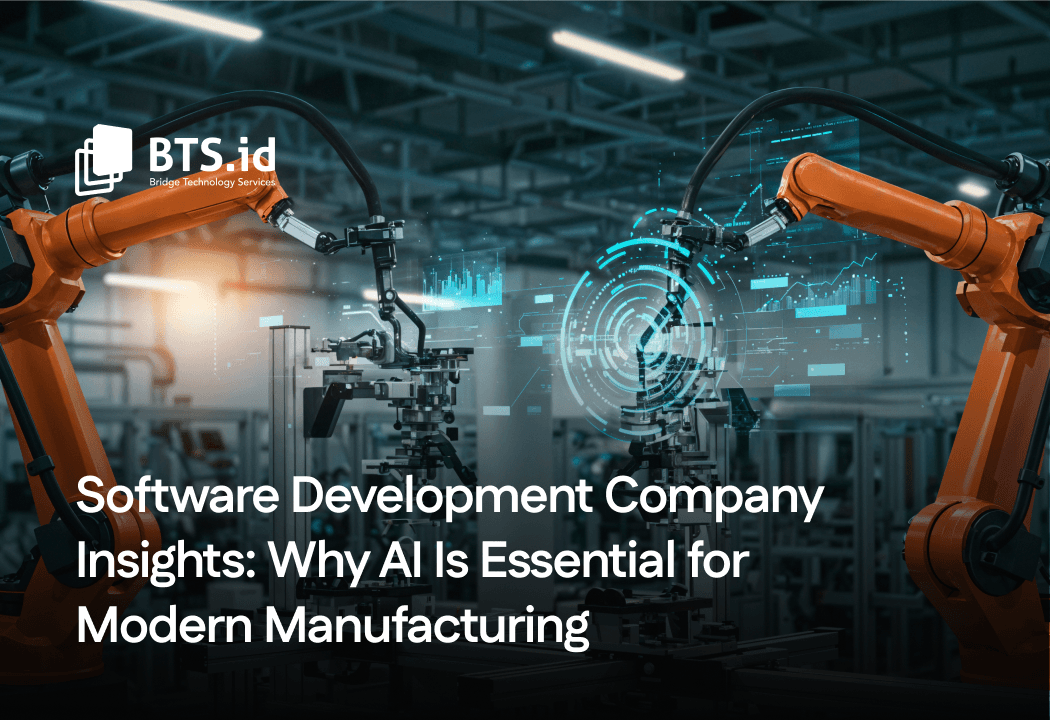
In today’s modern manufacturing landscape, software is a core driver of efficiency, integration, and innovation.
As a trusted software development company, we go beyond building technology, we act as strategic digital transformation partners for manufacturing businesses.
We design and develop custom software solutions tailored to manufacturing operations, including production systems, inventory management, machine integration, and real time data platforms. Our solutions are built to support industry 4.0 initiatives, AI-driven automation, and smart factory environments.
Unlike off-the-shelf software, our custom manufacturing solutions are flexible, scalable, and secure designed to adapt to evolving market demands and operational complexity. Software serves as the critical link between business processes, industrial machines, and data intelligence.
We help manufacturers transform complex operational challenges into reliable, measurable, and future-ready software systems that improve productivity, visibility, and long term competitiveness.

Key contributions of a software development company in modern manufacturing.
- Development of integrated systems such as ERP, MES, and supply chain management tailored to factory workflows.
- Implementation of IoT and AI for real time production monitoring, predictive maintenance, and machine performance optimization.
- Automation and data analytics that enable data-driven decision-making, reduce downtime, and improve product quality.
- System security and scalability to ensure manufacturing operations remain reliable as the business grows.
In modern manufacturing, software development is the core of digital transformation. Without software, digital transformation cannot succeed, as every process from production planning to decision making relies on integrated digital systems.
- Software Development as the Foundation of Digital Transformation
Digital transformation in manufacturing begins with system modernization through software, software enables the digitization of manual processes, cross department data integration, and real time operation visibility. Systems such as ERP, MES, and industrial data platforms form the core foundation of this transformation.
- Software as the Driver of Manufacturing Automation
Manufacturing automation does not rely solely on machines, but on software that controls, orchestrates, and optimizes automated processes. Software plays a key role in:
• Automatically controlling production workflows.
• Integrating machines, robots, and IoT sensors
• Enabling data driven quality control and maintenance.
Without the right software, automation cannot be efficient or scalable.
- Software as the Brain of Smart Factories
Smart factories represent the highest evolution of modern manufacturing, with software acting as the central brain. Through AI development, analytics, and real time monitoring systems, software enables factories to:- Predict machine failures through predictive maintenance.
- Adaptively optimize production processes
- Respond quickly to changing market demands.
- End to End Integration for Future Ready Operations
Custom software development connects the entire manufacturing ecosystem from supply chain and production to distribution into a single integrated system. This creates operations that are more agile, efficient, and prepared to meet future industrial challenges.
Digital transformation provides strategic direction, manufacturing automation delivers efficiency, and smart factories enable operational intelligence. Software development serves as the connecting element between all three, making it a key factor in the success of competitive and sustainable modern manufacturing.
The Rise of Artificial Intelligence in Manufacturing Processes
The manufacturing industry is undergoing a major transformation driven by the increasing adoption of artificial intelligence in manufacturing.
Artificial Intelligence (AI) is no longer merely supporting technology, it has become a core component in creating production processes that are more efficient, intelligent, and competitive.
From automation to data driven decision making, Artificial Intelligence (AI) is reshaping how factories operate in the modern industrial era. Artificial intelligence (AI) plays an increasingly critical role in manufacturing due to its ability to process large volumes of data, identify patterns, and make fast, accurate decisions.
Artificial Intelligence in Manufacturing: The Foundation of Smart Manufacturing
AI development in manufacturing is used to improve production efficiency, product quality, and operational reliability. By leveraging data from machines, sensors, and production systems, artificial intelligence enables manufacturers to analyze production data in real time, identify operational patterns, and continuously optimize processes.
With the right software support, AI development helps increase productivity, reduce human error, and maintain consistent product quality forming the foundation of smart, data-driven manufacturing operations.
Industrial AI Applications for Operational Efficiency
The application of AI in industry spans multiple areas, including:
- Production data analysis to increase output and reduce waste
- Computer vision for automated quality inspection
- Supply chain optimization and production planning
Today, a wide range of industrial artificial intelligence (AI) applications are being implemented across manufacturing environments, from production analytics and computer vision based quality inspection to supply chain optimization.
These applications enable manufactures to make faster, more accurate while simultaneously reducing operational costs. Compared to manual approaches, AI driven solutions deliver greater speed, precision, and consistency in operational decision making.
AI-Powered Production Lines: Adaptive and Flexible Manufacturing
AI-powered production lines can automatically adjust production speed, workflows, and operating parameters based on real time data. The result is a production process that is more flexible, consistent, and capable of responding to changing market demand without compromising product quality.
By adapting dynamically to machine conditions, market demand, and material availability, AI-powered production lines, supported by intelligent software, become more scalable, resilient, and ready to handle the rapid pace of modern industrial change.
Predictive Maintenance: Reducing Downtime with AI
One of the most significant benefits of AI development in manufacturing is predictive maintenance. By analyzing historical data and current machine conditions, AI can predict potential failures before they occur.
This approach helps manufacturers reduce unexpected downtime, lower maintenance costs, extend asset lifespan, and improve overall operational reliability.
The Role of a Software Development Company in AI Manufacturing
As a software development company, we design, develop, and integrate AI solutions tailored to manufacturing needs. From industrial data processing and custom AI system development to seamless integration with ERP and MES platforms, software plays a critical role in ensuring successful AI adoption in modern factories. The rise of artificial intelligence (AI) in manufacturing processes marks a major shift towards smarter, more efficient, and data driven factories.
Key benefits of Integrating AI with Manufacturing Systems
Integrating Artificial Intelligence (AI) with manufacturing systems has become a strategic move for companies aiming to improve operational efficiency and competitiveness. By leveraging AI-driven efficiency, automation and real time data analytics, modern manufacturing operations can become smarter, faster, and more accurate.
Some of the key benefits include:
- AI-Driven Efficiency in Manufacturing Process
The first key benefit is AI-driven efficiency, which enables manufacturing systems to automatically optimize production processes based on real time data. AI helps streamline workflows, reduce bottlenecks, and improve machine utilization. The result is higher productivity without the need for significant additional resources. - Cost Reduction Through Automation
One of the primary benefits of AI integration is cost reduction through automation. AI reduces reliance on manual processes, minimizes human error, and lowers operational costs. In addition, AI-powered automation helps manufacturers reduce downtime, material waste, and unplanned maintenance expenses - Improve Product Quality with AI
Another important benefit is improved product quality with AI development, achieved through consistent quality monitoring and analysis. Using technologies such as computer vision and machine learning, AI can detect product defects in real time and ensure quality standards are consistently met.
This leads to higher customer satisfaction while reducing defects and rework. - Real-Time Data Analytics for Faster Decision-Making
AI integration enables real-time data analytics that provide full visibility into production conditions.
Data from machines, sensors, and production systems are analyzed instantly to support faster and more accurate decision-making. With data-driven insights, manufacturers can proactively respond to issues and opportunities. - The Role of Software Development Companies in AI Integration
Software development companies play a critical role in integrating AI into existing manufacturing systems. Through custom solution development, ERP and MES integration, and the deployment of secure and scalable AI technologies, software developers ensure that AI delivers measurable and sustainable business impact.
Challenges and Considerations When Implementing AI Solutions
Although Artificial Intelligence (AI) offers significant benefits to the manufacturing industry, its implementation comes with various challenges. Understanding AI integration challenges, data security in manufacturing, effective change management, and workforce upskilling is essential to ensure that Ai adoption is successful and sustainable.
Here is a detailed explanations:
- AI Integration Challenges in Manufacturing Systems
One of the main challenges is integrating AI with existing manufacturing systems. Many companies still rely on legacy systems that were not designed to support modern AI technologies. Without proper software architecture planning, this integration can lead to technical complexity, operational disruption, and limited scalability. - Data Security in Manufacturing
AI implementation requires large volumes of data, including sensitive production and operational information. Data security in manufacturing environments is a critical concern due to the increasing risk of data breaches and cyberattacks. AI systems must be built with high security standards to protect data and ensure uninterrupted factory operations. - Change Management for Manufacturers
AI-driven transformation is not only a technological shift but also a cultural one. Change management becomes a major challenge for manufacturers accustomed to conventional processes. Without clear communication and a structured adoption strategy, internal resistance can hinder the successful implementation of AI. - Workforce Upskilling with AI
AI adoption demands new skills from the workforce. Workforce upskilling with AI is essential to ensure employees can work effectively alongside intelligent technologies. Training and skills development are required to help teams leverage AI optimally, rather than feeling threatened by automation.

Software development companies play a critical role in helping manufacturers overcome these challenges through artificial intelligence strategy planning, custom software development, secure system integration, and support for change management and technical training. This approach ensures that artificial intelligence (AI) is not only implemented, but also delivers real and measurable business value.
Implementing AI solutions in manufacturing requires technological readiness, strong data security, effective change management, and workforce development. With the right strategy and the support of an experienced software development company, these challenges can be transformed into opportunities to build smarter, more efficient, and future-ready manufacturing operations.
The Role of Software Development Companies in Enabling Smart Manufacturing
Smart manufacturing lies at the core of industry 4.0, where digital technologies, automation, and artificial intelligence (AI) are integrated to create intelligent and adaptive manufacturing processes. In this transformation, software development companies play a strategic role as key enablers, bridging business needs, technology, and factory operations.
As technology partners, software development companies do more than build applications. They help establish sustainable digital foundations. With expertise in software engineering, AI, and industrial system integration, software development companies ensure that smart manufacturing delivers tangible business value.
- Custom Software Solutions for Industry 4.0
Every enterprise manufacturing company has unique processes, challenges, and business objectives. Therefore, custom software solutions for Industry 4.0 are essential to the success of smart manufacturing. Software development companies design tailored solutions such as ERP, MES, and IoT platforms that align with factory workflows, ensuring systems are flexible, scalable, and future-ready. - Collaboration with Software Developers as a Key to Transformation
Smart manufacturing cannot be achieved through technology alone, it requires close collaboration with software developers. Through a collaborative approach, software development companies help manufacturers translate operational needs into integrated digital solutions that are easy for internal teams to adopt and scale. - End to End Automation Services for Integrated Operation
Software development companies provide end to end automation services, covering requirements analysis, system architecture design, software development, and machine and data integration. This end-to-end approach ensures manufacturing processes run automatically, efficiently, and seamlessly within a unified digital ecosystem. - Tailored AI Implementation Strategies for Manufacturing
Implementing Ai in smart manufacturing requires a precise and measurable strategy. Tailored AI implementation strategies enable manufacturers to adopt AI gradually, based on their technological and business readiness. Software development companies play a key role in identifying high-impact AI use cases such as predictive maintenance, quality inspection, and production optimization
The role of software development companies is crucial in enabling smart manufacturing. Through custom software solutions, strategic collaboration, end to end automation services, and tailored AI implementation, manufacturers can accelerate digital transformation and remain competitive in the industry 4.0 era.
Future Trends: How AI Will Continue to Shape the Manufacturing Sector
Artificial Intelligence (AI) will continue to be a key driver in the evolution of the manufacturing industry. As technology advances and efficiency demands increase, the future of smart manufacturing will rely even more
on the integration of AI, data, and intelligent digital systems.
Software development companies play a vital role in adopting and integrating future AI technologies into manufacturing systems. Through custom software development, AI and IoT integration, and future-ready system architectures, software development companies help manufacturers remain relevant, agile, and competitive in a rapidly evolving industrial landscape.
Below are key trends shaping the future of AI-driven manufacturing:
- Future of Smart Manufacturing
The future of smart manufacturing is defined by factories that are increasingly autonomous, connected, and adaptive. AI enables manufacturing systems to monitor, analyze, and optimize production processes in real time. With scalable software support, factories can respond to changes in market demand with greater speed and precision. - Emerging Technologies in Factories
A range of emerging technologies in factories will accelerate manufacturing transformation, including generative AI, digital twins, intelligent robotics, and edge computing. These technologies enable production process simulations, improved machine efficiency, and more accurate data-driven decision-making. - Industrial IoT and Machine Learning Trends
Trends in Industrial IoT (IIoT) and machine learning will further strengthen connectivity and intelligence within manufacturing systems. IoT sensors collect data from machines and production environments, while machine learning analyzes this data to identify patterns, predict failures, and optimize operational performance. - Adaptive Supply Chains Powered by AI
Ai will also shape adaptive supply chains that are more flexible and responsive. Through predictive analytics and AI-driven forecasting, manufacturers can manage inventory more effectively, anticipate supply chain disruptions, and rapidly adjust distribution strategies based on real-time market conditions.
Artificial intelligence (AI) will continue to shape the future of the manufacturing sector through smart factories, emerging factory technologies, the integration of IIoT and machine learning, and adaptive supply chains. With the right digital strategy and the support of a software development company, manufacturers can leverage these trends to create sustainable long term competitive advantage.

Conclusion: Leveraging Expert Software Development and Advanced AI for Competitive Advantage in Manufacturing
In the face of increasingly intense industry competition, enterprise manufacturing companies must position an
AI-driven innovation strategy at the core of their business transformation. The effective use of AI and software
development not only improves operational efficiency but also unlocks opportunities for continuous
innovation.
- AI-Driven Innovation Strategy as the Foundation of Competitiveness
An AI based innovation strategy enables manufacturers to optimize production processes, improve product quality, and accelerate decision making. With a well planned approach, AI becomes a key enabler for creating long term business value and market differentiation. - Choosing the Right Digital Transformation Partners
The success of digital transformation heavily depends on selecting experienced digital transformation partners. A software development company acts as a strategic partner, designing digital architectures, integrating AI into manufacturing systems, and ensuring solutions are scalable, secure, and future ready. - Staying Competitive Through Technology Adoption
In the Industry 4.0 era, staying competitive through technology adoption is no longer optional, it is essential. Manufacturers that proactively adopt AI, IoT, and automation technologies are better prepared to respond to market changes, supply chain disruptions, and evolving customer demands. - Next Steps Toward Smart Manufacturing Solutions
The next steps toward smart manufacturing solutions begin with assessing digital readiness, identifying high impact AI use cases, and collaborating with software development companies that understand industrial requirements. This phased approach ensures transformation efforts are effective and deliver measurable result
By combining expert software development capabilities with advanced AI technologies, enterprise manufacturing companies can build a strong and sustainable digital foundation. This is the key to achieving competitive advantage, driving innovation, and ensuring long-term relevance in the future of the manufacturing industry.
Ready to Accelerate Your Smart Manufacturing Journey?
Partner with us BTS.id an expert software development company to unlock the full potential of AI-driven manufacturing.
From custom software solutions to advanced AI implementation, we help you build scalable, secure, and futureready manufacturing systems.
Talk to our experts today, and take the next step toward smarter, more competitive manufacturing.

In 2026, software development companies are positioned at the forefront of rapid digital innovation, playing a critical role in shaping how modern businesses operate and compete. As organizations encounter increasingly complex operational challenges and significantly higher user expectations, we are witnessing a major shift toward solutions that are not only smarter and faster, but also deeply integrated across ecosystems.
Generative AI is redefining how applications are built and optimized, cloud-native architecture ensures unmatched flexibility and scalability, hyperautomation streamlines processes end-to-end with unprecedented efficiency, and zero-trust security has become a non-negotiable requirement in protecting digital assets.
For software development companies, 2026 tech trends are more than just technological advancements, they represent a new standard in delivering value.
Clients now expect digital products that can evolve quickly, integrate seamlessly, and withstand constant security threats. This places development teams in a strategic position, not only to adopt new technologies, but to proactively guide businesses through digital transformation, helping them build future-ready systems that accelerate growth, improve resilience, and maintain a competitive edge in an ever-changing landscape.
The 2026 tech trends will have a significant impact on the evolution of software development.
The evolution of software development is a journey from the early days of computers to the modern era, marked by technological advancements and paradigm shifts. It refers to how the processes, technologies, and methods of software creation have continuously changed over time.
From writing machine code directly, it progressed to high-level programming languages, and now it is moving toward faster methodologies like Agile and DevOps, while integrating advanced technologies such as AI/ML, microservices, and low-code/no-code platforms.
The evolution of software development is closely linked to digital transformation, with both driving each other. Digital transformation requires companies to accelerate innovation, automate processes, and provide better digital experiences. To meet these demands, software development must evolve to become faster, more flexible, and smarter.
The digital transformation that necessitates software evolution will impact technological advancements such as AI, machine learning, cloud computing, IoT, robotics, and automation. These advancements make business processes faster, more efficient, smarter, and more connected. Companies can create new products, enhance services, and respond to market changes more effectively. Technological progress is a key driver of both digital transformation and the evolution of software development.
Some of the 2026 tech trends, which represent the latest custom software developments that every company should know in 2026, are:
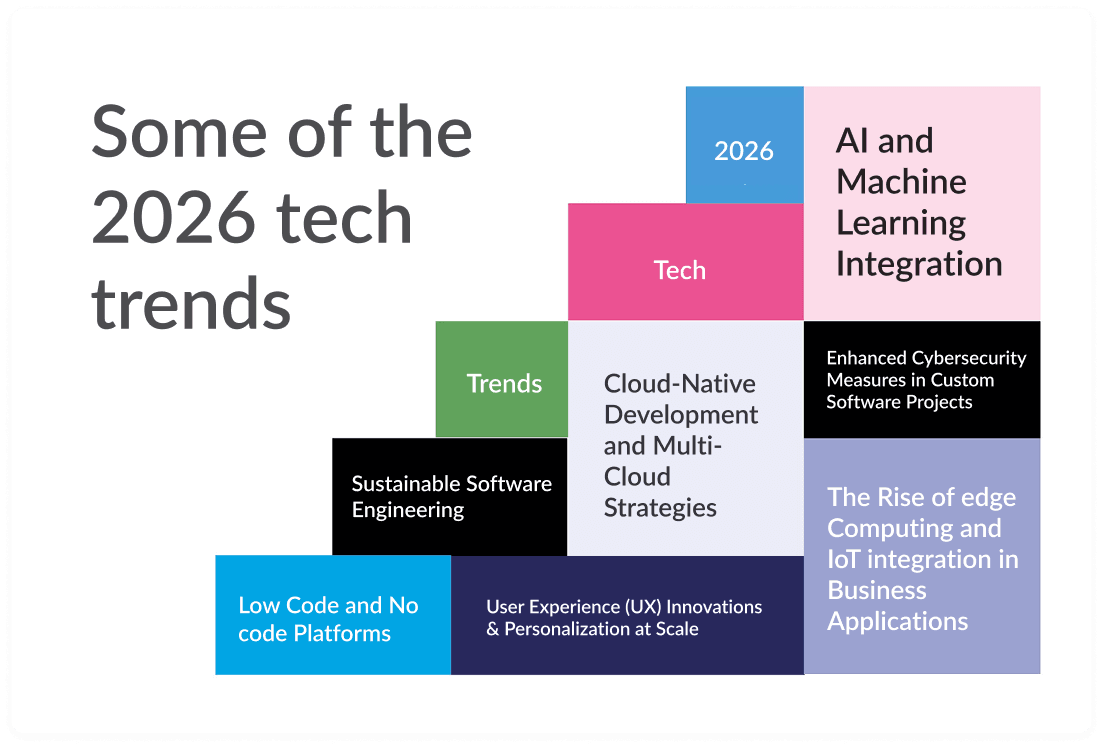
- AI and Machine Learning Integration: Shaping the Future of Custom Solutions
The integration of AI and machine learning into custom software solutions enables systems to become smarter, more automated, and capable of learning from data. This represents a transformative trend in the technology industry, where Artificial Intelligence (AI) and Machine Learning (ML) are no longer just additional features but core components of custom-designed software solutions tailored to meet specific business needs.
With these technologies, applications can:
• Predict user needs,
• Automate complex processes,
• Provide real-time recommendations,
• Improve the accuracy of business decisions.
Overall, AI and ML are shaping the future of custom solutions by delivering software that is more personalized, efficient, adaptive, and data-driven, making businesses more competitive in the digital era.
The four elements that from the core, mutually supportive components in AI and machine learning integration are as follows:- AI in Custom Software
Provides intelligence to applications, enabling software to understand context, analyse data, and respond intelligently. - Machine Learning Applications
Allows software to learn from data continuously improve accuracy and performance over time. - Intelligent Automation
Automate processes with AI/ML-based decision-making capabilities, rather than merely following static rules. - Predictive Analytics
Use ML algorithms to predict trends, risks, and future needs, making software more proactive.
- AI in Custom Software
- Low Code and No code Platforms: Accelerating Application Delivery
Low code and no code platforms are technologies that enable application development with minimal coding (low code) or even no coding at all (no code). These technologies will become highly important in 2026 as businesses increasingly demand applications that are fast, flexible, and easily customizable.
These platforms help businesses accelerate innovations, improve internal processes, and respond to market needs without waiting for lengthy development projects. In short, low code/no code offers an effective way to speed up application delivery in the 2026 era.
In shaping the modern application development ecosystem in 2026, there are four related elements:- Low Code Platforms 2026: Low code platforms provide visual tools and ready-to-use components, allowing developers to write minimal code. By 2026, these platforms will become the standard for accelerating enterprise software projects.
- No Code App Builders: Used by non-technical users to create applications without coding. They are an essential part of the low code/no code trend, expanding internal innovations capabilities within companies.
- Rapid Application Development (RAD): Low code and no code directly support RAD, a methodology focused on building applications very quickly, with instant prototyping and rapid iteration.
- Citizen Developers: These are users who leverage no code or low code to build applications, including:
• Operational staff,
• Marketing,
• Finance,
• HR.
• Product managers.
They can create their own solutions without waiting for the IT team.
These four elements accelerate innovation together, reduce the developer’s workload, and enable companies to release applications faster in 2026.
- Cloud-Native Development and Multi-Cloud Strategies
Cloud native development is an approach to building applications directly in the cloud environment using technologies such as microservices, containers, and serverless computing. This approach makes applications more scalable, faster, and easier to update.
Meanwhile, multi cloud on a single vendor, increase flexibility, and ensure systems remain operational even if one service experiences downtime.
Both trends are important in 2026 because they help companies build applications that are more resilient, efficient, and ready to grow in line with modern business needs.
The four interconnected components that form a modern cloud modernization ecosystem in 2026 are:
• Cloud Native Apps: A new way to build modern applications.
• Serverless Architecture: A part of cloud native that makes development more efficient.
• Multi Cloud Solutions: A deployment strategy that maximizes flexibility and resilience.
• Cloud Migration Trends 2026: The main driver prompting companies to adopt cloud native and multi cloud models.
These are key pillars that help businesses build applications that are more scalable, flexible, and future-ready in the 2026 era.
- Enhanced Cybersecurity Measures in Custom Software Projects
In 2026, security will be a top priority in custom software development. Companies are increasingly implementing advanced protections such as end-to-end encryption, multi layer authentication,
AI-based threat detection, and compliance with global standards. The goal is to protect sensitive data, prevent cyberattacks, and ensure applications are secure from design through deployment.
The following four key components are the main focus for modern companies:- Cybersecurity Best Practices 2026
The latest standards, such as zero trust, AI-based threat detection, end to end encryption, and continuous monitoring, ensure applications remain secure against evolving to achieve. - Secure Software Development Lifecycle (SSDLC)
Security is integrated into every stage of development. With SSDLC, vulnerabilities can be identified faster, mitigation costs are lower, and compliance is easier to achieve. - Data Privacy Regulations
Global and regional regulations require companies to handle data securely and transparently.
This drives the implementations of privacy by design, strict access controls, and regular audits in custom software. - Threat Detection Tools for Custom Solutions
AI/ML based tools help detect anomalies, block threats in real time, and provide proactive protection against modern attacks.
In 2026, security must be a foundational element of custom software development. By combining best practices, SSDLC, privacy compliance, and threat detection technologies, companies can build secure, modern solutions ready to face the risks of the digital world.
- Cybersecurity Best Practices 2026
- The Rise of Edge Computing and IoT integration in Business Applications
Edge computing processes data directly on devices or near the source, rather than in the cloud, making applications faster, more responsive, and efficient. When combined with IoT (Internet of Things), businesses can manage smart devices, sensors, and machines in real time.
This trend is important in 2026 because it helps companies enhance automation, accelerate decision making, and create smarter, more connected business applications.
• Edge computing trends 2026: Data processing closer to devices for high speed and efficiency.
• IoT-enabled solutions: Interconnected smart devices and sensors supporting business automation.
• Real-time data processing: Businesses can make instant decisions through rapid analytics at the edge.
• Connected devices integration: Integrating various devices for smarter, more responsive operations.
Edge computing accelerates data processing, IoT provides a network of data generating devices, and their integration allows companies to create smarter, more responsive, and scalable applications. The year 2026 will be an era where businesses rely on these technologies to improve efficiency, automation, and real time decision making capabilities.
- User Experience (UX) Innovations and Personalization at Scale
In 2026, UX innovation is no longer just about attractive design, but about how applications deliver truly relevant experiences for each user. Technologies such as AI, machine learning, and data analytics enable companies to create personalization at scale without compromising performance.
UX innovations provide more intuitive interfaces, adaptive navigation, and more human-like interactions.
Meanwhile, personalization at scale uses real time data to automatically tailor content, recommendations, and features to the needs of each user.
• UX design trends 2026 drive applications to be more intuitive, minimalist, and responsive, focusing on user comfort.
• Personalized user interfaces for custom apps leverage AI and real-time data to display content, recommendations, and layouts tailored to each user’s needs.
• Customer-centric development strategies ensure the entire development process focuses on the user experience, aligning personalization with UX innovation.
These elements create custom applications that are more personal, relevant, and satisfying, serving as a key business differentiation in 2026.
- Sustainable Software Engineering: Green IT Initiatives Gaining Momentum
Sustainable software engineering is an approach to custom software development that focuses on energy efficiency, reducing carbon, footprints, and using more environmentally friendly resources. By 2026, more companies are adopting Green IT initiatives such as optimizing cloud infrastructure, writing energy efficient code, and designing efficient architecture to reduce power consumption.
The goal is to create software that is lighter, more efficient, and sustainable, while supporting corporate environmental targets.
• Sustainable software practices 2026: Focus on reducing carbon footprints and improving energy efficiency in application development.
• Green coding techniques: Writing lightly, resource efficient code that minimizes computational waste.
• Energy efficiency application design: Application architectures that optimize the use of servers, cloud resources, and devices.
The practices create software that is more efficient, environmentally friendly, and sustainable.
- Navigating Regulatory Compliance in a Changing Digital Network
In the 2026 tech trends, companies must adapt to new regulations related to data, security, and privacy. Software development now needs to consider standards such as GDPR, PDPA, HIPAA, or other local regulations.
The goal is to ensure applications are secure, legally compliant, and able to adapt to continuously evolving regulations, helping businesses avoid legal risks and data breaches.
• Software compliance requirements 2026: The latest software compliance requirements in 2026 demanding stricter security, privacy, and data management.
• GDPR updates for developers: GDPR updates that developers must understand to ensure applications comply with privacy standards and user data protection.
• Industry specific regulations for bespoke software: Industry specific rules (healthcare, finance, government, etc) that must be applied in custom software.
Together, these form a modern compliance framework that companies must follow to keep custom software secure, legal, and regulation-ready in constantly changing digital work.

To face 2026, companies need to embrace innovation to stay relevant and competitive. Future-proofing your business with 2026 tech trends means preparing your business by following trends such as AI, cloud native, IoT, and modern cybersecurity, making systems more adaptive and ready for rapid changes.
Meanwhile, staying competitive through innovation adoption emphasizes the importance of strategically adopting new technologies not just following trends, but truly integrating them into business processes and software development.
The outcome is that organizations can build smarter, more efficient, and sustainable custom solutions while maintaining a competitive position in an increasingly dynamic digital era.
Digital transformation is no longer optional. It is a necessity.
With the latest trends such as AI/ML, cloud-native, low-code/no-code, and modern cybersecurity, companies ready to innovate will lead the market.
Take the first step now: contact our team at BTS.id for strategic consultation and discover how custom software solutions can support your company’s sustainable business growth.
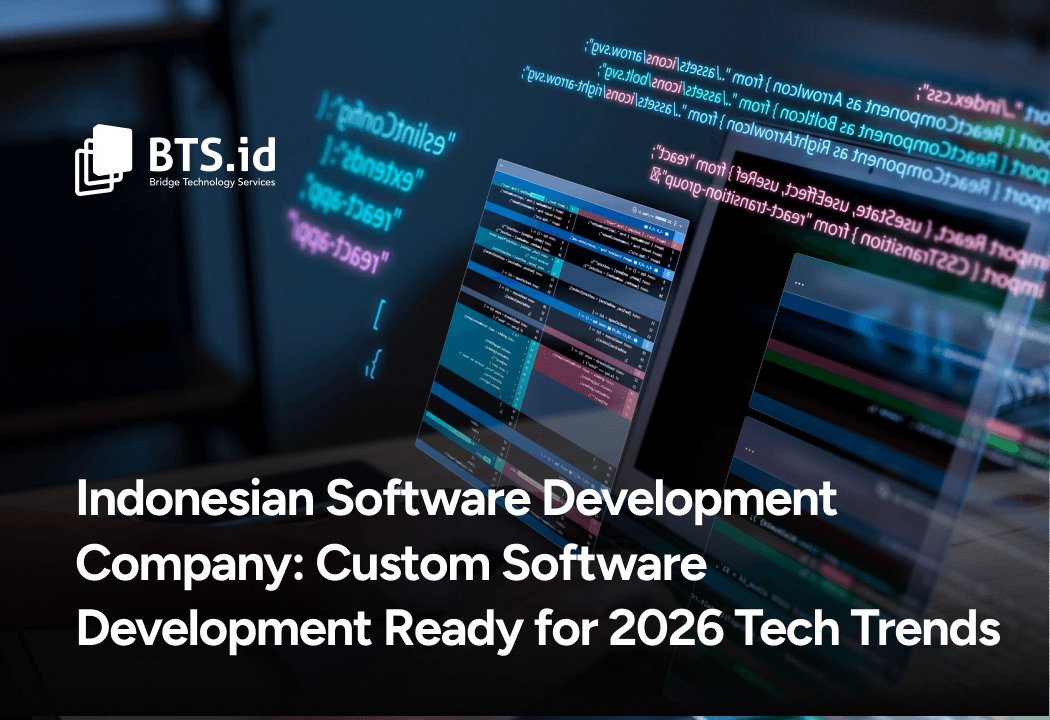
Entering 2026, artificial intelligence (AI) continues to evolve from merely a supporting tool into a core foundation of global digital transformation that Software development companies must certainly adapt to this 2026 tech trend. Development such as generative language models, intelligent process automation, more efficient machine learning, and AI’s growing ability to understand context are becoming increasingly mature.
The Evolution of AI towards 2026 is making artificial intelligence increasingly smarter, autonomous, and integrated into nearly every business process, from automation and analytics to decision making. What once considered an experimental technology has now become the backbone of digital strategies across companies, public institutions, and research organizations. AI applications are now present in nearly every domain, from customer communications and process automation to executive-level decision making support.
AI is no longer making processes longer only, it is beginning to shape how businesses make decisions, innovate, and create more personalized customer experiences.
This directly impacts how software development companies operate, the service they offer, and the value they deliver to clients.
Some of these impacts include:
- Building software that is already prepared for and compatible with AI technologies
- Accelerating development processes using AI-powered tools
- Offering AI solutions to clients (chatbots, automation, data prediction)
- Ensuring software architecture is flexible and scalable for future

Some of the key drivers behind the 2026 AI development trends are:
- Machine Learning
In this case, advancements in machine learning are the primary force behind AI development trends in 2026. Larger, more efficient ML models that can understand various types of data (text, images, audio, video) will make AI in 2026:
• Smarter and more versatile
• Able to run on small devices (edge all)
• Cheaper and faster to use
• Increasingly automated through AI agents
• Safer and more transparent due to a stronger focus on Responsible AI
The advancement in Machine Learning today shapes how AI will work, evolve, and be utilized in the 2026 tech trend.
- Predictive Analytics
Predictive analytics is a key driver of AI trends in 2026 because it enables AI to automatically predict behaviors, needs, and risks. This makes systems more proactive, quicker in decision making, and capable of working in real time.
For software development companies, this capability is crucial because businesses increasingly need applications that can provide automatic recommendations, predict demand or risks, and optimize processes based on data.
In short, predictive analytics is the foundation of AI in 2026, and software development companies have to be able to integrate it so their products remain relevant and competitive.
- Software Development Innovations
Software development innovations are closely tied to AI trends in 2026, as the software development process is becoming increasingly automated, faster, and smarter thanks to AI development. Applications being built must also be AI-ready and easy to integrate with analytics, automation, and AI models.
For software development companies, this means they have to use AI to accelerate coding and testing, build applications that are ready for AI integration, and offer AI-based solutions to remain competitive.
Software development innovation is being driven by AI in 2026, and software companies need to adapt, or risk being left behind.

Businesses need AI to operate faster and smarter, which means they require custom software and enterprise applications built with AI features such as prediction, automation, and analytics. From this need, automation tools emerge to simplify operational processes.
All of this has become an essential part of digital transformation strategies, as companies shift toward more efficient, data driven systems that are ready for the future.
Several related elements, AI integration in business, custom software development, enterprise AI apps, automation tools, and digital transformation strategies, are interconnected as a unified technology ecosystem in 2026.
- AI Integration in Business
AI integration becomes the main foundation for businesses in 2026.
Businesses need AI to:
• Increase efficiency
• Gain deep insights from data
• Enable automated decision-making
This drives the demand for software that is AI-ready.
- Custom Software Development Solutions
Because every business has unique needs, companies require custom software development that:
• Supports AI
• Can process real-time data
• is scalable for future technologies
This means software development companies have to build solutions that are natively AI-ready.
- Enterprise AI Apps
Large companies no longer want ordinary applications, they want enterprise-grade apps equipped with
AI capabilities, such as:
• Predictive analytics
• Process automation
• Intelligent recommendations
• Real-time monitoring
• AI agents for daily operations
All of these become part of custom enterprise solutions.
- Automation Tools
Automation tools are a direct result of AI integration.
In 2026 tech trend, automation tools include:
• Workflow automation
• Customer automation
• Operational automation
• Software development automation (AI coding/test)
These innovations increase productivity and operational efficiency for businesses.
By 2026 tech trend, Artificial Intelligence (AI) is predicted to become an essential foundation in core business operations, no longer just an auxiliary tool. Its main impacts will include increased efficiency, smarter datadriven decision-making, and fundamental transformation of business models. The year 2026 is expected to be a turning point for companies that integrate AI into their core strategies. The following trends are likely to determine success or failure in future business competition.
- Generative AI and Multimodality
Generative AI is no longer limited to producing text, it can now generate images, video, audio, and various other types of output within a single system (multimodal), while also leveraging synthetic data and simulations for product development and testing. This technology has a significant impact on businesses, from accelerating and personalizing marketing content, simplifying prototyping and market testing through synthetic data, to creating more immersive customer experiences.
- Edge AI & Smart IoT
Edge AI is the process of performing artificial intelligence computations directly on local devices such as sensors, cameras, or IoT devices, instead of always relying on the cloud, by leveraging advanced sensors and low-latency networks. This enables real-time response, reduces bandwidth and communication costs, and enhance data privacy and security since data does not need to be transmitted off the device
- AI Infrastructure Focused on Inference
This shift marks a move from heavy investment in training AI models to leveraging pre-trained models for continuous, real-time predictions. The inference process becomes a critical part of daily business operations, from serving users and processing transactions to running automation and responding to customers, where performance, speed, and cost efficiency heavily depend on how this process is managed.
- Process Automation and Collaborative AI Agents
Intelligent automation, which combines RPA (Robotic Process Automation) and AI with support from multi-agent systems capable of collaborating to complex workflows automatically, is applied across various business functions such as back-office operations, finance, logistics, inventory, and document processing, as well as customer service through AI agents. These agents can understand context from multiple data sources, take action, and coordinate across modules such as chatbots, voice systems, and recommendation engines.
- Focus on Cost Efficiency and AI ROI
This trend arises because many companies have adopted AI but have yet to achieve optimal results. As a result, business focus is now shifting toward measuring ROI and creating real value through targeted strategies, such as starting with pilot projects before scaling, applying AI to areas with the greatest challenges, and optimizing operational efficiency through automation of repetitive tasks.
Industry specific artificial intelligence (AI) applications are revolutionizing various sectors by providing tailored solutions for specific challenges, enhancing operational efficiency, and driving innovation. These advanced AI solutions from predictive maintenance in manufacturing to faster medical diagnostics in healthcare are fundamentally changing the way businesses operate.
This means that more sophisticated AI technologies are being applied specifically across industries to improve efficiency, productivity, and innovation.
Example include:
- Healthcare: AI assists in faster diagnoses, reading medical scans, and predicting diseases.
- Finance: AI is used for fraud detection, risk analytics, and customer service automation.
- Retail: AI development predicts demand, personalizes product recommendations, and optimizes inventory management.
- Manufacturing: AI automated productions, monitors machinery, and prevents breakdowns (predictive maintenance)
- Transportation & Logistics: AI plans optimal routes, predicts delivery needs, and supports autonomous vehicles.
- Education: AI enables adaptive learning tailored to each student’s needs.
AI is not only used in general applications but is also customized for the specific needs of each industry, driving significant transformations in how these sectors operate.

The adoption of next generations AI, especially generative AI, brings significant challenges related to security and ethics. Addressing these challenges is crucial to ensure responsible and sustainable use of the technology.
In other words, it involves examining the challenges companies or industries face when adopting the latest AI technologies, particularly concerning security and ethics.
- Security
The cybersecurity landscape is entering a new phase, much faster, more ruthless, and uncompromising.
While a few years ago organizations felt safe with monthly patch schedules, today that pace is no longer sufficient.
The speed of attacks surpasses what humans can counter, and by 2026, analysts predict this trend will reach its peak, ushering in an era of machine-speed security. Next generation AI introduces risks such as:
• Leakage of sensitive data
• Cyberattacks leveraging AI
• Model manipulation (e.g., data poisoning)
• Use of AI without strong privacy safeguards.
Companies must ensure that AI is safely deployed and that data is protected.
- Ethics (Ethical Considerations)
Ethics is a set of moral principles that help us distinguish right from wrong. AI ethics is a multidisciplinary field that studies how to maximize the beneficial impact of AI while minimizing risks and harmful outcomes.
Ethical use of artificial intelligence (AI) means ensuring that it is developed and applied responsibly to support humanity, respect human dignity and rights, and minimize risks of discrimination and misuse.
Ai must be used responsibly, including:
• Avoiding bias in algorithms
• Ensuring AI decisions are explainable (explainable AI)
• Maintaining transparency in how AI operates
• Ensuring AI does not harm users
• Complying with global ethical standards and regulations
- Responsible AI Implementation in Business Operations
Implementing AI responsibly requires a strategic approach focused on ethics, transparency, and risk mitigation. The key strategies include developing a clear ethical framework, ensuring transparency and accountability and prioritizing data security and privacy.
To use AI safely, ethically, and effectively, businesses should adopt the following strategies:- Transparency & Explainability
Ensure AI operations are explainable (explainable AI) so that AI decisions can be understood by internal teams and customers. - Data Protection & Privacy
Apply high security standards, encryption, and clear privacy policies. User data must be safeguarded against misuse. - Bias Elimination
Regularly audit AI models to ensure they do not introduce biases against customers or specific groups. - Regulatory Compliance
Ensure AI adheres to laws and regulations, such as data protection, AI ethics, and applicable industry standards. - Human-in-the-Loop
Maintain human involvement in critical decision making to avoid full dependence on AI. - Continuous Monitoring & Evaluation
Continuously monitor AI performance to detect errors, anomalies, or data changes that may affect outcomes. - Ethical Data Usage
Only use data obtained lawfully and with clear consent. - AI Systems Security
Protect models from threats such as data manipulations attacks, model hijacking, and unauthorized access.
- Transparency & Explainability
Preparing Your Business For the Future Through AI-Driven Software Integration
Integrating artificial intelligence (AI) into your software solutions is a strategic step toward achieving efficiency, innovation, and competitive advantage.
Future-Ready Business Strategies with AI Solutions
This means designing company plans and operations that leverage AI to address technological changes, evolving customer needs, and market dynamics in the coming years. With AI development, businesses can automate operational processes, making work faster and more efficient. AI also supports more accurate decision-making through predictive analytics and real-time data. From the customer perspective, AI enhances experiences by providing faster, more personalized, and relevant services.
Additionally, AI solutions open opportunities for new product and service innovations that create added value for the company. The technology also strengthens business resilience by predicting risks, detecting anomalies, and helping companies adapt more quickly to market changes. Overall, AI-driven strategies help businesses remain relevant, competitive, and ready for the digital future.
Digital Competitiveness through AI Adoption by Software Companies
This refers to a company’s ability to gain a market edge by leveraging AI in their products, services, and internal processes. By integrating AI, software companies can build smarter, more efficient, and automated solutions from data-driven applications and predictive analytics systems to automation platforms that enhance client productivity.
AI also accelerates innovation, enabling companies to respond to market trends faster and create more relevant products. Additionally, using AI in internal processes such as software development, automated testing, and bug detection improves product quality while reducing operational costs. Overall, AI adoption becomes a crucial foundation for software companies to remain competitive, attract more customers, and lead in the era of digital transformation.
Preparing for Technological Disruption in Business Operations
This means ensuring that companies are ready to adapt when new technologies emerge that significantly change workflows, operational processes, and business models. Technological disruption such as AI, automation, IoT, and machine learning can accelerate processes, reduce costs, or even replace outdated and efficient methods.
To navigate these changes, businesses need flexible systems, a willingness to innovate, and enhanced digital capabilities within their teams. Companies must also leverage new technologies to optimize workflows, mitigate risks, and improve customer service. With this readiness, businesses can not only survive amidst change but also capitalize on new opportunities and strengthen their competitive position in the market.
In the era of the 2026 AI Revolution, technology is evolving at an unprecedented pace, and businesses are required to adapt faster than ever. Partnering with a visionary software development company is a strategic move, as they possess the expertise to effectively integrate AI into your systems, products, and business operations.
Innovative development companies not only understand the latest AI trends but can also design solutions that are scalable, secure, and aligned with industry needs. With their support, businesses can accelerate digital transformation, increase efficiency, create better customer experiences, and unlock new growth opportunities.
Ultimately, such partnerships help companies not just survive technological change but lead the competition and thrive in an increasingly complex digital landscape.
Looking for higher efficiency, intelligent automation, and competitive advantage?
Start your AI journey with us BTS.id team. Let's create AI solutions tailored to your business needs. Consult your project today with our BTS.id team.
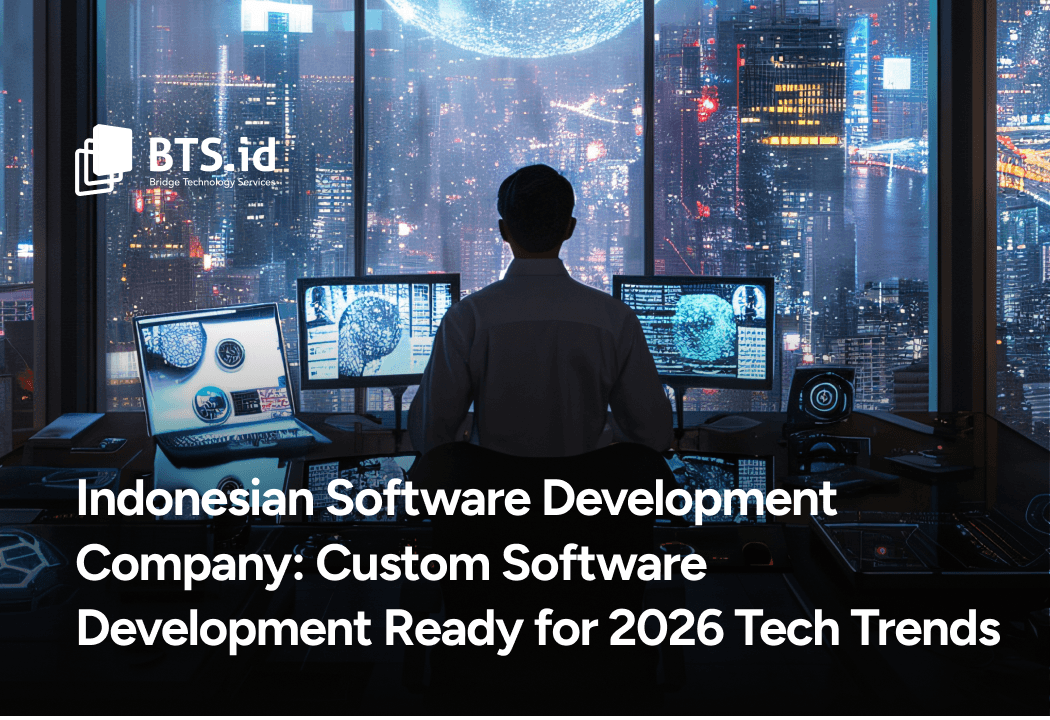
New year brings new challenges and new enthusiasm for business and technology players who must keep pace ever-evolving innovations. This is especially true for software development companies, where custom software development must continuously adapt to emerging technology trends to stay relevant and support faster business processes in the digital era.
Technological progress toward 2026 is accelerating rapidly, driven by the rise of autonomous artificial intelligence (AI), enhanced connectivity, and the convergence of multiple innovations. As 2026 approaches, the technology landscape continues to evolve at an unprecedented pace. According to 2026 tech trend reports, the rapid advancement of new technologies in the coming decade promises a revolution across all sectors.
Instead of progressing gradually, these changes will occur exponentially, where each technological breakthrough fuels further innovation across industries. From artificial intelligence (AI) to the interconnectivity of the Internet of Things (IoT), these trends hold immense potential to revolutionize industries and enhance the overall quality of life, reshaping the way we live, work, and interact with the world around us.
Let's examine some key aspects that illustrate the rapid development of technology towards 2026:

- Voice and Conversational AI
AI technology is now taking the lead in the tech world. Beyond professional applications, AI has become both a shortcut and a trend in everyday life. Its human-like nature and ability to adapt to user needs make AI an effective time saving tool. This early advancement is set to become a major breakthrough in 2026, evolving into intelligent virtual assistants for businesses.
Some examples include:
• Acting as customer service agents to handle basic inquiries or complaints.
• Assisting with office tasks such as data analysis, summaries, and conclusions.
• Taking meeting notes.
• Generating ideas and supporting brainstorming sessions.
• Developing into voice bots for automated communication.
Therefore, integrating voice and conversational AI is highly recommended as part of your company’s digital transformation strategy for 2026.
- Personalized Marketing with AI
CRM (Customer Relationship Management) applications are already widely used across many companies. With the advancement of AI technology in 2025, CRM systems can now be integrated with AI to further accelerate business processes.
Some of the key benefits include:
• Analyzing customer behavior based on purchase history and search patterns.
• Providing customer preferences through predictive insights.
• Helping marketing and sales teams focus on the hottest leads for retargeting.
By adopting this 2026 tech trend, your marketing and sales teams can focus more strategy, communication, and direct customer engagement, enabling smarter and more personalized business growth.
- AIoT (Integration of AI + IoT)
The Internet of Things (IoT) connects electronic devices to the internet, making it easier for people to interact with technology in their daily lives. Examples include smartwatches, CCTV cameras that can be monitored remotely, and automatic light sensors that turn on at night.
By 2026, combining IoT with AI will significantly enhance its capabilities, making business operations smarter and more efficient.
When your company adopts AIoT, it becomes easier to monitor systems remotely and perform multitasking, as real-time alerts will automatically notifications whenever an issue arises. This integration not only improves efficiency but also helps organizations respond proactively to challenges in their operations.
- Trying Virtual Products with AR (Augmented Reality)
The rise of e-commerce has successfully transformed traditional shopping experiences that once required customers to visit stores and try products in person. Today’s e-commerce platforms offer a variety of features from customer reviews and package tracking to live streaming that allows real-time interaction between buyers and sellers.
Although Augmented Reality (AR) is not a new feature, only a few brands have adopted it so far. In fact, AR can significantly enhance user experience by allowing customers to virtually try products before purchasing, a key step that brings them closer to making a buying decision.
By implementing AR, businesses can not only improve customer satisfaction but also boost engagement and conversion rates in an increasingly competitive digital marketplace.
- Cybersecurity in a Hyperconnected World: Emerging Threats and Evolving Solutions
As our reliance on technology grows and the world becomes increasingly interconnected, the need for robust cybersecurity solutions has never been more critical. By 2026 tech trend, we can expect a significant rise in sophisticated cyberattacks targeting critical infrastructure, businesses, and individuals.
Some key impacts and solutions include:
• Cybersecurity Investment: Companies and governments must prioritize investment in advanced cybersecurity measures.
• AI-Powered Threat Detections: Implement AI-driven systems to detect and respond to threats in real-time.
• Zero-Trust Security Model: Adopt a zero-trust framework to minimize vulnerabilities across systems.
• Individual Awareness: Encourage individuals to protect their personal information online.
• Safe Digital Hygiene: Promote secure digital practices as part of everyday online behavior.
In this hyperconnected era, cybersecurity is not just a technical necessity, it’s a strategic foundation for building trust, ensuring resilience, and protecting the digital future.

In the rapidly evolving digital era leading up to 2026, technology has become the core foundation for every company striving to survive and grow. Amid these transformations, custom software development emerges as a key element for global businesses seeking to stay competitive.
Unlike off-the-shelf software, which offers generic functionalities, custom software is specifically designed to match each organization’s unique needs, workflows, and goals.
This tailored approach enables companies to build systems that fully support their strategy and long term vision.
One of the main advantages of custom software development lies in its flexibility and efficiency. Every feature can be customized to fit internal workflows, helping to streamline processes, reduce errors, and boost team productivity. Moreover, custom software can be seamlessly integrated with existing systems, creating a more unified and efficient digital ecosystem.
Beyond improving efficiency, custom software development also helps organizations enhance productivity by automating critical processes. Smooth system integration allows business to create a connected digital environment, strengthening collaboration and enabling faster, data-driven decision making.
From a security and scalability perspective, custom software gives companies full control over their systems.
Solutions can be designed to meet strict security standards and developed to grow alongside the business without disrupting ongoing operations.
Moreover, custom software development opens significant opportunities for innovation. By creating unique features and distinctive user experiences, businesses can establish a competitive advantage that is difficult for competitors to replicate.
Software development companies in Indonesia are now in a unique and strategic position to deliver futureready solutions. With a combination of highly skilled tech talent, competitive development costs, and deep understanding of global market needs, Indonesia has emerged as one of the most promising digital innovation hubs in Southeast Asia.
Supported by advances in digital infrastructure and the growing adoption of technologies such as AI, IoT, Cloud Computing and Data Analytics, software development companies in Indonesia are able to deliver solutions that are not only aligned with current business needs but also robust and adaptive to future technology trends.
An approach focused on collaboration, flexibility, and innovation makes Indonesian software developers ideal partners for global companies looking to accelerate their digital transformation with efficient, secure, and sustainable solutions.
Evolutions from Standard Software to Personal, Adaptive, and Scalable Systems
Rapid technological advancements have driven a major transformation in the world of software development.
While companies once relied heavily on generic, off-the-shelf software, the trend has now shifted toward more personalized, adaptive, and scalable solutions tailored to modern business needs.
Here are some stages of this evolution:
- From General Solutions to Greater Flexibility
Initially, standard software was chosen because it was easy to implement and had a relatively low upfront cost. However, as businesses grow and operational complexity increases, many organizations realize that generic solutions are no longer sufficient. Limitations in flexibility and customization lead companies to seek approaches that better align with their specific needs.
- Personalization as a Key Value Add
The rise of custom software development addresses this challenge. Each feature and module is designed to support a company’s unique workflows and strategies. This approach provides added value through higher efficiency, as the system is fully aligned with the organization's internal processes.
- Adaptability to Respond to Change
In a constantly evolving business environment, whether in terms of market trends, regulations, or technology, adaptability is a key factor. Adaptive systems allow companies to adjust to new developments without undergoing major overhauls, making the organization more resilient and ready to face technological disruptions.
- Scalability for Long-Term Growth
Sustainable business growth requires scalable systems. This means the system can expand alongside increasing users, data, or new features without compromising performance. Such an approach allows companies to broaden their business reach without the need to replace the entire digital infrastructure.
- Towards Intelligent and Integrated Systems
The next stage of this evolution is the creation of smarter, integrated systems that leverage technologies like AI, IoT, cloud computing, and data analytics. Software is no longer merely an operational tool but a strategic foundation that drives innovation, efficiency, and data-driven decision-making.
In this fast-paced digital era, businesses can no longer rely on traditional, stand-alone systems. Integration with modern technologies such as artificial intelligence (AI), cloud services, and real-time analytics is now a key requirement for maintaining competitiveness and operational efficiency.
Here’s the explanation:
- Artificial Intelligence (AI) for Smarter Decision-Making
AI has transformed the way companies operate by delivering automation and data-driven insights.
Through machine learning and predictive analytics, businesses can understand customer behaviour, predict market trends, and optimize internal processes. AI integration helps companies make faster and more accurate decisions, while reducing reliance on manual processes.
- Cloud Services for Flexibility and Efficiency
Cloud computing provides incredible flexibility for modern businesses. With cloud-based systems, companies can store, manage, and access data or applications from anywhere, regardless of device or location. In addition to reducing infrastructure costs, cloud services also enable real-time cross-team collaboration and easy scalability as the business grows.
- Real-Time Analytics for Rapid Response
In a competitive business world, real-time data is a critical asset. Integration with real-time analytics systems allows companies to monitor performance, customer behaviour, and market conditions in realtime, enabling them to respond quickly to changes. This approach helps companies make more relevant and targeted data-driven decisions.
- Integration as the Foundation of Digital Transformation
When AI, Cloud, and real-time analytics work together, companies can build intelligent, interconnected digital ecosystems. The result is increased productivity, cost efficiency, and greater innovation capabilities.
In other words, technology integration is no longer an option, but a strategic necessity. Companies that can harness the potential of AI, cloud, and analytics in an integrated manner will have a competitive advantage in facing future challenges and opportunities.
By 2026, software will become a strategic element that directly influences business direction, from decisionmaking and product innovation to customer experience.
Supported by technologies such as AI, data analytics, and automation, software will help companies identify new opportunities, accelerate growth, and create a competitive advantage in the global marketplace.
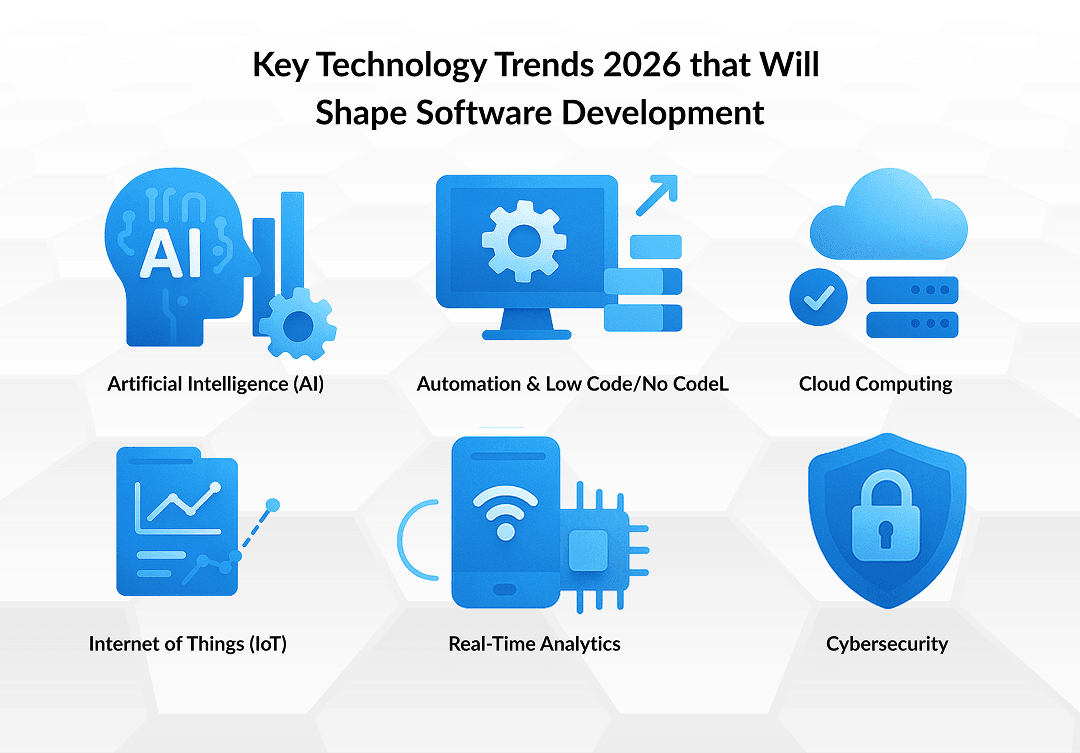
Key Technology Trends 2026 that Will Shape Software Development
As we approach 2026, the technology landscape continues to evolve rapidly, impacting how companies develop and utilize software. The following key technology trends are expected to play a decisive role in shaping the direction and strategy of software development in the future.
- Artificial Intelligence (AI): Delivering intelligent automation, predictive analytics, and data-driven decision-making.
- Automation & Low Code/No CodeL: Accelerating the application development process with greater efficiency.
- Cloud Computing: Providing flexibility, scalability, and ease of cross-location collaboration.
- Internet of Things (IoT): Connecting physical devices with digital systems for real-time solutions.
- Real-Time Analytics: Enables business to make quick decisions based on real-time solutions.
- Cybersecurity: A top priority with an AI-based protection system.
These trends indicate that future software development will become increasingly intelligent, adaptive, and integrated, making technology a key driver of business strategy.
Why Should You Choose a Software Development Company from Indonesia?
Choosing an Indonesian software development company offers many strategic advantages.
Here’s an explanation:
- High quality Talent
Indonesia has a large pool of professional software developers with expertise across various fields, from AI and mobile apps to cloud computing. - Competitive Development Costs
High quality work combined with cost efficiency compared to many other countries makes Indonesia an ideal choice for outsourcing or global collaboration. - Global Market Understanding
In Indonesia, many Indonesian software development companies have experience working with international clients, giving them a deep understanding of global business needs and standards. - Professional Standards and Agile Practices
In Indonesia, the use of Agile methodologies, transparent communication, and a results-focused approach makes projects more efficient and easier to manage. - Commitment to Security and Quality
Many companies in Indonesia implement international-grade security and quality controls to ensure product reliability. - Strategic Time Zone for Asia-Europe-US Coordination
With manageable time differences, Indonesian software developers can efficiently bridge communication across multiple time zones, enabling smoother global collaboration.
Custom software development enables businesses to create solutions that are tailored to their needs, flexible to technological changes, and ready to face future challenges. This approach allows companies to adapt faster, increase efficiency, and remain competitive in a continuously evolving digital era.
- Discovery: This stage ensures that solutions are built based on a deep understanding of business needs and goals, making the software truly relevant and strategically valuable.
- Design: System and interface designs are created to be efficient, user-friendly, and capable of adapting to evolving technology trends.
- Agile Development: The agile approach allows for flexible development, rapid adaptation to feedback, and continuous evolution in line with changing requirements.
- Scalability: Solutions are developed to grow alongside the business, handling increases in users, data, and integration with new technologies in the future.
This approach also includes integration with modern technologies such as AI, data analytics, and automation to ensure that the solutions developed are truly future-ready.
- AI helps improve efficiency and data-driven decision-making
- Analytics provides real-time insights to support smarter business strategies
- Automation accelerates operational processes and reduces human error.
By incorporating these three elements into every stage, from discovery to scalability, custom software development becomes more adaptive, efficient, and future-oriented, supporting sustainable digital transformation.
In a rapidly changing era, digital solutions must do more than meet current needs. Software should be designed to be easily updated, integrated, and enhanced, keeping pace with advancements such as AI, automation, IoT. and data analytics.
With a flexible and scalable foundation, custom software can continuously evolve, ensuring that businesses remain relevant, competitive, and prepared for future technological challenges.
As we move into 2026, technology will continue to advance rapidly, and only businesses that adapt through digital innovations will thrive.
Partnering with an Indonesian software development company means building solutions that are not only relevant today but also resilient and future-ready, as 2026 tech trends demand smarter and more adaptive software.
Indonesian companies are well-positioned to meet these needs by combining innovation and efficiency in every solution they develop. By establishing long-term partnerships, businesses can achieve sustainable digital growth and confidently embrace the future.
Ready to take your business into the digital era of 2026?
Partner with BTS.id, an Indonesian software development company dedicated to delivering innovative, efficient, and future-oriented custom solutions.
Contact BTS.id today and begin your journey toward sustainable digital transformation.
Let’s build your next custom software project designed for 2026 and beyond, and long-term success!
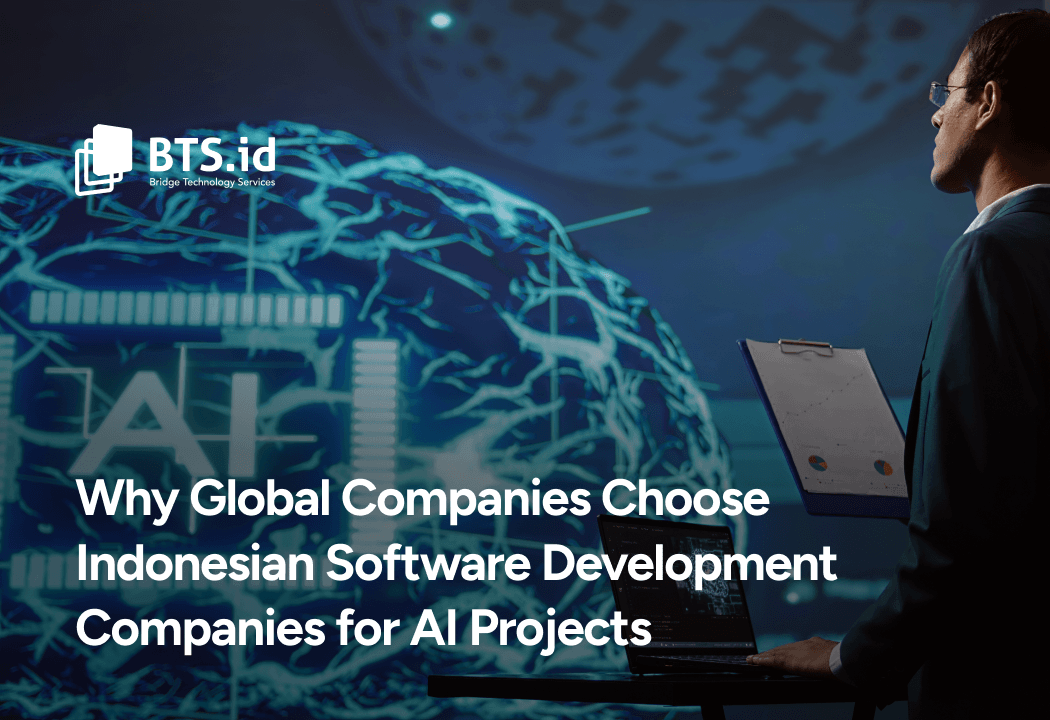
In recent years, the world has witnessed a significant surge in the adoption of Artificial Intelligence (AI) across various industries. AI powered software has now become an essential element in global digital transformation strategies, helping software development companies innovate faster, work more efficiently, and make smarter, data-driven decisions.
Artificial Intelligence (AI) is radically transforming the software development process by introducing tools and techniques that enhance productivity, accuracy, and drive innovation.
The global demand for AI-based software continues to grow in line with the acceleration of digital transformation across multiple sectors.
Businesses, from small enterprises to large corporations, are leveraging AI to improve operational efficiency, understand customer behaviour, and make more intelligent. data-driven decisions.
Technologies such as machine learning, natural language processing, and computer vision are increasingly being implemented in business solutions from process automation to the development of innovative products.
This trend demonstrates that AI is no longer just an additional innovation, but has become a core component of global growth and competitiveness strategies.
The demand for AI-based software is rapidly increasing as many organizations strive to improve efficiency, productivity, productivity. and decision-making capabilities.
Some of the key factors include:
- Global Digital Transformation: Companies across various sectors are racing to adopt technology to automate processes and enhance customer experience.
- Abundance of Data: The surge of data from digital activities, IoT, and social media creates vast opportunities for applying machine learning and predictive analytics.
- Advancements in Computing Technology: Access to more affordable cloud computing and GPUs has made AI implementation increasingly accessible.

The growing global demands for AI-based software has become one of the main drivers behind the surge in outsourcing and nearshoring practices within the software development industry.
Companies across various sectors are now racing to integrate AI into their systems but are facing challenges related to talent availability, costs, and development speed.
This is where the role of outsourcing and nearshoring becomes increasingly vital.
More and more companies around the world are choosing outsourcing or nearshoring for software development because these strategies offer efficiency, flexibility, and access to high quality global talent.
Why is that? Here’s the explanation:
- Cost Efficiency
One of the main reasons companies choose outsourcing is to reduce operational costs. By partnering with development teams from other countries with lower labor costs, companies can allocate their budgets to other business areas such as product innovations, marketing, or market expansion.
Nearshoring (outsourcing to geographically closer countries) also helps minimize logistics and communication costs without sacrificing efficiency.
- Access to Global Talent
The shortage of skilled professionals in technology, especially in software and AI development, has led companies to seek solutions abroad.
Through outsourcing of nearshoring, businesses can access experienced developers with specialized expertise, ranging from cloud computing and mobile development to cybersecurity, without the need for lengthy recruitment processes.
- Focus on Core Competencies
By delegating the development process to technology partners, companies can concentrate their internal resources on core activities such as business strategy, customer service, or product innovation.
This approach enhances productivity and accelerates time to market for new products.
- Scalability and Flexibility
Outsourcing offers companies a high level of flexibility to scale development teams up or down according to project needs.
This is especially beneficial in the dynamic technology industry, where project requirements can change rapidly.
- Nearshoring: A More Effective Collaboration Solution
Unlike traditional outsourcing, nearshoring enables easier collaboration due to similar time zones and work cultures.
This helps accelerate communications, reduce coordination barriers, and maintain the quality of development outcomes.
The growing global demand for AI-based software is driving Indonesia to become not only a potential market but also a producer of technological solutions.
Many local startups and AI software development company have begun developing AI-based solutions for various sectors, including finance, education, healthcare, and logistics.
This demonstrates that Indonesia is no longer merely adopting foreign technologies but is now actively contributing to creating digital innovations with global value.
Indonesia’s position as a leading technology hub in Southeast Asia has become increasingly strategic, establishing the country as one of the most dynamic tech centers in the region.
The rapid growth of the digital economy, the rise of innovation driven startups, and government support for digital transformation have made Indonesia an increasingly significant player in the global technology landscape.
Why Indonesian software development companies stand out?
Indonesian software development companies are gaining greater recognition on the international stage. With a combination of creative young talent, competitive developments, costs, and continuously advancing technological capabilities, Indonesia has successfully positioned itself as one of the leading software development hubs in Southeast Asia.
Here are some of the reasons:
- Competent and Adaptive Digital Talent
Indonesia has a large and growing base of digital talent.
Many young software developers possess expertise in modern technologies such as:
• Artificial Intelligence (AI) and Machine Learning
• Mobile and Web Development
• Cloud Computing and DevOps
• Cybersecurity
In addition, Indonesian developers are known for being highly adaptable to new technologies and quick to adjust to global market demands.
- Competitive Development Costs
One of Indonesia’s greatest advantages is its more cost efficient development rates compared to Western countries or even several other Asian nations.
This makes Indonesia an ideal destination for foreign companies seeking to outsource or nearshore their projects without compromising on quality.
- High work Quality and Professional Standards
An increasing number of Indonesian AI software development companies are adopting internationally recognized development practices, such as:
• Agile and Scrum methodologies
• Continuous Integration/Continuous Deployment (CI/CD)
• Rigorous Quality Assurance (QA)
Many companies also maintain a global portfolio with clients from the United States, Europe, and
Australia, demonstrating that the quality of their work is internationally recognized.
- Collaborative and Communicative Culture
Another advantage of Indonesian companies is their strong collaboration and communication skills.
Indonesian development teams are accustomed to working across time zones and cultures, enabling them to build productive working relationships with global clients,
Their professional, flexible, and service-oriented attitude is an added value that makes clients feel comfortable and confident in working together.
- Time Zone Advantage
Geographically, Indonesia is located in a strategic time zone, situated between Asia, Australia, and parts of the Middle East, making it ideal for cross-border collaboration.
This advantage allows Indonesian companies to:
• Provide faster technical support (real time support)
• Maintain 24-hour project productivity with a staggered workflow across time zones.
• Minimize communication barriers and waiting times, which are often challenges in long distance outsourcing projects.

In today’s fast-paced digital era, software quality and security are two of the most critical aspects for business success.
Software development companies in Indonesia (software house) now focus not only on delivering functional end results but also on ensuring that every solution they develop is secure, stable, and compliant with international standards.
Here’s how they maintain quality and security at every stage of development:
- Implementation of International Standards in the Development Process
Many Indonesian software development companies have adopted global standards such as:
• ISO/IEC 27001 for information security management
• ISO 9001 for quality management systems, and
• OWASP top 10 as a guideline for web application security
By implementing these standards, companies can ensure that every process from requirement analysis to deployment is carried out in a structured, measurable manner and in accordance with international best practices.
- Use of Agile and DevOps Methodologies
To maintain quality and efficiency, development teams in Indonesia widely employ Agile and DevOps methodologies.
• Agile enables continuous testing, allowing bugs or errors to be detected early.
• DevOps integrates development and operations teams, ensuring that the process from development and testing to deployment is fast while remaining secure and stable.
This approach results in products that are more flexible, reliable, and of high quality.
- Rigorous Quality Assurance (QA)
Every professional software development company has a Quality Assurance (QA) team responsible for ensuring the quality of each feature and module.
The QA process typically includes:
• Automated testing (unit tests, integration tests, regression tests)
• Manual testing for user experience (UI/UX)
• Performance testing to ensure application stability under high load
QA is not only conducted at the end of a project but is an integral part of the entire development lifecycle (SDLC)
- Security as a Priority from the Start (shift-Left Security)
The ‘shift-left security’ principle has now become a common practice in many Indonesian software development companies.
This means that security is not only considered at the end of a project but is implemented from the design and early development stages.
Measures taken include:
• Encrypted code and regular security audits
• Penetration testing to identify system vulnerabilities
• Implementation of two-factor authentication and encryption of sensitive data
With this approach, security risks can be minimized early, making the product far more resilient to cyber threats.
- Use of Modern Technologies and Tools
Software development companies in Indonesia in their efforts to deliver custom software solutions also leverage modern tools and frameworks to maintain quality and security, such as:
• SonarQube for code quality analysis
• Jenkins or GitLab CI/CD for automated testing and deployment
• Docker & Kubernetes for managing consistent and secure environments
The use of these technologies helps ensure that every application version is stable, tested. and easily traceable.
Quality and security are not just add-ons but the fundamental foundation of every modern software solution.
Indonesian software development companies have proven that they can combine technical expertise, global standards, and professional work ethics to deliver products that are secure, reliable, and competitive in the global market.
As the global demand for AI-based software continues to grow, many businesses are now seeking development partners capable of delivering innovative and impactful AI solutions.
With its rapidly growing technology ecosystem and competent digital talent, Indonesia has become a key destination for outsourcing or collaborating on AI development.
However, to ensure the success of your project, choosing the right software house is a crucial step.
Here are some tips to help you:
- Evaluate AI Experience and Portfolio
The first step is to review the company’s experience in handling AI-based projects.
Check whether they have a relevant portfolio, such as:
• Development of machine learning or deep learning systems
• Application of AI in data analytics, forecasting, or business process automation
• Integration of AI with IoT, mobile applications, or enterprise systems
Tips: Choose a company that not only ‘builds AI’ but also understands how AI can deliver real added value to your business.
- Check Technical Expertise and Technologies Used
AI development requires a strong combination of technical skills.
Ensure that the development team is proficient in:
• Programming languages such as Python, R, or JavaScript
• Popular AI frameworks like TensorFlow, PyTorch, or Scikit-learn
• Cloud infrastructure such as AWS, Google Cloud, or Azure AI Service
Experienced software houses are usually also capable of providing an end-to-end pipeline, from data engineering to mode; deployment.
- Consider the Quality of the Team and Local Talent
One of Indonesia’s main advantages is its abundance of globally qualified digital talent.
However, it is still important to assess whether the team handling your project has:
• Experienced AI specialist or data scientists
• Engineers who understand your business domain
• Communication and collaboration skills across time zones (time zones advantage)
The combination of technical expertise and soft skills will be a key factor in the success of your AI project.
- Communication and Transparency
AI projects require intensive communication between technical and business teams.
Ensure that the company has a clear and regular communication systems such as:
• Weekly sprint meetings or progress reports
• Access to real-time project dashboards
• Quick response to feedback
Transparent collaboration will accelerate decision-making processes and reduce miscommunication.
- Choose a Partner Who Understand Both Technology and Your Business Goals
This is a factor that is often overlooked, yet it is crucial.
Choose a partner who is not only technically skilled but also understands your business vision and objectives.
Why is this important?
• A successful AI project is not just about using advanced algorithms but about how the technology addresses real business needs.
• A partner who understands the business context can translate your company strategy into relevant technological solutions.
• They can also help you optimize your technology investment so that the outcomes truly deliver financial and operational impact.
For example, instead of immediately building a machine learning model, they would first analyze how an AI solution can enhance your business performance, such as production efficiency, customer experience, or market demand forecasting.
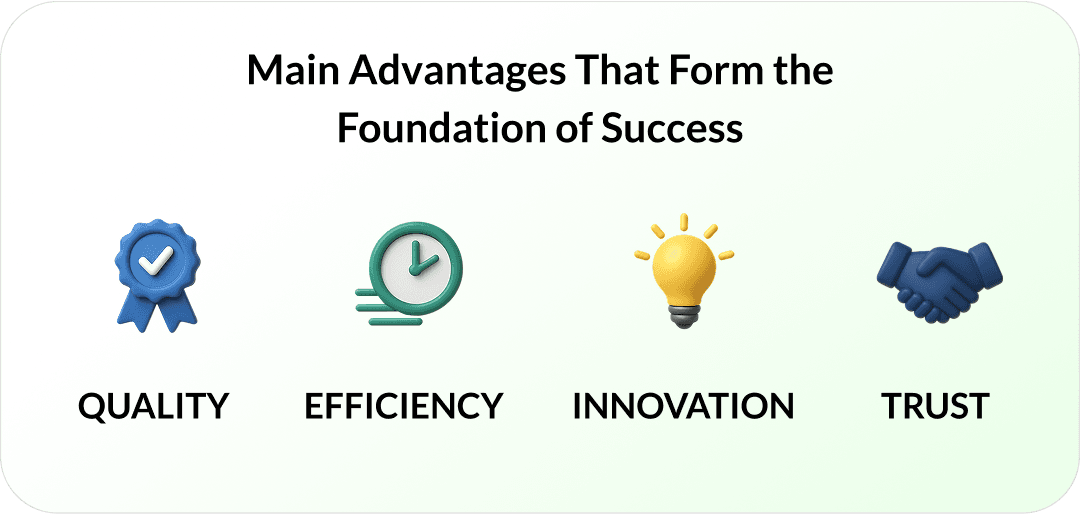
Indonesia now holds a significant position on the global technology map, particularly in software development and AI-based solutions.
With a combination of high quality digital talent, competitive development costs, and a continuously growing technology ecosystem, Indonesia offers strategic value that is hard to match in Southeast Asia.
Software development companies in Indonesia not only excel in technical capabilities but also increasingly understand the global business context, making them ideal partners for companies seeking to build innovative, secure, and high value AI solutions.
Additionally, the time zone advantage aligned with Asia and Australia, along with flexible communication with international clients, makes Indonesia a prime choice for long-term collaboration on advanced technology projects.
By choosing an Indonesian software house as your partner, your business gains more than just a development team, you gain a strategic partner ready to help drive digital transformation, improve efficiency, and accelerate AI adoption on the global scale.
In positioning Indonesia as a strategic partner for software development and AI-based solutions, there are four main advantages that form the foundation of success: quality, efficiency, innovation, and trust.
These four key pillars make Indonesia an increasingly significant player on the global stage:
- Quality: Adhering to international standards such as ISO and OWASP, with rigorous testing processes to ensure reliable and secure outcomes.
- Efficiency: Competitive development costs and smooth collaboration thanks to strategic time zones and responsive teams.
- Innovation: Actively developing AI, cloud, and IoT-based solutions, continuously experimenting to create new business value.
- Trust: Known for transparency, professionalism, and strong commitment to data security and client satisfaction.
With these four pillars, Indonesia is increasingly recognized as a trusted technology and AI development partner for global-scale digital projects and AI innovation.
Partnering with Indonesian developers means investing in the digital future of your business.
With technical expertise, continuous innovation, and a commitment to quality and integrity, Indonesian software houses are ready to become long-term strategic partners, helping you achieve sustainable success in the era of digital transformation and AI.
Indonesia has proven itself as a mature technology ecosystem, also outsourcing Indonesia has advanced and grown significantly.
with a unique combination of high work quality, cost efficiency, continuous innovation, and global professionalism.
With qualified talent, ongoing innovation, high flexibility, and a commitment to security and professionalism, development companies in Indonesia are capable of supporting your business growth alongside technological advancements.
This partnership ensures that you have digital solutions that are relevant, efficient. and adaptable, making Indonesia an ideal strategic partner in your journey of digital transformation and global AI innovation.
Ready to grow?
Let’s find the right software development company for your business partner with an Indonesian software house that understands your business needs and is ready to grow alongside you.
You can contact us at BTS.id, a trusted Indonesian software development company, ready to support your business in growing and thriving toward the future.
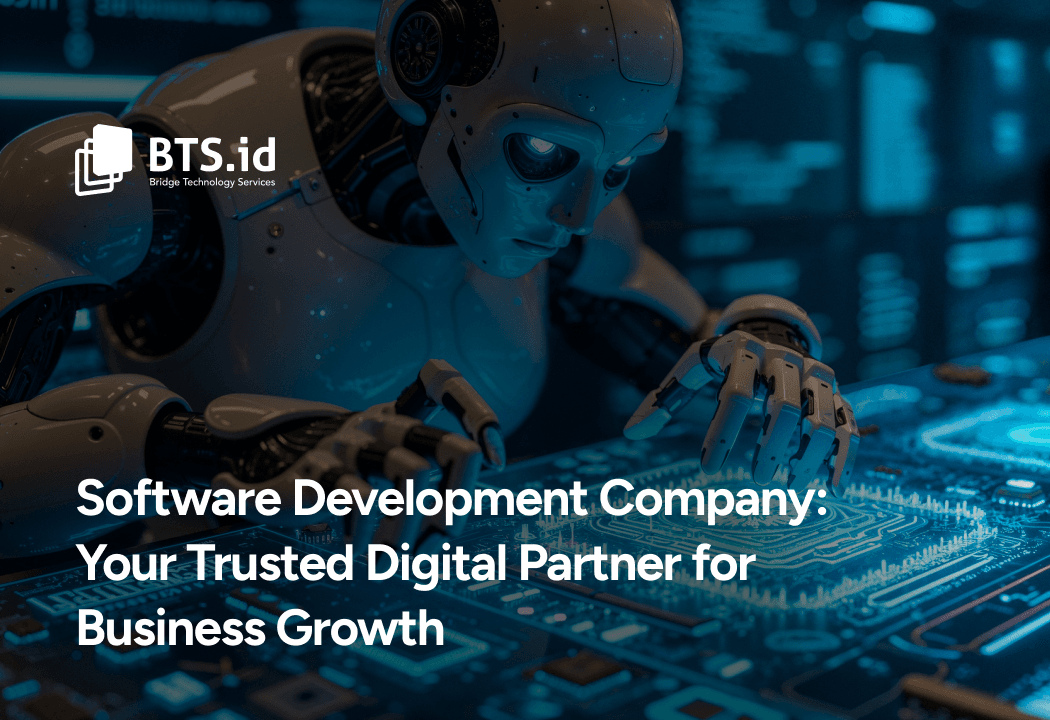
As software becomes increasingly integral to everyday life, software developers are starting to play a vital role in companies across various industries. Moreover, with the rapid acceleration of the digital era, technology is evolving quickly, and almost every aspect of our lives is now integrated with different types of software. From software developers more essential than ever both business and users.
A software development company is a business organization engaged in the design, development, testing, distribution, and maintenance of software products, ranging from customer applications, business solutions, to custom software tailored to client needs. These companies come in various types, such as consumer software developers (games and social media apps), enterprise software developers (ERP and CRM systems), as well as modifying existing ones to meet customer needs.
In short, a software development company acts as a digital partner that helps businesses innovate, improve efficiency, and grow through technological solutions.
Why do businesses need a software development company?
Businesses need software development companies because technology has become the backbone of nearly every industry today.
They rely on software development companies to obtain customized solutions, enhance efficiency and productivity, create competitive advantages, integrate existing systems, and strengthen security and compliance.
A software development company brings specialized expertise to build unique applications tailored to a business’s specific needs, often providing more effective and efficient solutions than off-the-shelf software.
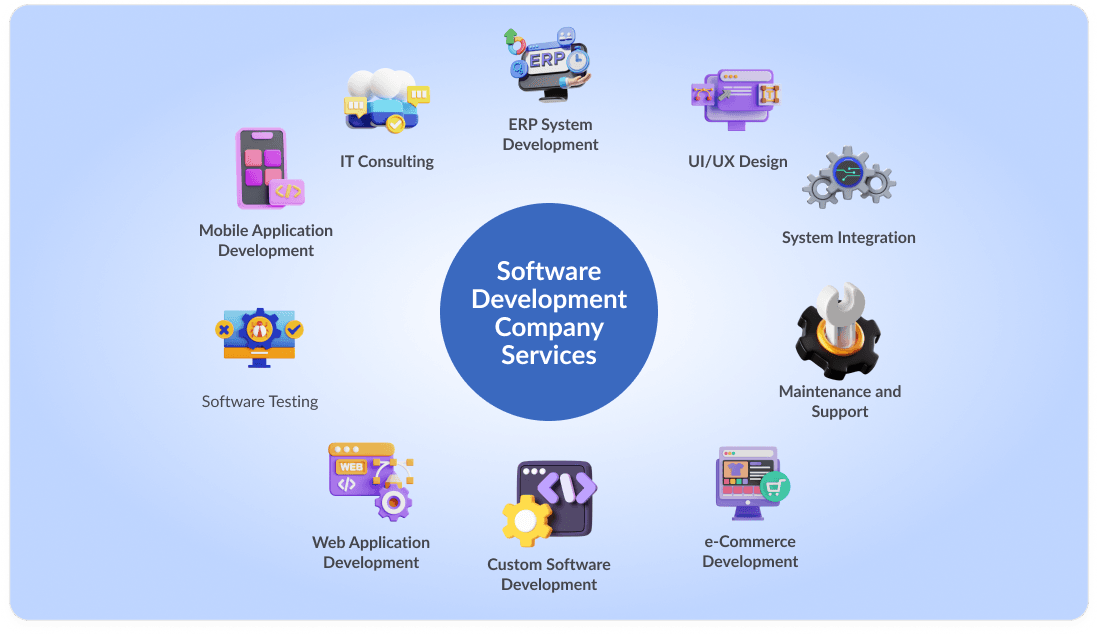
So, what services can a software development company offer?
Here are some of the main services typically provided by software developments companies:
- Custom Software Development
One of the key services offered is custom software development. A service that creates software tailored to the specific needs of clients.
Example: A custom inventory management system designed to handle the logistics requirements of a manufacturing industry. - Web Application Development
This service builds web-based applications that can be accessed through an internet browser.
Example: A project management platform for teams to collaborate and manage tasks online, such as Trello. - Mobile Application Development
Another key service offered is mobile application development.
A service that develops applications for mobile platforms such as iOS and Android.
Example: BCA Mobile or Mandiri online, which allows users to perform banking transactions from their mobile devices. - System Integration
A service that combines different systems and software to function in a unified way.
Example: Integration between a Customer Relationship Management (CRM) system and an Enterprise Resource Planning (ERP) system to automate data flow between sales and inventory management. - Maintenance and Support
Maintenance and support is the next key service offered.
Provides maintenance and support services to ensure software runs smoothly.
Example: Maintenance services for an e-commerce system to keep the website secure, functional, and regularly updated. - Software Testing
This service conducts testing to ensure the quality and performance of the software meet the desired standards.
Example: Mobile app testing services to check for bugs, security, and performance before the app is released on Google Play or the App Store. - IT Consulting
This service offers advice and strategies on effective technology implementation.
Example: Consulting for a company’s digital transformation process, including recommendations for the best software, IT infrastructure, and strong cybersecurity strategies. - ERP System Development
This service focuses on building Enterprise Resource Planning to manage various business processes.
Example: ERP systems such as SAP or Odoo, which integrate business functions like finance, human resources, production, and distribution. - UI/UX Design
This service aims to design intuitive and engaging user interfaces and user experiences.
Example: User design for streaming apps like Netflix to ensure users have an enjoyable experience while easily navigating the platform. - e-Commerce Development
This service builds e-commerce platforms for online sales.
Example: E-commerce platforms like Tokopedia or Bukalapak, which enable sellers to open stores and sell their products to consumers.

In the digital era, technology is no longer just a support tool, but has become the main foundation for business growth. To remain competitive and continue evolving, companies need the right technological support.
This is where software development companies serve as strategic partners.
Partnering with a software house is not only about creating applications but also delivering real benefits for businesses that aim to innovate and expand their reach.
Through this collaboration, businesses can combine specialized knowledge, pool resources, and accelerate the creation of new products.
The main benefits of working with a software development company as follows:
- Ensuring Quality and Expertise
The first benefit of partnering with a software house is access to skilled professionals with extensive experience in various technologies and programming languages.
They can be trusted to deliver accurate, high-quality, and innovative solutions tailored to your business's specific needs. - Saving Time and Costs
Developing software in-house requires significant investments in terms of time, cost, and human resources.
By using the services of a software company, you can save time and costs for recruitment and training, as the provided team is already trained and ready to work. - Ability and Focus on Core Business
By outsourcing software development to a software house, you can focus on your core business aspects without being distracted by the technical complexities and project management of software development.
This allows you to allocate resources and attention to business growth and key strategies while ensuring that your core competencies remain the priority. - Customized Solutions
Every business has unique needs. A software house can design custom applications that truly address your company’s specific challenges. - Innovation and Scalability
The digital solutions built are not only relevant for today but also flexible enough to support business growth in the future. - Competitive Advantage
With the right software, your business can stand out and gain an edge over competitors, both in terms of services and operational efficiency.
In today’s digital era, software is no longer just an additional tool but has become a key driver in boosting efficiency, enhancing customer experience, and expanding business opportunities. However, success in leveraging this technology largely depends on the software development company (software house) you choose as your partner.
To choose the right software development company, you need to evaluate their technical expertise and experience in your industry, review their portfolio and case studies of previous projects, ensure their capability to develop scalable and future-ready software, assess transparent pricing models as well as readiness for post-project support and maintenance, and most importantly, confirm alignment with your company’s culture and communication style.
With so many options available, you need to consider several key factors to ensure that your technology investment truly delivers maximum results.
Some of them include:
- Understand Your Business Needs
Before looking for a partner, make sure you are clear about the goals of the software you want to build.
Is it to speed up internal operations, provide better customer service, or open up new market opportunities? With clear needs, it will be easier to find the right company. - Review Portfolio and Experience
Check the projects they have previously worked on. A portfolio provides a real picture of their quality, creativity, and ability to handle different types of business. The more relevant their experience is to your industry, the greater the chances of your project's success. - Evaluate Technological Expertise
Ensure the company masters the latest technologies that suit your needs, whether it’s web applications, mobile apps, cloud solutions, or AI-based systems. The right technical expertise will guarantee software that is reliable, secure, and sustainable in the long term. - Consider Reputation and Client Testimonials
Look at reviews, case studies, or testimonials from their previous clients. This helps you assess the professionalism, consistency, and ability of the company to build long-term trust. - Development Methodology Used
Choose a company that applies modern methodologies such as Agile or Scrum. With these methods, the development process becomes more flexible, transparent, and adaptable to changes in your business needs. - Communication and Post-Project Support
Smooth communication is the key to successful collaboration. Ensure they are responsive, open in providing updates, and offer technical support after the software is completed. - Align with Budget and Added Value
While price is important, don’t just focus on the cheapest option. Also consider service quality, long-term support, and the added value they can provide to support your business growth.

Choosing the right software development company is a strategic step for business success in the digital era.
With the right partner, you don’t just get software, you gain digital solutions that support innovation, efficiency, and long-term growth.
Every business has its own challenges and opportunities. But one thing is certain: in the digital era, technology is the key to growth. Many companies across different sectors have proven that partnering with a software development company (software house) is not just about building applications, but about paving the way for innovations and business expansion
Here are some real-life examples to inspire you:
- Local Retail Store Becoming a National E-Commerce
In the past, a small store relied only on sales within its neighbourhood. After partnering with a software house and launching an e-commerce platform, the business was able to reach customers all over Indonesia. The result? Sales multiplied, and the once-local brand is now recognized nationwide. - Healthcare Clinic Undergoing Digital Transformation
A clinic that previously used manual systems for registration and medical records partnered with a software house. As a result, they now have a modern patient management system that makes processes faster, data more secure, and provides patients with a more comfortable healthcare experience. - Tech Startup Enhancing Customers Service
For a startup, user satisfaction is everything. With the support of a software house, they developed an intuitive, user-friendly mobile application. The impact? The number of active users skyrocketed, positive reviews increased, and customer loyalty grew stronger.
From small shops to large enterprises, every business can grow faster with the support of technology. A software development company is a strategic partner that helps businesses undergo digital transformation, enabling them to improve efficiency, expand their market, and achieve sustainable growth.
Every business starts with an idea. However, an idea itself is not enough to create real change. Proper execution, well-thought-out strategies, and a reliable digital partner are essential.
By partnering with the right software development company, your ideas can be transformed into digital solutions that are relevant, innovative, and have a direct impact on business growth. From improving operational efficiency, expanding markets, to creating better customer experiences, all can be achieved through strong collaboration with a trusted digital partner.
Remember, technology is not just a trend, it is the foundation of your business’s future.
It’s time to turn ideas into innovation, and innovation into real impact. Don’t delay your digital transformation.
Schedule a free consultation now and start your journey toward growth with us BTS.id, your trusted software house.
Let’s discuss with our expert team at BTS.id and discover the best digital solutions for your business needs.

Dengan semakin berkembangnya teknologi, kita memasuki era dimana pendidikan tidak lagi terbatas pada ruang kelas fisik, melainkan dapat diakses dari mana saja dan kapan saja. Artificial Intelligence (AI) bukan lagi sekedar teknologi masa depan, melainkan sudah menjadi bagian nyata dari sistem pendidikan modern.
Dengan kemampuan analisis data, personalisasi pembelajaran, dan otomatisasi proses, AI Indonesia membantu menciptakan pengalaman belajar yang efisien, adaptif, dan inklusif.
Melalui AI development, industri pendidikan mampu menjawab tantangan era digital dan meningkatkan kualitas pembelajaran secara berkelanjutan.
Dengan AI development, para pendidik dapat menyesuaikan pengalaman belajar dengan kebutuhan masingmasing siswa, menjadikan pendidikan lebih efektif dan menarik. Teknologi berbasis AI juga membantu tugastugas administratif, menyederhanakan operasional, dan memberikan keleluasaan bagi para pendidik untuk fokus pada pengajaran.
AI development di Indonesia berpotensi menjadi motor utama transformasi pendidikan. Dengan kolaborasi yang kuat antara sekolah EdTech, software house, dan pemerintah, penerapan AI dapat menciptakan sistem belajar yang lebih inklusif, adaptif, dan siap menghadapi tantangan global, dimana saat ini teknologi telah menjadi bagian penting dalam proses belajar-mengajar, bukan hanya sebagai alat bantu, tetapi sebagai penggerak utama transformasi.
Istilah seperti teknologi pendidikan, transformasi digital, dan inovasi EdTech kini sering kita dengar, karena ketiganya berperan penting dalam membentuk sistem pendidikan modern yang lebih adaptif, inklusif, dan berkelanjutan.
Teknologi pendidikan (Educational Technology/EdTech) adalah pemanfaatan teknologi digital untuk mendukung proses belajar-mengajar. Bentuknya beragam, mulai dari Learning Management System(LMS) seperti Moodle atau Google Classroom, hingga aplikasi pembelajaran interaktif seperti Duolingo atau Khan Academy.
Tujuan utama dari EdTech adalah membuat pembelajaran lebih mudah diakses, fleksibel, serta sesuai dengan kebutuhan siswa. Contohnya dengan adanya video interaktif, kuis online, atau simulasi berbasis VR/AR, siswa dapat belajar dengan cara yang lebih menyenangkan sekaligus mendalam.
Transformasi digital dalam pendidikan bukan hanya sekedar memindahkan kelas ke platform online, Lebih dari itu, transformasi digital mencakup perubahan paradigma, strategi, hingga budaya belajar.
Beberapa bentuk transformasi digital dalam pendidikan antara lain:
- Digitalisasi kurikulum dan materi ajar sehingga mudah diakses secara daring.
- Hybrid learning, yang menggabungkan pembelajaran tatap muka dengan online learning,
- Pemanfaatan big data untuk menganalisa perkembangan siswa secara real time.
- Kolaborasi global, dimana siswa dapat belajar dari guru atau mentor di belahan dunia lain.
Transformasi ini membuat pendidikan lebih efisien, transparan, dan merata. Bahkan di daerah terpencil sekalipun, siswa bisa mengakses materi yang sama dengan yang ada di kota besar, selama tersedia internet.

Mengapa Software House Merupakan Mitra Strategis untuk AI Development di Pendidikan?
AI development telah membawa perubahan signifikan dalam dunia pendidikan. Teknologi ini memungkinkan
terciptanya sistem pembelajaran yang lebih adaptif, efisien, dan inklusif, mulai dari platform pembelajaran
personal, chat box tutor, hingga analitik siswa.
Namun agar implementasi Artificial Intelligence (AI) dapat berjalan efektif, lembaga pendidikan dan
perusahaan EdTech membutuhkan mitra teknologi yang memiliki kompetensi dan pengalaman memadai.
Disinilah software house Indonesia berperan sebagai mitra strategis dalam mengembangkan solusi AI
Indonesia untuk pendidikan.
- Keahlian Teknis dalam AI dan Machine Learning
Software house Indonesia memiliki tim yang terbiasa bekerja dengan teknologi terkini seperti machine
learning, natural language processing, dan big data analytics. Dengan keahlian ini, mereka bisa
merancang sistem AI yang sesuai untuk kebutuhan pendidikan, misalnya:- Chatbot tutor cerdas yang bisa menjawab pertanyaan siswa 24/7
- Sistem rekomendasi materi belajar berbasis analisis perilaku pengguna
- Algoritma pendeteksi kesulitan siswa sejak dini
- Pengembangan Solusi yang Custom dan Scalable
Setiap institusi pendidikan punya tantangan yang berbeda. Software house Indonesia dapat membuat
solusi AI yang customized sesuai kebutuhan spesifik, misalnya untuk sekolah dasar, perguruan tinggi,
atau platform kursus online.
Selain itu, software house Indonesia juga mampu merancang sistem yang scalable, sehingga bisa
digunakan mulai dari ratusan hingga ribuan siswa tanpa penurunan performa. - Integrasi dengan Sistem Pendidikan yang Sudah Ada
Banyak lembaga pendidikan sudah menggunakan Learning Management System (LMS) atau platform
digital tertentu. Software House Indonesia bisa membantu mengintegrasikan AI dengan sistem yang
ada, tanpa perlu membangun ulang dari nol.
Contohnya adalah:- Menambahkan modul analitik berbasis AI pada LMS
- Menghubungkan aplikasi AI dengan database siswa yang sudah ada
- Sinkronisasi AI tutor dengan platform e-learning yang digunakan guru.
- Akselerasi Inovasi EdTech
Dengan dukungan software house, sekolah atau startup EdTech tidak perlu membangun tim teknologi
dari awal. Mereka bisa lebih cepat meluncurkan solusi AI yang inovatif ke pasar, misalnya:- Aplikasi belajar adaptif berbasis AI
- Sistem penilaian otomatis dengan NLP
- Platform pembelajaran imersif berbasis AI+AR/VR
Penerapan AI dalam Pembelajaran: Studi Kasus dan Dampaknya Terhadap Siswa dan Guru
AI development yang telah membawa inovasi besar dalam dunia pendidikan, untuk memahami dampaknya secara nyata, mari kita cermati beberapa studi kasus penerapan AI dalam pembelajaran, serta bagaimana hal tersebut mempengaruhi siswa dan guru.
Aplikasi AI di Sekolah
Beberapa contoh penerapan AI Indonesia yang sudah digunakan di sekolah antara lain:
- Tutor Virtual dan Chatbot Edukatif: Membantu siswa menjawab pertanyaan di luar jam pelajaran.
- Sistem Penilaian Otomatis: Memeriksa kuis, esai, atau tugas dengan lebih cepat
- Learning Management System (LMS) dengan AI: Menyesuaikan materi suatu tingkat pemahaman siswa
- Analisa Data Belajar: Membantu guru memantau perkembangan siswa secara real time.
- Teknologi Pendukung Inklusif: Misalnya speech-to-text untuk siswa tuna rungu atau text-to-speech untuk siswa dengan disleksia.
Dampak Teknologi pada Pembelajaran
Penerapan teknologi berbasis Ai membawa beberapa dampak penting:
Dampak Positif
- Personalisasi: Setiap siswa bisa belajar sesuai kecepatan dan gaya belajarnya
- Efisiensi: Guru terbantu dalam mengurangi beban administratif
- Aksesibilitas: Pendidikan lebih terbuka untuk siswa dengan kebutuhan khusus
- Engagement: Metode belajar interaktif meningkatkan motivasi siswa

Tantangan
- Ketergantungan: Resiko siswa terlalu mengandalkan teknologi
- Kesenjangan Akses: Tidak semua sekolah memiliki infrastruktur digital memadai
- Kesiapan Guru: Dibutuhkan literasi digital yang tinggi
Studi kasus EdTech
Beberapa contoh nyata penerapan AI dalam pendidikan:
- Khan Academy (global)
Menggunakan AI untuk memberikan jalur belajar personal bagi siswa. Guru juga bisa mengakses laporan perkembangan secara detail. - Socratic by Google (Global)
Aplikasi berbasis AI yang membantu siswa menjawab pertanyaan pelajaran dengan penjelasan langkah demi langkah - Ruangguru (Indonesia)
Sebagai salah satu platform EdTech terbesar di Indonesia, Ruangguru sudah menerapkan fitur adaptif dan interaktif yang didukung teknologi AI untuk mendukung pembelajaran jarak jauh. - Quipper (Indonesia)
Menghadirkan sistem analitik yang membantu guru melihat perkembangan siswa, serta memberikan rekomendasi materi tambahan.
Manfaat AI Bagi Siswa dan Guru
- Bagi siswa manfaat AI adalah bisa mendapat pengalaman belajar yang personal, bisa belajar kapan saja dan dimana saja, mendapat dukungan pembelajaran tambahan melalui chatbot atau tutor AI, serta lebih mudah memahami materi dengan visualisasi interaktif.
- Manfaat AI bagi guru adalah guru terbantu dalam mengoreksi dan menilai tugas, guru bisa mendapat data perkembangan siswa secara instan, bisa lebih fokus pada interaksi humanis dengan siswa, serta lebih mudah mengidentifikasi siswa yang mengalami kesulitan belajar.
Tantangan dan Solusi dalam Adopsi AI di Dunia Pendidikan
Penerapan Artificial Intelligence (AI) dalam dunia pendidikan, baik di sekolah, universitas, maupun platform EdTech selain menawarkan banyak manfaat, implementasinya tidak selalu berjalan mulus. Ada sejumlah tantangan yang perlu diperhatikan, sekaligus solusi inovatif yang bisa diterapkan agar adopsi AI lebih efektif.
Beberapa diantaranya:
- Keterbatasan Infrastruktur Digital
Banyak sekolah khususnya di daerah yang belum memiliki perangkat memadai atau akses internet yang stabil. Hal ini membuat penerapan AI sulit dilakukan secara merata. - Kurangnya Literasi Digital Guru dan Siswa
Tidak semua guru siap menggunakan teknologi berbasis AI, sebagian masih terbiasa dengan metode konvensional dan merasa kesulitan beradaptasi. - Biaya Implementasi yang Tinggi
Pengembangan aplikasi AI dan penyediaan hardware membutuhkan investasi yang besar. Sekolah dengan anggaran terbatas sering kesulitan dalam mengadopsinya. - Keamanan dan Privasi Data
Data siswa adalah informasi sensitif. Penerapan AI yang tidak diawasi dengan baik bisa menimbulkan resiko kebocoran atau penyalahgunaan data. - Kesenjangan Akses
Adopsi berpotensi memperlebar jurang antara sekolah yang mampu dengan yang tidak, sehingga muncul ketidakmerataan kualitas pendidikan.
Kriteria Memilih Mitra AI Development
- Keahlian Teknis dan Portofolio
Pastikan software house memiliki pengalaman di bidang Machine Learning, big data, Natural Language Processing (NLP), dan cloud computing. Portofolio proyek serupa bisa menjadi indikator keandalan mereka. - Pemahaman Konteks Pendidikan
Software house yang ideal tidak hanya mahir dalam teknologi, tetapi juga memahami tantangan pendidikan: kurikulum, metode belajar, dan kebutuhan guru maupun siswa. - Kemampuan Integrasi Sistem
AI seringkali harus terhubung dengan sistem yang sudah ada, seperti LMS (learning Management System).
Mitra yang baik mampu melakukan integrasi tanpa mengganggu ekosistem yang berjalan. - Keamanan Data dan Etika AI
Data siswa sangat sensitif. Software house harus memiliki standar keamanan tinggi, menerapkan enkripsi, serta memperhatikan aspek etika agar AI bebas bias. - Skalabilitas Solusi
Pilih mitra yang bisa mengembangkan solusi scalable, sehingga sistem tetap berjalan optimal meski jumlah pengguna meningkat pesat. - Transparansi dan Komunikasi
Proses pengembangan AI bukan hanya soal coding, tetapi juga kolaborasi. Software house yang baik akan terbuka dalam komunikasi, biaya, dan perkembangan proyek.

Sementara agar kerja sama dapat berjalan dengan lancar, beberapa hal berikut perlu diperhatikan:
- Tentukan Tujuan Jelas: Definisikan masalah pendidikan yang ingin diselesaikan dengan AI, misalnya personalisasi belajar atau otomatisasi penilaian.
- Bangun Tim Kolaboratif: Libatkan guru, manajemen sekolah, dan developer dalam setiap tahap agar solusi AI sesuai dengan kebutuhan nyata di lapangan.
- Iterasi dan Uji Coba: AI membutuhkan data dan penyempurnaan berkelanjutan. Lakukan uji coba kecil (pilot project) sebelum implementasi skala besar.
- Monitoring dan Evaluasi: Setelah implementasi, pastikan ada sistem monitoring kinerja AI serta evaluasi dampaknya bagi siswa dan guru.
Kemitraan antara EdTech dan software house Indonesia adalah kunci dalam menghadirkan solusi AI yang relevan, aman, dan berkelanjutan di dunia pendidikan. EdTech memahami kebutuhan lapangan, sementara software house menghadirkan keahlian teknis.
Sinergi keduanya memungkinkan terciptanya inovasi yang terus berkembang, sehingga transformasi pendidikan digital dapat berjalan lebih efektif dan memberi manfaat nyata bagi siswa maupun guru.
Jangan biarkan peluang inovasi pendidikan terlewat begitu saja. Dengan bermitra dengan software house Indonesia berpengalaman, Anda dapat mewujudkan solusi AI yang sesuai kebutuhan, aman, dan siap berkembang seiring waktu.
Segera hubungi tim kami BTS.id sekarang, untuk mulai membangun kolaborasi strategis yang akan membawa pendidikan Anda selangkah lebih maju!

Memilih solusi teknologi yang tepat sangat penting bagi perusahaan, karena berpengaruh pada operasional bisnis, biaya yang dikeluarkan, serta perkembangan perusahaan. Terlebih di era digital saat ini, banyak perusahaan mulai beralih ke komputasi cloud untuk mengelola data dan aplikasi mereka.
Namun masih ada perusahaan besar yang ragu untuk meninggalkan sistem on-premise (di tempat) yang sudah lama mereka gunakan, banyak juga yang berpendapat bahwa on-premise tetap punya manfaat yang signifikan, bahkan perusahaan baru sering mempertanyakan apakah investasi besar dalam infrastruktur on-premise adalah keputusan yang tepat.
Cloud dan on-premise keduanya memiliki karakteristik, keunggulan, dan tantangan masing-masing yang dapat berdampak besar pada cara software house Indonesia membangun, mengelola, dan mengirimkan solusi kepada klien. Memahami perbedaan keduanya menjadi langkah penting agar software house Indonesia dapat merancang strategi teknologi yang tepat dan kompetitif di pasar. Memahami perbedaan antara keduanya akan membantu Anda untuk membuat keputusan yang benar, sesuai dengan kebutuhan dan tujuan strategis perusahaan.
Mari kita bahas lebih lanjut perbandingan antara cloud dan on-premise.
Pengertian On-Premise
On-premise adalah suatu metode tradisional dalam menerapkan dan mengoperasikan bisnis, merupakan model penerapan infrastruktur IT dimana perusahaan memiliki dan mengelola sendiri perangkat keras dan perangkat lunak yang mereka gunakan, biasanya di lokasi fisik mereka sendiri, dan perusahaan bertanggung jawab penuh atas seluruh infrastruktur mereka seperti server, sistem penyimpanan, dan perangkat jaringan.
Dalam sistem ini, semua infrastruktur IT termasuk server, penyimpanan data, dan aplikasi tidak berada di pusat data pihak ketiga seperti layanan cloud.
On-premise sering digunakan di industri yang menangani data sensitif atau yang tunduk pada regulasi ketat seperti perbankan, rumah sakit, dan pemerintahan.
Pengertian Cloud Computing
Cloud computing adalah penyedia layanan infrastruktur IT melalui internet, bukan server lokal atau perangkat pribadi. Sistem ini didesain supaya bisa diakses dengan mudah, dan dikelola sepenuhnya oleh penyedia layanan cloud.
Perusahaan menyimpan data dan menjalankan aplikasi mereka di server eksternal yang dikelola oleh penyedia layanan cloud, seperti Amazon Web Service (AWS), Google Cloud, dan Microsoft Azure. Layanan ini semakin populer karena menawarkan biaya yang lebih fleksibel, skalabilitas tinggi, serta pencadangan data secara otomatis.

Kelebihan Sistem On-Premise
Meskipun cloud computing semakin populer, banyak perusahaan tetap memilih on-premise karena beberapa alasan berikut:
- Kontrol Penuh atas Data dan Infrastruktur
Semua data, aplikasi, dan server berada di lingkungan perusahaan, sehingga tidak bergantung pada pihak ketiga. Hal ini berarti perusahaan dapat menyesuaikan sistem sesuai dengan kebutuhannya tanpa tergantung pada penyedia layanan pihak ketiga. Anda bisa memilih hardware dan software sesuai kebutuhan, mengatur server, penyimpanan, jaringan, serta menangani sendiri sistem keamanannya.
Kendali ini mungkin penting bagi bisnis yang terikat dengan regulasi tertentu, karena mereka bisa memastikan bahwa infrastrukturnya dikelola sesuai dengan aturan tersebut. - Keamanan Data yang Dapat Disesuaikan
Perusahaan juga mempunyai fleksibilitas untuk menyesuaikan sistem dengan kebutuhan bisnis.
Misalnya, mengintegrasikan sistem dengan hardware atau software lain, memodifikasi sistem untuk mendukung proses tertentu, hingga menerapkan langkah keamanan spesifik.Perusahaan dapat menggunakan firewall dan enkripsi tingkat lanjut. perusahaan dapat menerapkan sistem otorisasi khusus untuk mencegah akses tidak sah, serta perusahaan dapat menghindari resiko serangan cyber yang menyerang layanan cloud publik. - Tidak Tergantung pada Internet untuk Akses Internal
Sistem tetap bisa berjalan walau koneksi internet terputus, selama berada di jaringan lokal, Hal ini menjadi keunggulan besar bagi perusahaan yang beroperasi di daerah dengan akses internet terbatas atau tidak stabil. - Kepatuhan Regulasi Lebih Mudah
Cocok untuk industri yang mengharuskan data disimpan di lokasi tertentu (misalnya perbankan, rumah sakit, pemerintahan). Banyak industri memiliki regulasi ketat yang mengharuskan perusahaan untuk menyimpan data mereka dalam server lokal.
Dengan sistem 0n-premise, perusahaan dapat lebih mudah memenuhi standar kepatuhan seperti:- HIPAA (Health Insurance Portability and Accountability Act) untuk data medis.
- GDPR (General Data Protection Regulation) di Uni Eropa untuk data pribadi pelanggan.
Kekurangan Sistem On-Premise
- Investasi Awal yang Besar
Untuk membangun sistem on-premise, perusahaan perlu mengeluarkan investasi awal yang cukup besar untuk:- Membeli server dan perangkat penyimpanan
- Memasang jaringan internal yang aman dan stabil
- Menyediakan ruang fisik dan pendingin untuk pusat data internal Bahkan tidak hanya itu, ada biaya tambahan lain seperti:
- Listrik untuk menjalankan server 24/7
- Pemeliharaan hardware agar tetap berfungsi
- Skalabilitas Terbatas
Jika membutuhkan kapasitas tambahan, maka harus membeli lagi hardware baru dan memakan waktu instalasi.
Memang, infrastruktur bisa dibuat sesuai untuk mendukung pertumbuhan bisnis. Namun proses ini bisa cukup rumit, memakan waktu dan mahal. Seringkali perusahaan harus membeli hardware dan software tambahan. - Pemeliharaan dan Upgrade Menjadi Tanggung Jawab Internal
Memerlukan tim IT yang kompeten untuk mengelola, memelihara, dan memperbaharui sistem. Dalam mengelola sistem on-premise membutuhkan tenaga ahli IT yang handal untuk:- Mengelola server dan jaringan
- Memastikan sistem tetap aman dari ancaman cyber
- Memperbaiki dan memperbarui software secara berkala, tanpa tim IT yang kompeten resiko kegagalan sistem dan serangan cyber bisa meningkat.
- Akses Terbatas dari Jarak Jauh
Karena data tersimpan di lokasi fisik perusahaan, mengakses sistem dari luar kantor bisa menjadi tantangan. Solusi seperti VPN (Virtual Private Network) atau Remote Desktop bisa digunakan, tetapi mereka memiliki resiko keamanan yang harus dikelola dengan baik.
Keuntungan Cloud Computing
- Skalabilitas
Kebutuhan bisnis pasti berubah seiring bertumbuhnya skala bisnis. Infrastruktur cloud mampu memenuhi hal tersebut, menambah dan mengurangi sumber daya sesuai dengan permintaan yang berubah-ubah. Perusahaan bisa menambah atau mengurangi kapasitas (storage, computing power) dengan cepat sesuai kebutuhan bisnis. Perusahaan juga bisa meningkatkan atau menurunkan skala infrastruktur sesuai dengan kebutuhan. - Pemeliharaan Dilakukan oleh Provider
Penyedia cloud menangani pembaruan software, patch keamanan, dan server maintenance, sehingga tim internal tidak terlalu terbebani, perusahaan tidak perlu mengelola server sendiri karena penyedia layanan cloud bertanggung jawab atas server maintenance, pembaruan software, dan pencadangan data secara berkala. - Fleksibilitas Tinggi
Cloud Computing dapat diakses dari mana saja, kapan saja, serta dari perangkat apapun, karena cukup menggunakan koneksi internet. Hal ini memudahkan kolaborasi antar anggota tim, karena mereka bisa bekerja sama secara real time, tanpa harus berada di lokasi fisik yang sama. Kelebihan ini meningkatkan produktivitas kerja, efisiensi kerja, serta kepuasan kerja. Dengan aplikasi yang bisa diakses dimana saja selama ada koneksi internet, karyawan tidak harus bekerja dari kantor.
Cloud memungkinkan software house Indonesia membuat development environment dalam hitungan menit, sehingga proyek bisa dimulai tanpa harus menunggu instalasi fisik server. - Keamanan yang Tinggi (shared Responsibility)
Penyedia cloud umumnya memiliki standar keamanan tingkat enterprise, termasuk enkripsi data, firewall, dan monitoring 24/7 - Tidak Membutuhkan Investasi Awal yang Besar
Cloud computing menggunakan model berlangganan bulanan sesuai dengan kapasitas yang digunakan. Hal ini memungkinkan perusahaan untuk menghemat biaya infrastruktur, dan tidak membutuhkan investasi yang besar di awal.
Kekurangan Cloud Computing
- Keamanan
Karena data disimpan di server milik pihak ketiga, ada resiko keamanan seperti kebocoran data atau serangan cyber. Penyedia layanan pasti sudah mengambil langkah-langkah khusus untuk memastikan keamanan. Namun beberapa perusahaan tetap punya kekhawatiran untuk menyimpan data sensitif di cloud.
Disinilah pentingnya untuk penyedia layanan yang menawarkan infrastruktur cloud yang aman dan ter-enkripsi. - Ketergantungan pada Internet
Jika koneksi internet terputus, maka akses ke data dan aplikasi yang tersimpan di cloud juga akan terganggu. Bagi bisnis yang sangat bergantung pada cloud, downtime bisa berakibat besar terhadap produktivitas, tanpa internet yang stabil, akses ke data dan aplikasi akan terganggu atau terhenti. - Kepatuhan Regulasi yang Rumit
Beberapa industri mewajibkan data disimpan di lokasi tertentu, sementara provider cloud mungkin tidak memiliki data center di wilayah yang dibutuhkan. - Kontrol Terbatas atas Infrastruktur
Server dan hardware dimiliki provider, sehingga pengguna tidak bisa mengatur konfigurasi fisik sesuai keinginan. - Downtime dan Gangguan Layanan
Jika penyedia mengalami gangguan (outage), pengguna tidak dapat mengakses layanan sampai masalah terselesaikan.

Pertimbangan Utama Memilih Cloud vs On-Premise
Saat memilih antara cloud atau on-premise, perusahaan harus mempertimbangkan berbagai faktor seperti kontrol, biaya, keamanan, serta kemudahan akses.
Berikut adalah perbandingan cloud vs on-premise untuk membantu Anda menentukan solusi yang paling sesuai.
- Budget dan Modal Biaya
- Cloud: Cocok jika dana awal terbatas karena menggunakan sistem bayar sesuai pemakaian (pay-as-you-go)
- On-premise: Cocok jika siap investasi awal yang besar (CAPEX) dan ingin biaya bulanan lebih stabil
- Skalabilitas Kebutuhan
- Cloud: Sangat fleksibel, kapasitas bisa ditambah atau dikurangi dengan cepat.
- On-premise: Skalabilitas terbatas, perlu pembelian dan pemasangan hardware baru.
- Kontrol dan Kepemilikan Data
- Cloud: Kontrol fisik terbatas, data dikelola bersama penyedia layanan.
- On-premise: Kontrol penuh terhadap infrastruktur dan data.
- Keamanan dan Kepatuhan Regulasi
- Cloud: Bisa memenuhi regulasi, tetapi tergantung lokasi dan data center penyedia.
- On-premise: Lebih mudah memastikan kepatuhan jika data harus disimpan di lokasi tertentu
- Kecepatan Implementasi
- Cloud: Implementasi cepat, hanya memerlukan koneksi internet.
- On-premise: Implementasi memakan waktu lebih lama karena perlu instalasi fisik.
- Pemeliharaan Sistem
- Cloud: Pemeliharaan ditangani oleh penyedia layanan, beban tim IT internal berkurang.
- On-premise: Semua perawatan dan update menjadi tanggung jawab tim internal
- Aksesibilitas
- Cloud: Bisa diakses dari mana saja selama ada koneksi internet
- On-premise: Biasanya terbatas pada jaringan internal perusahaan.
- Resiko Bencana dan Backup
- Cloud: Mendukung backup otomatis dan lokasi server tersebar, meminimalkan resiko kehilangan data.
- On-premise: Perlu membuat sistem backup sendiri termasuk cadangan di lokasi berbeda.
Memilih antara Cloud atau On-premise bukan hanya soal teknologi, tetapi juga strategi bisnis. Setiap perusahaan memiliki karakteristik unik, mulai dari skala operasional, kebutuhan fleksibilitas, hingga regulasi yang berlaku. Solusi yang tepat akan membantu bisnis berkembang, sedangkan pilihan yang kurang sesuai bisa menjadi beban jangka panjang. Untuk mempermudah keputusan, mari kita lihat skenario-skenario nyata yang menggambarkan kapan cloud menjadi pilihan tepat, dan kapan on-premise lebih menguntungkan.
- Skenario Bisnis yang Cocok untuk Cloud
- Startup dan Usaha Kecil
Budget awal terbatas, investasi besar di awal dapat dihindari.
Contoh: perusahaan rintisan yang memerlukan aplikasi CRM berbasis cloud - Perusahaan Dengan Tim Kerja Jarak Jauh
Membutuhkan akses aplikasi dan data dari berbagai lokasi.
Contoh: Agensi kreatif dengan tim tersebar di beberapa kota. - Bisnis dengan Beban Kerja Berubah-ubah
Kapasitas server naik turun mengikuti permintaan.
Contoh: e-commerce dengan trafik tinggi saat promo - Proyek Jangka Pendek
Tidak ingin mengeluarkan biaya besar untuk infrastruktur yang hanya dipakai sementara.
Contoh: event organizer yang butuh sistem registrasi online selama 3 bulan. - Perusahaan yang Fokus pada Core Business
Perusahaan tidak perlu repot mengelola infrastruktur IT.
Contoh: restoran yang pakai POS cloud dan tidak punya tim IT internal.
- Startup dan Usaha Kecil
- Skenario Bisnis yang Cocok Untuk On-Premise
- Perusahaan dengan Regulasi Data Ketat
Perusahaan dengan data yang tidak boleh keluar dari wilayah tertentu sesuai hukum atau regulasi.
Contoh: Perbankan atau lembaga keuangan yang tunduk pada regulasi OJK/BI - Industri yang Membutuhkan Kustomisasi Tinggi
Sistem dan infrastruktur harus diatur sesuai dengan proses bisnis yang spesifik.
Contoh: manufaktur dengan sistem produksi terintegrasi khusus. - Perusahaan Besar Dengan Infrastruktur IT yang Kuat
Perusahaan sudah memiliki data center sendiri dan tim IT yang berpengalaman.
Contoh: Perusahaan telekomunikasi dengan ribuan server internal. - Aplikasi yang Harus Berjalan Meski Tanpa Internet
Operasional perusahaan tidak boleh bergantung pada koneksi internet publik.
Contoh: sistem kontrol pabrik di lokasi terpencil. - Perusahaan Dengan Investasi Jangka Panjang pada Infrastruktur
Perusahaan yang lebih memilih investasi besar di awal dan menghindari biaya langganan terus
menerus.
Contoh: perusahaan energi dengan sistem pemantauan internal.
- Perusahaan dengan Regulasi Data Ketat

Contoh studi kasus pengimplementasian teknologi informasi adalah sebagai berikut:
- Kasus On-Premise: Perusahaan Perbankan
Sebuah bank besar mungkin memilih untuk menggunakan sistem on-premise karena alasan keamanan dan kepatuhan. Data nasabah, transaksi, dan informasi sensitif lainnya memerlukan tingkat keamanan yang tinggi dan kontrol penuh.
Infrastruktur on-premise memungkinkan bank untuk:- Mengontrol penuh data: Bank memiliki kendali penuh atas data dan lokasinya, memastikan kepatuhan terhadap peraturan seperti GDPR dan standar keamanan lainnya.
- Menyesuaikan keamanan: Bank dapat mengimplementasikan langkah-langkah keamanan khusus yang sesuai dengan kebutuhan dan resiko spesifik mereka.
- Memastikan ketersediaan layanan: Dengan infrastruktur sendiri, bank dapat mengontrol ketersediaan layanan dan meminimalkan resiko downtime yang disebabkan oleh masalah jaringan atau penyedia layanan cloud.
- Kasus Cloud: Startup Teknologi
Sebuah startup teknologi mungkin memilih untuk menggunakan cloud computing untuk memanfaatkan fleksibilitas dan skalabilitasnya. Startup seringkali menghadapi perubahan kebutuhan bisnis yang cepat, dan cloud memungkinkan mereka untuk:- Skalabilitas cepat: Startup dapat dengan mudah meningkatkan atau menurunkan sumber daya komputasi mereka sesuai kebutuhan, tanpa investasi awal yang besar.
- Biaya operasional rendah: Startup hanya membayar untuk sumber daya yang mereka gunakan, mengurangi biaya operasional dan investasi awal.
- Fokus pada inovasi: Startup dapat fokus pada pengembangan produk dan layanan mereka, sementara penyedia cloud mengelola infrastruktur.

Masa Depan Teknologi: Tren Menuju Hybrid Solutions?
Di era digital yang semakin dinamis, perusahaan menghadapi tantangan untuk memilih infrastruktur teknologi yang tepat. Selama bertahun-tahun, perdebatan berkisar pada pilihan Cloud atau On-premise. Namun tren terbaru menunjukkan bahwa jawaban yang paling tepat tidak selalu berada di salah satu kutub tersebut, melainkan di tengah, yakni Hybrid Solutions.
Hybrid solutions adalah pendekatan yang menggabungkan Cloud Computing dan On-Premise dalam satu ekosistem teknologi. Dalam model ini perusahaan dapat menentukan aplikasi atau data mana yang lebih aman dan efisien dikelola secara lokal, serta mana yang lebih tepat ditempatkan di cloud.
Misalnya, data sensitif seperti informasi keuangan disimpan di server internal, sementara aplikasi analitik, kolaborasi, atau layanan pelanggan dioperasikan melalui cloud untuk memanfaatkan fleksibilitas dan skalabilitasnya.
Banyak perusahaan mulai mengadopsi model hybrid dengan beberapa alasan:
- Fleksibilitas Tinggi: Perusahaan dapat menyesuaikan penempatan beban kerja berdasarkan keamanan, dan kebutuhan akses.
- Optimalisasi Biaya: Infrastruktur lokal digunakan untuk beban kerja stabil, sedangkan cloud dimanfaatkan untuk kebutuhan yang fluktuatif.
- Kepatuhan Regulasi: Data yang diatur oleh hukum dapat disimpan secara lokal, semantara data lain yang tidak sensitif dikelola di cloud.
- Mitigasi Resiko: Jika salah satu sistem terganggu, beban kerja dapat dialihkan ke sistem lainnya untuk menjaga kelangsungan operasional.
Hybrid solutions bukan sekedar kompromi antara Cloud dan On-Premise, melainkan strategi untuk mendapatkan yang terbaik dari keduanya. Dengan perencanaan yang tepat, perusahaan dapat memanfaatkan fleksibilitas cloud sekaligus menjaga kontrol dan keamanan infrastruktur lokal. Kedepannya model ini berpotensi menjadi standar baru di dunia teknologi bisnis.
Teknologi akan terus berkembang, dan transformasi digital tidak lagi tentang memilih cloud atau on-premise, dan pilihan infrastruktur yang tepat bisa menjadi pembeda antara bisnis yang bertahan dan yang memimpin pasar.
Apakah perusahaan Anda siap menggabungkan keunggulan Cloud dan On-premise untuk mencapai performa maksimal?
Mulailah evaluasi kebutuhan teknologi Anda hari ini dan segera temukan Hybrid Solutions yang paling sesuai dengan kebutuhan perusahaan bisnis Anda.
Hubungi tim ahli kami BTS.id untuk diskusi dan konsultasi mendalam. Wujudkan infrastruktur hybrid yang aman, efisien,, dan sesuai kebutuhan bisnis Anda. Konsultasikan strategi teknologi Anda bersama tim ahli kami BTS.id hari ini.
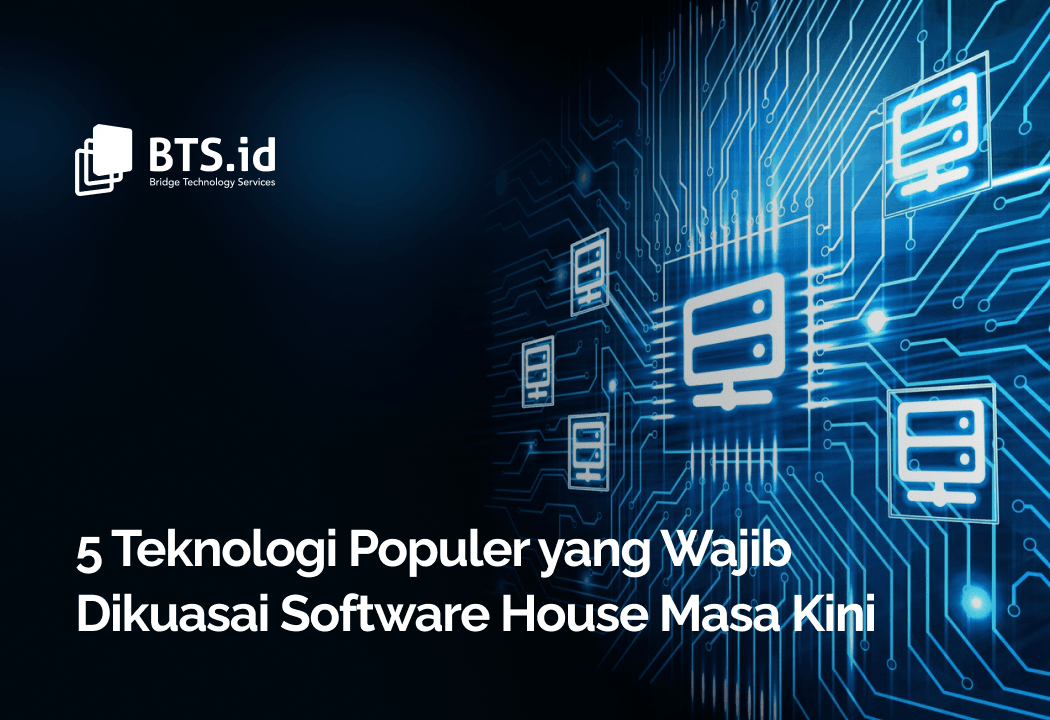
Di era modern yang ditandai dengan perkembangan teknologi yang pesat, transformasi digital menjadi kebutuhan mendesak bagi perusahaan yang ingin tetap relevan dan kompetitif. Salah satu aktor utama dalam proses ini adalah software house.
Teknologi berkembang sangat cepat, baik dari sisi bahasa pemrograman, framework, hingga arsitektur sistem.
Penting bagi software house untuk mengikuti perkembangan teknologi karena hal ini menentukan daya saing, relevansi, dan keberhasilan jangka panjang. Software house yang tidak beradaptasi akan kalah dari kompetitor yang lebih inovatif.
Software house merupakan perusahaan yang menyediakan layanan software development untuk memenuhi kebutuhan bisnis, mulai dari pembuatan aplikasi, website, hingga sistem manajemen internal. Berbeda dengan perusahaan IT umum, software house lebih fokus pada pengembangan solusi yang disesuaikan dengan kebutuhan spesifik klien mereka.
Transformasi digital tidak hanya tentang adopsi teknologi baru, tetapi juga perubahan menyeluruh dalam cara bisnis beroperasi dan memberikan nilai kepada pelanggan.
Mengikuti perkembangan teknologi bukan hanya sekedar tren, tetapi strategi bisnis bagi software house.
Hal ini membantu menjaga daya saing, memberi nilai tambah bagi klien, meningkatkan efisiensi. menjaga keamanan, dan membuka peluang pasar baru. Software house yang adaptif terhadap perubahan akan lebih mudah berkembang dan bertahan di tengah persaingan industri.

Dampak teknologi terhadap daya saing dan efisiensi kerja khususnya bagi software house dimana teknologi dapat menjadi faktor pembeda utama antara software house yang unggul dan tertinggal. Teknologi baru seperti Artificial Intelligence (AI), Cloud Computing, dan Microservices memungkinkan software house menciptakan produk dengan fitur yang lebih canggih, dimana AI digunakan untuk personalisasi aplikasi, meningkatkan pengalaman pengguna, sehingga inovasi produk dapat lebih cepat.
Selain itu software house juga lebih adaptif terhadap tren pasar, sehingga perubahan kebutuhan klien dapat direspons lebih cepat jika software house menguasai teknologi terkini.
Ada 5 teknologi yang wajib dikuasai oleh software house agar tetap relevan dan kompetitif di dunia teknologi.
Artikel ini akan membahas secara mendalam tentang 5 teknologi terkini yang penting untuk dikuasai oleh software house agar tetap kompetitif dan relevan:

- Artificial Intelligence (AI) dan Machine Learning (ML)
Integrasi Artificial Intelligence (AI) dan Machine Learning (ML) dalam software development kini menjadi standar industri. Fungsinya meningkatkan kemampuan aplikasi dalam pengambilan keputusan otomatis, analisis data, dan personalisasi serta membuka peluang pasar baru di berbagai industri seperti fintech, e-commerce, dan kesehatan.
AI dan Machine Learning Integration wajib dikuasai, AI adalah salah satu teknologi yang membuka peluang besar. Dengan AI, dapat tercipta aplikasi yang lebih cerdas, seperti chatbot untuk customer service atau sistem prediksi untuk bisnis.
Contoh Penerapannya:
• Chat GPT dan model generatif AI untuk otomatisasi kode
• Rekomendasi produk berbasis perilaku pengguna
• TensorFlow/Pytorch untuk pengembangan fitur cerdas
• Analisis prediktif untuk bisnis
Tools populer di bidang machine learning dan AI beserta penjelasannya:- TensorFlow
Fungsi utama: Framework open-source untuk deep learning.
Digunakan untuk membangun dan melatih model machine learning berskala besar, termasuk neural network, computer vision, dan natural language processing. - PyTorch
Fungsi utama: Framework deep learning berbasis Python.
Populer di kalangan peneliti dan praktisi karena sintaks yang fleksibel dan mudah digunakan untuk eksperimen model AI. Banyak dipakai untuk riset dan prototyping - Scikit-learn
Fungsi utama: Library Python untuk machine learning tradisional.
Cocok untuk data preprocessing, classification, regression. clustering. dan model evaluation.
Umumnya digunakan pada dataset berukuran kecil hingga menengah.
- TensorFlow
- Cloud Computing
Komputasi Awan, atau cloud computing, adalah cara menyediakan layanan komputasi seperti server, storage, atau software melalui internet. Berfungsi menyediakan infrastruktur, platform, dan layanan secara fleksibel melalui internet, memiliki benefit skalabilitas tinggi, hemat biaya infrastruktur, dan mendukung kolaborasi tim jarak jauh.
Komputasi awan atau cloud computing menjadi salah satu teknologi yang wajib dikuasai developer karena hampir semua aplikasi modern berjalan di cloud.
Contoh Penerapannya:
• Hosting aplikasi berbasis cloud (AWS, Azure, GCP)
• Serverless computing untuk menghemat biaya.
• Cloud storage dan database terkelola
• Edge Computing dimana data diproses lebih cepat di perangkat terdekat, bukan hanya di server jauh
• Hybrid dan Multi-Cloud merupakan kombinasi cloud publik dan privat yang menjadi tren untuk fleksibilitas,
Software house sebaiknya cloud-ready karena kebutuhan pasar dan teknologi saat ini menuntut aplikasi yang scalable dan andal.
• Scalability (Skalabilitas): Cloud memudahkan aplikasi untuk menambah kapasitas tanpa perlu membeli server fisik baru. Cloud dapat scale-up (menambah kapasitas) atau scale-down (mengurangi kapasitas) secara otomatis sesuai beban kerja. Saat aplikasi e-commerce menghadapi lonjakan traffic saat promo, cloud memungkinkan peningkatan kapasitas server secara cepat.
• Reliability (Keandalan): Infrastruktur cloud biasanya memiliki sistem failover dan replikasi otomatis sehingga layanan tetap berjalan walau ada gangguan di salah satu server. Cloud juga menyediakan cadangan data dan backup otomatis, memudahkan pemulihan saat terjadi insiden. Data dan aplikasi dapat diakses dari berbagai lokasi dengan latensi rendah melalui pusat data global.
- DevOps dan Otomatisasi
DevOps dan otomatisasi adalah dua konsep yang sangat berkaitan erat. Otomatisasi adalah inti dari DevOps, memungkinkan tim untuk mempercepat proses pengembangan dan penerapan software, meningkatkan efisiensi, dan mengurangi kesalahan manual. Dengan mengotomatiskan tugas-tugas berulang dan manual, DevOps dapat mencapai siklus rilis lebih cepat, kualitas yang lebih tinggi, dan kolaborasi yang lebih baik antar tim pengembangan dan operasional, mempercepat pengembangan, meminimalkan kesalahan manusia, dan meningkatkan kualitas software.
Contoh Penerapannya:
• Continuous Integration/Continuous Deployment (CI/CD) pipelines
• Containerization dengan Docker dan Kubernetes
• Infrastructure as Code (IaC)
Berikut penjelasan singkat tentang beberapa tools populer beserta fungsinya dalam software development:- Docker
Fungsi utama: Platform Containerization
Membuat, mengemas, dan menjalankan aplikasi dalam container yang portable sehingga mudah dijalankan di berbagai lingkungan tanpa konflik konfigurasi. - Kubernetes
Fungsi utama: Container Orchestration
Mengatur dan mengelola container (misal Docker) dalam skala besar, termasuk otomatisasi deployment, scaling, dan manajemen sumber daya. - Jenkins
Fungsi utama: Automation server untuk CI/CD
Mengotomatiskan build, pengujian, dan deployment langsung dari repositori GitLab, serta memudahkan kolaborasi tim developer.
Integrasi antara tim development (Dev) dan Operation (Ops) atau yang biasa dikenal sebagai DevOps, sangat penting untuk menciptakan workflow yang lebih mulus, cepat, dan andal.
Sebelumnya tim dev fokus membuat fitur, sementara rim ops fokus menjaga stabilitas sistem.
Integrasi membuat keduanya bekerja sama sejak awal.
Perubahan kode bisa lebih cepat masuk ke produksi tanpa hambatan birokrasi, sehingga mempercepat siklus rilis. Masalah dapat dideteksi lebih awal melalui otomatisasi pengujian dan monitoring sehingga meningkatkan kualitas dan keandalan.

- Docker
- Cybersecurity dan Data Privacy
Keamanan cyber atau cybersecurity adalah upaya melindungi sistem jaringan, dan data dari serangan digital seperti hacking, malware. atau pencurian data. Di dunia yang makin terkoneksi, hal ini menjadi prioritas utama.
Cybersecurity adalah teknologi yang tidak boleh dilewati. Developer harus memastikan aplikasi aman dari ancaman, mengingat data user merupakan aset berharga. Tanpa keamanan dan reputasi, bisnis menjadi rentan dan mudah hancur. Kepercayaan klien harus terjaga, kerugian finansial akibat serangan dapat dihindari, dan memenuhi regulasi keamanan.
Contoh Penerapannya:
• Enkripsi data end-to-end
• Multi-factor authentication (MFA)
• Monitoring keamanan real time
Shift-left-security adalah pendekatan keamanan dimana pengujian dan penerapan keamanan dilakukan sejak tahap awal pengembangan perangkat lunak, bukan menunggu sampai tahap akhir atau setelah rilis.
Hal ini penting bagi software house karena beberapa hal dibawah ini:- Mengurangi Biaya Perbaikan Bug Keamanan
Semakin awal celah ditemukan, semakin murah biaya perbaikannya. (Bug yang ditemukan setelah rilis bisa memakan biaya hingga 30x lebih mahal dibanding saat coding) - Meminimalkan Resiko Serangan
Aplikasi yang dirilis tanpa pengujian keamanan dini rentan menjadi target eksploitasi. - Mempercepat Rilis Produk
Dengan keamanan bawaan (security by design), resiko delay akibat perbaikan di akhir tahap pengembangan dapat dihindari. - Meningkatkan Kepercayaan Klien
Klien akan lebih percaya jika tahu software house mengutamakan keamanan sejak awal.
Teknologi dan praktik keamanan yang penting untuk software house beserta penjelasannya:- Enkripsi (Encryption)
Fungsi: Mengamankan data dengan mengubahnya menjadi format yang tidak bisa dibaca tanpa kunci. Melindungi data sensitif (data at rest dan data in transit). Mengurangi resiko kebocoran data meski server dibobol.
Beberapa jenisnya:
✓ Enkripsi simetris (misal AES) : Satu kunci digunakan untuk enkripsi dan dekripsi
✓ Enkripsi Asimetris (misal RSA): Pasangan kunci duplikat dan privat.
✓ LS/SSL: Mengamankan komunikasi jaringan (HTTPS) - OWASP Top 10
Daftar sepuluh resiko keamanan web paling umum yang dirilis oleh Open Web Application Security Project (OWASP). Menjadi panduan standar untuk membangun aplikasi yang aman. Membantu tim dev fokus pada ancaman paling kritis.
Contoh kategori resiko:- Broken Access Control
- Cryptographic Failures
- Injection (SQL Injection, Command Injection)
- Insecure Design
- Security Misconfiguration
- Vulnerable and Outdated Components
- Identification and Authentication Failures
- Software and Data Integrity Failures
- Security Logging and Monitoring Failures
- Server-Side Request Forgery (SSRF)
- Audit Keamanan (Security Audit)
Fungsi: Mengevaluasi keamanan sistem secara menyeluruh melalui pemeriksaan teknis dan prosedural. Mengidentifikasi celah keamanan sebelum dimanfaatkan penyerang. Memberikan rekomendasi teknis untuk perbaikan, meningkatkan kepatuhan terhadap standar keamanan (misal: ISO 27001, PCI-DSS)
Jenis:
✓ Audit Internal: Dilakukan oleh tim internal untuk evaluasi rutin.
✓ Audit Eksternal: Dilakukan oleh pihak ketiga untuk penilaian independen.
✓ Penetration Testing: Simulasi serangan untuk menguji ketahanan sistem.
- Enkripsi (Encryption)
- Mengurangi Biaya Perbaikan Bug Keamanan
- Progressive Web App (PWA) dan Mobile-First Development
- Progressive Web App (PWA)
Adalah aplikasi web yang memiliki pengalaman layaknya aplikasi native di perangkat mobile maupun desktop.- Ciri khas:
- Offline-ready: Bisa berjalan meski tanpa koneksi internet melalui service worker.
- Installable: Dapat dipasang di home screen tanpa melalui App Store/Play Store.
- Responsif: menyesuaikan dengan ukuran layar perangkat
- Push Notifications: Dapat mengirimkan notifikasi seperti aplikasi native.
- Keunggulan:
- Biaya lebih rendah dibanding membuat aplikasi native terpisah untuk Android dan iOS.
- Akses cepat karena bisa dibuka langsung dari browser
- Performa ringan dengan loading cepat.
- Jangkauan luas karena bisa diakses dari berbagai perangkat.
- Ciri khas:
- Mobile-First Development
Mobile-first adalah pendekatan pengembangan aplikasi atau web yang mengutamakan desain dan fungsi untuk perangkat mobile terlebih dahulu, kemudian menyesuaikan untuk layar yang lebih besar (tablet/desktop).- Keunggulan:
- Lebih relevan karena mayoritas pengguna internet mengakses melalui smartphone.
- Meningkatkan pengalaman pengguna (user experience) pada perangkat mobile.
- Mendukung SEO karena Google mengutamakan mobile-first indexing.
- Contoh Penerapannya:
- Website e-commerce seperti Tokopedia dan Shopee yang cepat diakses dari mobile.
- Aplikasi web perusahaan dengan antarmuka ringan dan intuitif di smartphone.
- Keunggulan:
- Kombinasi PWA+Mobile First
Jika digabungkan PWA yang dikembangkan dengan pendekatan mobile-first akan menghasilkan:- Aplikasi yang ringan,cepat,dan bisa diinstal layaknya aplikasi native.
- Pengalaman pengguna yang optimal di perangkat mobile tanpa mengorbankan akses desktop.
- Potensi konversi dan engagement yang lebih tinggi bagi bisnis.
- Progressive Web App (PWA)
Adaptasi terhadap perilaku pengguna yang mobile-centric penting bagi software house karena mayoritas interaksi digital saat ini dilakukan melalui smartphone.
Pengguna smartphone yang dominan menunjukkan bahwa lebih dari 60-70% akses internet dilakukan via perangkat mobile.
Perilaku pengguna berbeda-beda, waktu interaksi yang singkat, orientasi layar vertikal, dan fokus pada kemudahan akses. Pengguna yang mobile-centric baik untuk e-commerce, layanan publik, hingga aplikasi produktivitas.
Beberapa framework populer yang penting untuk dikuasai oleh software house beserta penjelasannya adalah:
- React
Jenis: JavaScript library (bukan full framework) untuk membangun UI interaktif.
Pengembang: Meta (Facebook)
Kelebihan:- Komponen Reusable: Mempercepat pengembangan
- Virtual DOM: Performa rendering lebih cepat
- Ekosistem Luas: Banyak library pendukung seperti Next,js , Redux
Cocok untuk: Website modern dan aplikasi web kompleks dan PWA (Progressive Web App)
- Flutter
Jenis: Framework open-source untuk membangun aplikasi mobile, web, dan desktop.
Pengembang: Google
Kelebihan:- Cross-Platform: Satu kode untuk Android, iOS, web bahkan desktop
- UI konsisten di semua platform karena menggunakan rendering engine sendiri.
- Hot Reload: Perubahan kode langsung terlihat saat pengembangan
Kekurangan: - Ukuran file aplikasi relatif besar.
- Performa pada aplikasi sangat kompleks, kadang kalah dibanding native murni.
Cocok untuk: - Aplikasi mobile lintas platform
- Startup yang ingin hemat waktu dan biaya
Cocok untuk: Google Ads app, Alibaba, Reflectly.
- Angular
Jenis: JavaScript full-featured berbasis TypeScript
Pengembang: Google
Kelebihan:- MVC Architecture: Struktur kode rapi dan terorganisir
- Fitur Lengkap: Routing, form validation, dependency injection bawaan.
- Dukungan TypeScript: Lebih aman dan mudah dikelola pada proyek besar.
Kekurangan: - Kurva belajar relatif curam dibanding React/Flutter.
- Ukuran bundle awal cenderung besar.
Cocok untuk: - Aplikasi web skala besar dan kompleks
- Sistem manajemen dan dashboard
Contoh: Gmail, Google Cloud Console, Microsoft Office Online.
Menguasai AI dan Machine Learning, Cloud Computing, DevOps dan CI/CD, PWA dan Mobile First Development serta Framework Modern seperti React, Flutter, dan Angular adalah kunci bagi software house untuk tetap relevan, kompetitif, dan inovatif di era digital saat ini.
Kelima teknologi ini saling melengkapi:
- AI & ML membuka peluang inovasi berbasis data.
- Cloud Computing menyediakan infrastruktur fleksibel dan hemat biaya.
- DevOps & CI/CD mempercepat pengembangan dan menjaga kualitas.
- PWA & Mobile-First memastikan pengalaman pengguna optimal di era mobile-centric.
- Framework Modern mempercepat pembuatan aplikasi berkualitas tinggi di berbagai platform
Software house yang mampu mengadopsi dan mengintegrasikan kelima teknologi ini akan memiliki daya saing tinggi, efisiensi kerja lebih baik, serta mampu memberikan solusi teknologi yang relevan dan berkelanjutan untuk klien di berbagai industri.
Teknologi terus bergerak, dan masa depan dimiliki oleh mereka yang mau terus belajar dan berinovasi. Jadikan pembaruan pengetahuan dan eksplorasi teknologi baru sebagai kebiasaan di software house Anda. Mulailah hari ini, agar besok Anda yang memimpin.
Siap naik level teknologi?
Jangan tunggu sampai tertinggal.
Hubungi kami BTS.id untuk konsultasi teknologi terbaru atau lakukan audit kesiapan teknologi bisnis Anda bersama tim ahli kami BTS.id.
Mari mulai sekarang, dan pastikan perusahaan bisnis Anda siap menghadapi tantangan masa depan!
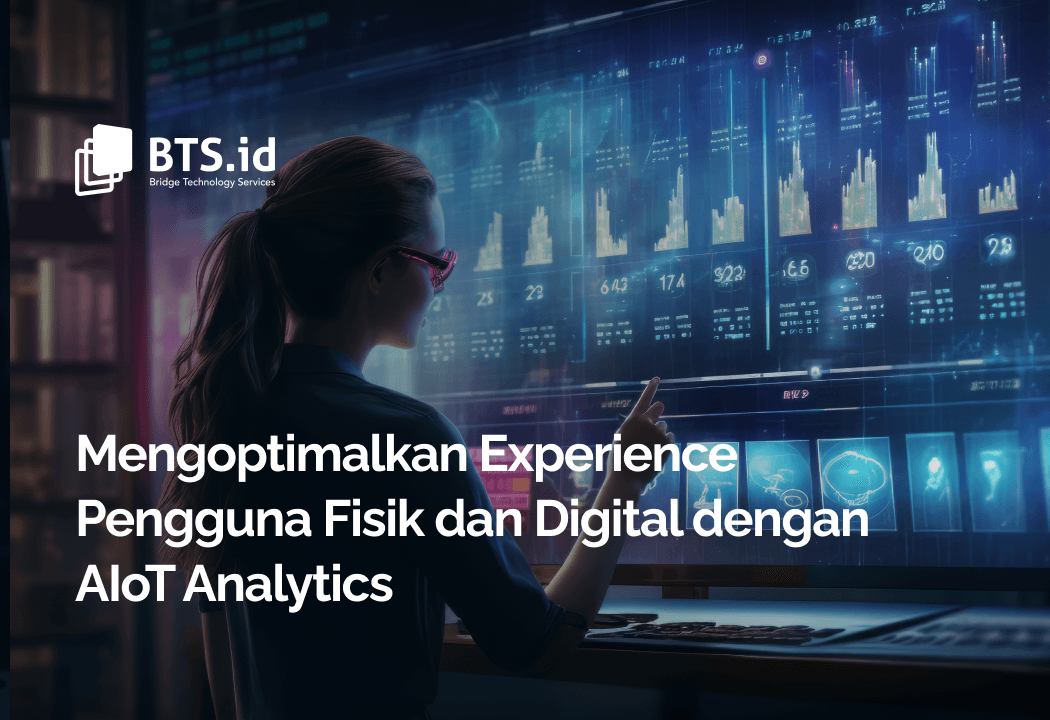
Internet of Things (IoT) dan Artificial Intelligence (AI) adalah dua topik terhangat di dunia teknologi, dimana kedua teknologi ini dapat saling bersimbiosis, tetapi peluang paling signifikan mungkin terletak pada penggunaan keduanya secara bersamaan, sehingga penting untuk merencanakan bagaimana keduanya dapat saling mendukung demi keuntungan pengguna perusahaan.
Di zaman yang serba canggih ini Artificial Intelligence of Things (AIoT), menyatukan dua kekuatan besar, yakni Artificial Intelligence (AI) dan Internet of Things (IoT) merupakan teknologi-teknologi baru yang bisa mengubah cara hidup kita sehari-hari.
Artificial Intelligence (AI) adalah teknologi yang memungkinkan mesin meniru kecerdasan manusia, seperti belajar, menganalisa data, mengambil keputusan, dan mengenali pola. AI telah berkembang pesat berkat kemajuan komputasi, ketersediaan big data, dan algoritma machine learning.
Internet of Things (IoT) merujuk pada jaringan perangkat fisik yang saling terhubung melalui internet, memungkinkan pengumpulan dan pertukaran data secara real time. Perangkat IoT seperti sensor, kamera, dan smart home devices yang kini banyak digunakan pada sektor industri, pertanian, kesehatan dan transportasi.
User Experience (UX) dalam AIoT adalah pengalaman pengguna saat berinteraksi dengan sistem yang menggabungkan Artificial Intelligence dan perangkat IoT.
Fokusnya adalah menciptakan interaksi yang intuitif, responsif, dan personal antara manusia dan teknologi yang terhubung, dengan tujuan agar pengguna bisa merasakan manfaat teknologi secara alami tanpa perlu memahami kompleksitas teknis di baliknya.

Menciptakan User Experience (UX) yang seamless antara dunia fisik dan digital adalah salah satu tantangan besar di era integrasi teknologi seperti IoT, Artificial Intelligence (AI), Augmented Reality (AR), dan Smart Devices.
Tantangan ini muncul karena pengguna kini mengharapkan transisi yang lancar, konsisten, dan intuitif saat berpindah dari interaksi fisik ke digital dan sebaliknya.
Beberapa tantangan umum dalam mewujudkan pengalaman pengguna yang seamless antara kedua dunia adalah:
- Konsisten Antarmuka dan Interaksi
Menjaga pengalaman pengguna tetap konsisten antara perangkat fisik (misal: kios, sensor, alat wearable) dan digital (aplikasi, situs web, dashboard)
Contoh: UX pada aplikasi mobile harus selaras dengan UX pada perangkat fisik seperti smartwatch atau smart home device. - Keterbatasan Konektivitas dan Integrasi Data
Perangkat IoT dan sistem fisik sering mengalami kendala konektivitas atau sinkronisasi data yang tidak real-time.
Contoh: Delay antara data sensor suhu fisik dengan dashboard digital dapat mengganggu keputusan pengguna. - Perbedaan Ekspektasi Pengguna
Pengguna memiliki harapan yang berbeda terhadap interaksi fisik (langsung, intuitif) dan digital (cepat, fleksibel).
Contoh: Menyalakan lampu secara manual vs. melalui aplikasi, kedua interaksi harus sama-sama mudah dan cepat. - Privasi dan Keamanan Data
Integrasi antara dunia fisik dan digital meningkatkan resiko pelanggaran data dan ketidakpercayaan pengguna.
Contoh: Kamera cerdas yang terhubung ke aplikasi bisa menimbulkan kekhawatiran jika aksesnya tidak diatur dengan jelas.
Apa itu AIoT?
Perkembangan teknologi Artificial Intelligence (AI) dan IoT telah menjadi pendorong utama transformasi digital
di berbagai sektor, mulai dari industri, pertanian, hingga kehidupan sehari-hari.
Gabungan antara Artificial intelligence (AI) dan IoT disebut AIoT (Artificial Intelligence of Things). Teknologi
ini memungkinkan perangkat tidak hanya mengumpulkan data, tetapi juga memahami serta mengambil
keputusan secara otomatis
AIoT adalah gabungan dari dua teknologi utama:
- Artificial Intelligence (AI): Kemampuan mesin untuk belajar, menganalisis, dan membuat keputusan dari data.
- Internet of Things (IoT): JAringan perangkat fisik yang saling terhubung dan mampu mengumpulkan serta bertukar data melalui internet.

AIoT dimana peran AI dalam Internet of Things adalah gabungan dari keduanya, merupakan ekosistem yang menggabungkan teknologi IoT dengan kemampuan kecerdasan buatan untuk membuat perangkat lebih pintar, lebih responsif, dan lebih efisien dalam menjalankan fungsinya.
Dengan AIoT, peran AI dalam Internet of Things, perangkat yang terhubung bisa ‘berpikir’ dan ‘memutuskan’ secara mandiri tanpa harus menunggu perintah manusia.
AIoT (Artificial Intelligence of Things) AI dalam personalisasi pengguna, membuka potensi luar biasa dalam behaviour analytics, karena memungkinkan perangkat tidak hanya mengumpulkan data dari dunia nyata, tapi juga memproses dan memahami perilaku manusia secara real time.
AIoT (Artificial Intelligence of Things) dimana peran AI dalam Internet of Things menjadi sangat penting dalam UX (User Experience) karena mampu menciptakan pengalaman pengguna yang lebih cerdas, responsif, personal, dan kontekstual. Di era dimana perangkat saling terhubung dan pengguna mengharapkan kemudahan tanpa gesekan (seamless), AIoT berperan sebagai ‘otak pintar’ di balik interaksi antara dunia fisik dan digital.
Mengapa AIoT penting dalam user experience (UX)?
- Menghadirkan Pengalaman yang Lebih Personal
AIoT dimana peran AI dalam Internet of Things memungkinkan sistem untuk belajar dari perilaku pengguna dan menyesuaikan interaksi secara real time.
Contoh: Smart home yang secara otomatis menyesuaikan pencahayaan dan suhu sesuai preferensi pengguna tanpa perlu perintah manual. - Meningkatkan Kecepatan dan Efisiensi Interaksi
Dengan artificial intelligence (AI) AI dalam personalisasi pengguna yang memproses data langsung dari sensor IoT, keputusan bisa diambil lebih cepat tanpa harus menunggu intervensi pengguna.
Contoh: Sistem kendaraan yang memperingatkan saat terdeteksi gaya mengemudi berisiko, secara langsung dan tepat waktu. - Pengalaman yang Lebih Kontekstual dan Relevan
AIoT dimana peran AI dalam Internet of Things mampu memahami konteks seperti lokasi, waktu, atau aktivitas, sehingga UX bisa disesuaikan dengan situasi pengguna.
Contoh: Di toko ritel, display menampilkan promosi berbeda tergantung pada siapa yang sedang lewat (berdasarkan data beacon atau ponsel). - Meningkatkan Rasa Aman dan Nyaman
AIoT memungkinkan perangkat mendeteksi potensi resiko atau gangguan dan mengambil tindakan preventif, sehingga meningkatkan kenyamanan pengguna.
Contoh: Kamera keamanan pintar yang mengenali wajah penghuni rumah dan hanya mengirim notifikasi saat deteksi wajah asing. - Membuat Transisi Fisik-Digital Menjadi Seamless
AIoT dimana peran AI dalam Internet of Things dapat menjembatani pengalaman antar dunia fisik dan digital dengan lebih mulus, pengguna bisa berpindah perangkat atau lingkungan tanpa kehilangan konteks.
Contoh: Aplikasi kesehatan yang sinkron dengan wearable device untuk melacak aktivitas, lalu memberikan rekomendasi latihan yang bisa langsung dijalankan lewat smart TV atau speaker pintar.
Artificial Intelligence (AI) juga membantu meningkatkan akurasi analisis data di IoT. Dengan menggunakan algoritma machine learning, Artificial Intelligence (AI), AI dalam personalisasi pengguna dapat mengidentifikasi pola dalam data yang sulit dideteksi manusia. Hal ini dapat membantu mengidentifikasi trend dan anomali, sehingga memungkinkan bisnis untuk membuat keputusan yang lebih tepat.
Artificial Intelligence (AI) juga dapat menghadirkan pengambilan keputusan dan kesadaran layaknya manusia ke dalam lingkungan IoT, yang dapat meningkatkan efisiensi dan memperbaiki proses.
Artificial Intelligence (AI) menawarkan banyak benefit jika dipadukan dengan Internet of Things (IoT).
Beberapa diantaranya:
- Peningkatan Efisiensi: Perangkat IoT bertenaga AI dapat mengotomatisasi tugas dan proses rutin, sehingga dapat memberikan benefit bisnis dapat beroperasi lebih efisien.
- Peningkatan Pengambilan Keputusan: AI dapat memproses data dalam jumlah besar dari perangkat IoT, sehingga bisa mendapatkan benefit dalam memberikan wawasan berharga dan memungkinkan pengambilan keputusan yang lebih baik.
- Peningkatan Keselamatan dan Keamanan: AI dalam personalisasi pengguna dapat meningkatkan keselamatan dan keamanan dalam berbagai konteks. Beberapa benefit dapat dilihat misalnya di smart city, AI dapat menganalisis data dari sensor dan kamera lalu lintas untuk mengoptimalkan arus lalu lintas dan mengurangi kecelakaan.
Di lingkungan industri, AI dalam personalisasi pengguna dapat memantau peralatan dan mendeteksi potensi masalah keselamatan sebelum menjadi serius, Demikian pula dalam keamanan siber, AI dapat menganalisis lalu lintas jaringan dan mengidentifikasi potensi ancaman.
Secara keseluruhan, kombinasi AI dan IoT berpotensi merevolusi berbagai industri, meningkatkan efisiensi, menyempurnakan pengambilan keputusan, meningkatkan keselamatan dan keamanan, serta memungkinkan pengalaman yang sangat personal.
Integrasi antara AIoT dan UX menjadi sangat krusial, terutama dalam konteks B2B (business-to business) dan produk digital yang kompleks, seperti sistem industri, dashboard analitik, atau aplikasi enterprise. Hal ini bukan hanya tentang membuat antarmuka menarik, tetapi menciptakan pengalaman pengguna yang efisien, presisi, dan berbasis data nyata.
Perilaku pengguna digital (User behaviour digital) dan perilaku pengguna fisik (user behaviour fisik) merujuk pada interaksi manusia dengan dunia digital dan dunia nyata masing-masing. Perbedaan utama terletak pada konteksnya, digital melibatkan interaksi dengan perangkat dan platform online, sedangkan fisik melibatkan interaksi langsung dengan lingkungan sekitar dan produk fisik.
User Behaviour Digital adalah tindakan dan aktivitas yang dilakukan seseorang dalam dunia digital, seperti mengunjungi situs web, berinteraksi di media sosial, atau menggunakan aplikasi.
User behaviour digital mengacu pada aktivitas pengguna saat berinteraksi dengan antarmuka digital seperti efektivitas desain UI dan pengalaman pengguna secara keseluruhan.
Beberapa contohnya seperti:
- Membuka aplikasi tertentu di ponsel
- Menjelajahi (scroll) media sosial
- Melakukan pembelian online
- Menggunakan mesin pencari
- Berpartisipasi dalam forum online
User Behaviour Fisik adalah interaksi langsung seorang dengan lingkungan fisik, termasuk benda-benda, orang lain, dan ruang. User behaviour fisik mencakup tindakan pengguna di dunia nyata, bagaimana mereka bergerak, beraktivitas, atau menggunakan perangkat fisik. Perilaku ini biasanya ditangkap menggunakan sensor, perangkat IoT, kamera, atau wearable device.
Beberapa contohnya seperti:
- Pergerakan pengguna di dalam ruangan (misal: melalui kamera atau sensor gerak)
- Lokasi pengguna (melalui GPS atau beacon)
- Pola penggunaan perangkat seperti AC, lampu, mesin produksi, dll.
- Aktivitas fisik seperti berjalan duduk, berinteraksi dengan alat
Karena Internet of Things berakar pada dunia fisik dan digital, maka akan ditemui beberapa kesulitan unik untuk aplikasi dan analisis.
AIoT Analytics adalah proses mengumpulkan, memproses, menganalisis, dan menindaklanjuti data yang dihasilkan dari perangkat IoT menggunakan artificial intelligence (AI) dan menggunakan aplikasi alat dan prosedur analisis data untuk mewujudkan nilai dari volume besar data yang dihasilkan oleh perangkat Internet of Things yang terhubung. Proses ini memungkinkan sistem untuk tidak hanya mengamati tetapi juga memahami dan bertindak terhadap perilaku, kondisi lingkungan, atau pola penggunaan.
Alur Kerja AIoT Secara Umum:
- Pengumpulan Data
Perangkat IoT yang dilengkapi dengan sensor, mengumpulkan data dari lingkungan. Data ini bisa berupa suhu, kelembaban, gerakan, tekanan, atau data lainnya yang relevan dengan aplikasi IoT. - Pengiriman Data
Data yang dikumpulkan oleh perangkat IoT kemudian dikirimkan melalui jaringan, biasanya internet, ke pusat pemrosesan data (cloud atau server) - Pemrosesan Data
Data yang diterima di pusat akan diproses menggunakan perangkat lunak dan algoritma tertentu.
Pemrosesan ini bisa melibatkan pembersihan data, penggabungan data dari berbagai sumber, transformasi data, dan agresi data. - Analisis Data
Setelah data diproses, langkah selanjutnya adalah analisis data untuk mendapatkan wawasan yang berguna. Analisis ini bisa mencakup analisis deskriptif (menjelaskan apa yang terjadi), analisis diagnostik (menjelaskan mengapa sesuatu terjadi), analisis prediktif (memprediksi apa yang mungkin terjadi), dan analisis preskriptif (merekomendasikan tindakan berdasarkan analisis). - Visualisasi dan Aksi
Hasil analisis data kemudian divisualisasikan dalam bentuk grafik, tabel, atau laporan. Informasi ini kemudian digunakan untuk membuat keputusan, atau memberikan feedback kepada pengguna.
Berikut adalah beberapa contoh penerapan nyata AIoT Analytics yang menggambarkan bagaimana teknologi ini bekerja dan memberikan manfaat secara langsung dalam kehidupan atau bisnis:
- Smart Retail
Menyesuaikan display dengan pola pengunjung. Sebuah pusat perbelanjaan besar menggunakan kamera AI dan sensor pergerakan untuk memantau jalur pengunjung. Sistem AIoT analytics
mempelajari area mana saja yang paling ramai pada jam-jam tertentu.
Setiap pagi, sistem mengatur ulang kembali tampilan promosi digital (digital signage) berdasarkan pola kunjungan.
Misalnya jam 12 siang area food court menjadi sangat ramai, maka iklan makanan cepat saji akan ditampilkan di layar.
Hasilnya: Konversi promosi meningkat 35% karena penempatan konten sesuai dengan perilaku real time pengunjung. - Smart Manufacturing
Prediksi kerusakan mesin. Di sebuah pabrik elektronik di Batam, seluruh mesin produksi dilengkapi dengan sensor getaran dan suhu.
Setiap hari, data dikirim ke sistem AIoT analytics yang menganalisis pola kerja mesin. Suatu hari, sistem mendeteksi getaran abnormal di salah satu mesin solder otomatis, berbeda dari pola biasanya.
Sebelum mesin benar-benar rusak, sistem mengirim peringatan ke teknisis melalui dashboard dan email. Teknisi pun segera melakukan pemeriksaan dan mengganti komponen yang hampir rusak.
Hasilnya: Produksi tidak terganggu, downtime dicegah, dan biaya perbaikan besar bisa dihindari.

AIoT Analytics membawa UX ke level yang lebih tinggi dengan menyatukan data perilaku digital dan aktivitas fisik pengguna melalui sensor, perangkat IoT, dan AI. Dengan pemahaman lebih dalam tentang konteks pengguna, AIoT memungkinkan pengalaman yang lebih responsif, personal dan proaktif.
Berikut adalah benefit utamanya:
- Personalisasi Lintas Kanal (Omnichannel Personalization): Kunci Pengalaman yang Konsisten dan Relevan
Benefit yang bisa didapat adalah personalisasi omnichannel, merupakan kemampuan sistem untuk memberikan pengalaman yang konsisten, terintegrasi, dan relevan kepada pengguna di berbagai titik kontak, berdasarkan data perilaku dan preferensi pengguna dari berbagai sumber. - Transisi Seamless antara Fisik dan Digital
AIoT Analytics mendeteksi aktivitas pengguna di dunia nyata dan menyesuaikan elemen digitalnya tanpa interupsi.
Contoh: saat pengguna memasuki ruangan tampilan dashboard berubah otomatis mengikuti ruangan atau perangkat yang digunakan. Hal ini memberikan benefit pengalaman menjadi mulus dan tidak memerlukan tindakan tambahan dari pengguna. - Aksi Otomatis dan Proaktif yang Mengurangi Beban Interaksi
Dengan artificial intelligence (AI) dalam personalisasi pengguna, yang menganalisis pola, sistem bisa mengambil keputusan sendiri untuk mempercepat pengalaman pengguna.
Contoh: Pendingin ruangan menyala otomatis sebelum pengguna tiba di rumah berdasarkan lokasi GPS. Benefit yang didapat adalah mengurangi langkah manual, mempercepat proses, dan meningkatkan kenyamanan. - Pemahaman Lebih Dalam terhadap Journey Pengguna
AIoT Analytics memberikan insight tentang perilaku lintas-perangkat dan lintas-lokasi yang tidak bisa dilihat dari data digital saja.
Contoh: Sistem belajar mengenali bahwa pengguna hanya menyelesaikan tugas saat berada di ruang santai. Benefit yang didapat dimana tim UX bisa merancang alur interaksi berdasarkan data nyata, bukan asumsi.
Meskipun AIoT Analytics dan omnichannel personalization menawarkan potensi luar biasa untuk menciptakan pengalaman pengguna yang seamless dan personal, implementasinya juga membawa berbagai tantangan strategis, teknis, dan etis.
Berikut adalah hal-hal yang wajib diperhatikan:
- Privasi dan Keamanan Data
AIoT dan personalisasi lintas kanal sangat bergantung pada pengumpulan dan pemrosesan data pengguna, baik data digital maupun data fisik. Pengguna menjadi lebih sadar soal hak privasi. Regulasi seperti undang-undang dan lainnya mengharuskan perusahaan transparan dalam penggunaan data. - Integrasi dan Keamanan Data
Menggabungkan berbagai sumber data dari sensor fisik, aplikasi, CRM, hingga e-commerce platform memerlukan arsitektur teknologi yang matang.
Tantangannya adalah sistem lama (legacy systems) sulit terhubung dengan platform baru, serta data silo menghambat penyatuan informasi pengguna secara utuh. - Kualitas dan Interpretasi Data
AI hanya sebaik data yang dimilikinya. Data dari sensor IoT bisa noisy, tidak relevan, atau salah baca, dan ini dapat mempengaruhi akurasi personalisasi.
Tantangannya adalah data fisik bisa berubah tergantung konteks (gerakan, cahaya, cuaca) dan data perilaku tidak selalu mewakili intensi pengguna sebenarnya. - Pengalaman yang Tidak Konsisten
Jika dirancang dengan benar, omnichannel UX justru bisa membingungkan, pengguna mengalami tampilan, fitur, atau logika berbeda di setiap kanal.
Tantangannya adalah tim produk atau desain bekerja terpisah antar kanal, serta informasi tidak sinkron antar perangkat.
Mengadopsi teknologi AIoT (Artificial Intelligence of Things) dalam dunia B2B tidak lagi sekedar inovasi, melainkan kebutuhan untuk menghadirkan sistem yang cerdas, efisien, dan proaktif. AIoT menggabungkan
kekuatan analitik AI dengan konektivitas dan sensor IoT, sehingga memungkinkan bisnis memantau memprediksi, dan mengoptimalkan proses dalam skala besar secara real time.
Namun karena kompleksitas dan skala dalam B2B lebih tinggi dibanding B2C, penerapannya memerlukan strategi matang.
Berikut adalah rekomendasi utama untuk bisnis B2B dan software house:
- Mulailah dari Tujuan UX dan Masalah Nyata Pengguna
Alih-alih langsung fokus pada teknologi, awali dengan pertanyaan:- Masalah apa yang dialami pengguna B2B saat berinteraksi dengan sistem Anda?
- Di titik mana mereka merasa tidak efisien, tidak relevan, atau kehilangan konteks?
- Bermitra dengan Software House yang Paham AIoT dan Behavioral UX
Software house Anda harus lebih dari sekedar ‘developer’.
Mereka perlu:- Mengerti arsitektur AIoT dan integrasi sistem kompleks
- Memahami UX research, behaviour analytics, dan desain satu sama lain.
- Integrasikan Sistem Digital dan Fisik Secara Modular
Bisnis B2b sering memiliki sistem ERP, CRM, perangkat industri, dan dashboard terpisah. Modul-modul ini harus dapat berkomunikasi satu sama lain. - Memilih Partner Teknologi atau Software House untuk Proyek AIoT dan UX Cerdas
Mengembangkan solusi digital berbasis AIoT (Artificial Intelligence of Things) bukan hal sederhana, terlebih dalam konteks B2B, industri, atau enterprise, Butuh mitra teknologi yang bukan hanya bisa coding, tetapi juga mampu memahami strategi bisnis, mampu mengintegrasikan sistem fisik dan digital, berpengalaman dalam manajemen dan data AI serta sensitif terhadap keamanan dan kepatuhan.
Beberapa kriteria utama yang perlu dipertimbangkan sebelum memilih software house atau partner teknologi adalah sebagai berikut:- Memastikan software house benar-benar menguasai ekosistem teknologi AIoT secara mendalam.
- Kemampuan integrasi sistem yang kompatibel dengan lingkungan B2B. Dalam dunia B2B, sistem yang digunakan sering kompleks, contoh ERP, CRM, SCADA, sistem, industri legacy dll.
- Software house fokus pada business outcome, bukan sekadar deliverable teknis. Software house bukan hanya mengerjakan ‘fitur’, tetapi juga membantu menyusun roadmap teknologi, menganalisis resiko dan peluang serta memberi insight dari sisi dan perilaku pengguna.
- Software house harus memiliki pengalaman dalam riset pengguna dan validasi UX, karena proyek ini akan menyentuh sisi fisik dan digital pengguna.
Di era digital yang semakin kompleks dan kontekstual, pengalaman pengguna tidak lagi terbatas pada apa yang terjadi di layar. Interaksi kini meluas hingga ke dunia nyata, dari gerakan fisik, lokasi, hingga perilaku terhadap perangkat dan lingkungan sekitar. AIoT hadir sebagai kunci untuk menjembatani realitas digital dan fisik tersebut.
Dengan memanfaatkan AIoT secara strategis, bisnis tidak hanya dapat menciptakan UX yang lebih pintar dan efisien, tapi juga membentuk sistem yang benar-benar human-centric, adaptif terhadap konteks dan mampu menghadirkan pengalaman yang mulus di antara dunia digital dan fisik.
Di tengah akselerasi teknologi dan meningkatnya ekspektasi pengguna, AIoT bukan lagi pilihan opsional, melainkan fondasi masa depan pengalaman pengguna yang menyatu antara fisik dan digital.
Jika Anda adalah pelaku B2B, pemilik produk digital kompleks, atau penyedia solusi teknologi, maka sekaranglah saat yang tepat untuk mulai mengevaluasi sistem, proses, dan infrastruktur Anda.
Saatnya Anda melakukan evaluasi sistem Anda: Apakah Sudah Siap Untuk Era AIoT?
- Apakah sistem Anda sudah mengumpulkan data perilaku pengguna secara menyeluruh (digital dan fisik)?
- Apakah Anda memiliki visibilitas real time terhadap interaksi pengguna di berbagai titik kontak?
- Apakah arsitektur sistem Anda siap diintegrasikan dengan perangkat IoT dan modul AI?
- Apakah pengalaman pengguna Anda sudah responsif terhadap konteks dunia nyata?
Memilih Internet of Things Analytics yang baik dan sesuai kebutuhan industri akan sangat membantu industri untuk mengembangkan bisnisnya. Untuk itu kami merekomendasikan IoT Analytics dari BTS.id.
BTS.id adalah solusi IoT Analytics terbaik untuk industri Anda. Sebagai salah satu provider Internet of things IoT Analytics terbaik, Anda akan mendapatkan berbagai analisis Internet of things Analytics yang dapat membantu bisnis Anda. BTS.id menawarkan solusi Internet of things Analytics untuk membantu industri Anda.
WHAT’S ON TODAY TECH SCENE
BRIDGE TECHNOLOGY SERVICES

Software Development Company Insights: Why AI Is Essential for Modern Manufacturing
In today’s modern manufacturing landscape, software is a core driver of efficiency, integration, and innovation.
As a trusted software development company, we go beyond building technology, we act as strategic digital transformation partners for manufacturing businesses.
We design and develop custom software solutions tailored to manufacturing operations, including production systems, inventory management, machine integration, and real time data platforms. Our solutions are built to support industry 4.0 initiatives, AI-driven automation, and smart factory environments.
Unlike off-the-shelf software, our custom manufacturing solutions are flexible, scalable, and secure designed to adapt to evolving market demands and operational complexity. Software serves as the critical link between business processes, industrial machines, and data intelligence.
We help manufacturers transform complex operational challenges into reliable, measurable, and future-ready software systems that improve productivity, visibility, and long term competitiveness.

Key contributions of a software development company in modern manufacturing.
- Development of integrated systems such as ERP, MES, and supply chain management tailored to factory workflows.
- Implementation of IoT and AI for real time production monitoring, predictive maintenance, and machine performance optimization.
- Automation and data analytics that enable data-driven decision-making, reduce downtime, and improve product quality.
- System security and scalability to ensure manufacturing operations remain reliable as the business grows.
In modern manufacturing, software development is the core of digital transformation. Without software, digital transformation cannot succeed, as every process from production planning to decision making relies on integrated digital systems.
- Software Development as the Foundation of Digital Transformation
Digital transformation in manufacturing begins with system modernization through software, software enables the digitization of manual processes, cross department data integration, and real time operation visibility. Systems such as ERP, MES, and industrial data platforms form the core foundation of this transformation.
- Software as the Driver of Manufacturing Automation
Manufacturing automation does not rely solely on machines, but on software that controls, orchestrates, and optimizes automated processes. Software plays a key role in:
• Automatically controlling production workflows.
• Integrating machines, robots, and IoT sensors
• Enabling data driven quality control and maintenance.
Without the right software, automation cannot be efficient or scalable.
- Software as the Brain of Smart Factories
Smart factories represent the highest evolution of modern manufacturing, with software acting as the central brain. Through AI development, analytics, and real time monitoring systems, software enables factories to:- Predict machine failures through predictive maintenance.
- Adaptively optimize production processes
- Respond quickly to changing market demands.
- End to End Integration for Future Ready Operations
Custom software development connects the entire manufacturing ecosystem from supply chain and production to distribution into a single integrated system. This creates operations that are more agile, efficient, and prepared to meet future industrial challenges.
Digital transformation provides strategic direction, manufacturing automation delivers efficiency, and smart factories enable operational intelligence. Software development serves as the connecting element between all three, making it a key factor in the success of competitive and sustainable modern manufacturing.
The Rise of Artificial Intelligence in Manufacturing Processes
The manufacturing industry is undergoing a major transformation driven by the increasing adoption of artificial intelligence in manufacturing.
Artificial Intelligence (AI) is no longer merely supporting technology, it has become a core component in creating production processes that are more efficient, intelligent, and competitive.
From automation to data driven decision making, Artificial Intelligence (AI) is reshaping how factories operate in the modern industrial era. Artificial intelligence (AI) plays an increasingly critical role in manufacturing due to its ability to process large volumes of data, identify patterns, and make fast, accurate decisions.
Artificial Intelligence in Manufacturing: The Foundation of Smart Manufacturing
AI development in manufacturing is used to improve production efficiency, product quality, and operational reliability. By leveraging data from machines, sensors, and production systems, artificial intelligence enables manufacturers to analyze production data in real time, identify operational patterns, and continuously optimize processes.
With the right software support, AI development helps increase productivity, reduce human error, and maintain consistent product quality forming the foundation of smart, data-driven manufacturing operations.
Industrial AI Applications for Operational Efficiency
The application of AI in industry spans multiple areas, including:
- Production data analysis to increase output and reduce waste
- Computer vision for automated quality inspection
- Supply chain optimization and production planning
Today, a wide range of industrial artificial intelligence (AI) applications are being implemented across manufacturing environments, from production analytics and computer vision based quality inspection to supply chain optimization.
These applications enable manufactures to make faster, more accurate while simultaneously reducing operational costs. Compared to manual approaches, AI driven solutions deliver greater speed, precision, and consistency in operational decision making.
AI-Powered Production Lines: Adaptive and Flexible Manufacturing
AI-powered production lines can automatically adjust production speed, workflows, and operating parameters based on real time data. The result is a production process that is more flexible, consistent, and capable of responding to changing market demand without compromising product quality.
By adapting dynamically to machine conditions, market demand, and material availability, AI-powered production lines, supported by intelligent software, become more scalable, resilient, and ready to handle the rapid pace of modern industrial change.
Predictive Maintenance: Reducing Downtime with AI
One of the most significant benefits of AI development in manufacturing is predictive maintenance. By analyzing historical data and current machine conditions, AI can predict potential failures before they occur.
This approach helps manufacturers reduce unexpected downtime, lower maintenance costs, extend asset lifespan, and improve overall operational reliability.
The Role of a Software Development Company in AI Manufacturing
As a software development company, we design, develop, and integrate AI solutions tailored to manufacturing needs. From industrial data processing and custom AI system development to seamless integration with ERP and MES platforms, software plays a critical role in ensuring successful AI adoption in modern factories. The rise of artificial intelligence (AI) in manufacturing processes marks a major shift towards smarter, more efficient, and data driven factories.
Key benefits of Integrating AI with Manufacturing Systems
Integrating Artificial Intelligence (AI) with manufacturing systems has become a strategic move for companies aiming to improve operational efficiency and competitiveness. By leveraging AI-driven efficiency, automation and real time data analytics, modern manufacturing operations can become smarter, faster, and more accurate.
Some of the key benefits include:
- AI-Driven Efficiency in Manufacturing Process
The first key benefit is AI-driven efficiency, which enables manufacturing systems to automatically optimize production processes based on real time data. AI helps streamline workflows, reduce bottlenecks, and improve machine utilization. The result is higher productivity without the need for significant additional resources. - Cost Reduction Through Automation
One of the primary benefits of AI integration is cost reduction through automation. AI reduces reliance on manual processes, minimizes human error, and lowers operational costs. In addition, AI-powered automation helps manufacturers reduce downtime, material waste, and unplanned maintenance expenses - Improve Product Quality with AI
Another important benefit is improved product quality with AI development, achieved through consistent quality monitoring and analysis. Using technologies such as computer vision and machine learning, AI can detect product defects in real time and ensure quality standards are consistently met.
This leads to higher customer satisfaction while reducing defects and rework. - Real-Time Data Analytics for Faster Decision-Making
AI integration enables real-time data analytics that provide full visibility into production conditions.
Data from machines, sensors, and production systems are analyzed instantly to support faster and more accurate decision-making. With data-driven insights, manufacturers can proactively respond to issues and opportunities. - The Role of Software Development Companies in AI Integration
Software development companies play a critical role in integrating AI into existing manufacturing systems. Through custom solution development, ERP and MES integration, and the deployment of secure and scalable AI technologies, software developers ensure that AI delivers measurable and sustainable business impact.
Challenges and Considerations When Implementing AI Solutions
Although Artificial Intelligence (AI) offers significant benefits to the manufacturing industry, its implementation comes with various challenges. Understanding AI integration challenges, data security in manufacturing, effective change management, and workforce upskilling is essential to ensure that Ai adoption is successful and sustainable.
Here is a detailed explanations:
- AI Integration Challenges in Manufacturing Systems
One of the main challenges is integrating AI with existing manufacturing systems. Many companies still rely on legacy systems that were not designed to support modern AI technologies. Without proper software architecture planning, this integration can lead to technical complexity, operational disruption, and limited scalability. - Data Security in Manufacturing
AI implementation requires large volumes of data, including sensitive production and operational information. Data security in manufacturing environments is a critical concern due to the increasing risk of data breaches and cyberattacks. AI systems must be built with high security standards to protect data and ensure uninterrupted factory operations. - Change Management for Manufacturers
AI-driven transformation is not only a technological shift but also a cultural one. Change management becomes a major challenge for manufacturers accustomed to conventional processes. Without clear communication and a structured adoption strategy, internal resistance can hinder the successful implementation of AI. - Workforce Upskilling with AI
AI adoption demands new skills from the workforce. Workforce upskilling with AI is essential to ensure employees can work effectively alongside intelligent technologies. Training and skills development are required to help teams leverage AI optimally, rather than feeling threatened by automation.

Software development companies play a critical role in helping manufacturers overcome these challenges through artificial intelligence strategy planning, custom software development, secure system integration, and support for change management and technical training. This approach ensures that artificial intelligence (AI) is not only implemented, but also delivers real and measurable business value.
Implementing AI solutions in manufacturing requires technological readiness, strong data security, effective change management, and workforce development. With the right strategy and the support of an experienced software development company, these challenges can be transformed into opportunities to build smarter, more efficient, and future-ready manufacturing operations.
The Role of Software Development Companies in Enabling Smart Manufacturing
Smart manufacturing lies at the core of industry 4.0, where digital technologies, automation, and artificial intelligence (AI) are integrated to create intelligent and adaptive manufacturing processes. In this transformation, software development companies play a strategic role as key enablers, bridging business needs, technology, and factory operations.
As technology partners, software development companies do more than build applications. They help establish sustainable digital foundations. With expertise in software engineering, AI, and industrial system integration, software development companies ensure that smart manufacturing delivers tangible business value.
- Custom Software Solutions for Industry 4.0
Every enterprise manufacturing company has unique processes, challenges, and business objectives. Therefore, custom software solutions for Industry 4.0 are essential to the success of smart manufacturing. Software development companies design tailored solutions such as ERP, MES, and IoT platforms that align with factory workflows, ensuring systems are flexible, scalable, and future-ready. - Collaboration with Software Developers as a Key to Transformation
Smart manufacturing cannot be achieved through technology alone, it requires close collaboration with software developers. Through a collaborative approach, software development companies help manufacturers translate operational needs into integrated digital solutions that are easy for internal teams to adopt and scale. - End to End Automation Services for Integrated Operation
Software development companies provide end to end automation services, covering requirements analysis, system architecture design, software development, and machine and data integration. This end-to-end approach ensures manufacturing processes run automatically, efficiently, and seamlessly within a unified digital ecosystem. - Tailored AI Implementation Strategies for Manufacturing
Implementing Ai in smart manufacturing requires a precise and measurable strategy. Tailored AI implementation strategies enable manufacturers to adopt AI gradually, based on their technological and business readiness. Software development companies play a key role in identifying high-impact AI use cases such as predictive maintenance, quality inspection, and production optimization
The role of software development companies is crucial in enabling smart manufacturing. Through custom software solutions, strategic collaboration, end to end automation services, and tailored AI implementation, manufacturers can accelerate digital transformation and remain competitive in the industry 4.0 era.
Future Trends: How AI Will Continue to Shape the Manufacturing Sector
Artificial Intelligence (AI) will continue to be a key driver in the evolution of the manufacturing industry. As technology advances and efficiency demands increase, the future of smart manufacturing will rely even more
on the integration of AI, data, and intelligent digital systems.
Software development companies play a vital role in adopting and integrating future AI technologies into manufacturing systems. Through custom software development, AI and IoT integration, and future-ready system architectures, software development companies help manufacturers remain relevant, agile, and competitive in a rapidly evolving industrial landscape.
Below are key trends shaping the future of AI-driven manufacturing:
- Future of Smart Manufacturing
The future of smart manufacturing is defined by factories that are increasingly autonomous, connected, and adaptive. AI enables manufacturing systems to monitor, analyze, and optimize production processes in real time. With scalable software support, factories can respond to changes in market demand with greater speed and precision. - Emerging Technologies in Factories
A range of emerging technologies in factories will accelerate manufacturing transformation, including generative AI, digital twins, intelligent robotics, and edge computing. These technologies enable production process simulations, improved machine efficiency, and more accurate data-driven decision-making. - Industrial IoT and Machine Learning Trends
Trends in Industrial IoT (IIoT) and machine learning will further strengthen connectivity and intelligence within manufacturing systems. IoT sensors collect data from machines and production environments, while machine learning analyzes this data to identify patterns, predict failures, and optimize operational performance. - Adaptive Supply Chains Powered by AI
Ai will also shape adaptive supply chains that are more flexible and responsive. Through predictive analytics and AI-driven forecasting, manufacturers can manage inventory more effectively, anticipate supply chain disruptions, and rapidly adjust distribution strategies based on real-time market conditions.
Artificial intelligence (AI) will continue to shape the future of the manufacturing sector through smart factories, emerging factory technologies, the integration of IIoT and machine learning, and adaptive supply chains. With the right digital strategy and the support of a software development company, manufacturers can leverage these trends to create sustainable long term competitive advantage.

Conclusion: Leveraging Expert Software Development and Advanced AI for Competitive Advantage in Manufacturing
In the face of increasingly intense industry competition, enterprise manufacturing companies must position an
AI-driven innovation strategy at the core of their business transformation. The effective use of AI and software
development not only improves operational efficiency but also unlocks opportunities for continuous
innovation.
- AI-Driven Innovation Strategy as the Foundation of Competitiveness
An AI based innovation strategy enables manufacturers to optimize production processes, improve product quality, and accelerate decision making. With a well planned approach, AI becomes a key enabler for creating long term business value and market differentiation. - Choosing the Right Digital Transformation Partners
The success of digital transformation heavily depends on selecting experienced digital transformation partners. A software development company acts as a strategic partner, designing digital architectures, integrating AI into manufacturing systems, and ensuring solutions are scalable, secure, and future ready. - Staying Competitive Through Technology Adoption
In the Industry 4.0 era, staying competitive through technology adoption is no longer optional, it is essential. Manufacturers that proactively adopt AI, IoT, and automation technologies are better prepared to respond to market changes, supply chain disruptions, and evolving customer demands. - Next Steps Toward Smart Manufacturing Solutions
The next steps toward smart manufacturing solutions begin with assessing digital readiness, identifying high impact AI use cases, and collaborating with software development companies that understand industrial requirements. This phased approach ensures transformation efforts are effective and deliver measurable result
By combining expert software development capabilities with advanced AI technologies, enterprise manufacturing companies can build a strong and sustainable digital foundation. This is the key to achieving competitive advantage, driving innovation, and ensuring long-term relevance in the future of the manufacturing industry.
Ready to Accelerate Your Smart Manufacturing Journey?
Partner with us BTS.id an expert software development company to unlock the full potential of AI-driven manufacturing.
From custom software solutions to advanced AI implementation, we help you build scalable, secure, and futureready manufacturing systems.
Talk to our experts today, and take the next step toward smarter, more competitive manufacturing.

The Latest Trends in Custom Software Development Every Company Should Know in 2026
In 2026, software development companies are positioned at the forefront of rapid digital innovation, playing a critical role in shaping how modern businesses operate and compete. As organizations encounter increasingly complex operational challenges and significantly higher user expectations, we are witnessing a major shift toward solutions that are not only smarter and faster, but also deeply integrated across ecosystems.
Generative AI is redefining how applications are built and optimized, cloud-native architecture ensures unmatched flexibility and scalability, hyperautomation streamlines processes end-to-end with unprecedented efficiency, and zero-trust security has become a non-negotiable requirement in protecting digital assets.
For software development companies, 2026 tech trends are more than just technological advancements, they represent a new standard in delivering value.
Clients now expect digital products that can evolve quickly, integrate seamlessly, and withstand constant security threats. This places development teams in a strategic position, not only to adopt new technologies, but to proactively guide businesses through digital transformation, helping them build future-ready systems that accelerate growth, improve resilience, and maintain a competitive edge in an ever-changing landscape.
The 2026 tech trends will have a significant impact on the evolution of software development.
The evolution of software development is a journey from the early days of computers to the modern era, marked by technological advancements and paradigm shifts. It refers to how the processes, technologies, and methods of software creation have continuously changed over time.
From writing machine code directly, it progressed to high-level programming languages, and now it is moving toward faster methodologies like Agile and DevOps, while integrating advanced technologies such as AI/ML, microservices, and low-code/no-code platforms.
The evolution of software development is closely linked to digital transformation, with both driving each other. Digital transformation requires companies to accelerate innovation, automate processes, and provide better digital experiences. To meet these demands, software development must evolve to become faster, more flexible, and smarter.
The digital transformation that necessitates software evolution will impact technological advancements such as AI, machine learning, cloud computing, IoT, robotics, and automation. These advancements make business processes faster, more efficient, smarter, and more connected. Companies can create new products, enhance services, and respond to market changes more effectively. Technological progress is a key driver of both digital transformation and the evolution of software development.
Some of the 2026 tech trends, which represent the latest custom software developments that every company should know in 2026, are:

- AI and Machine Learning Integration: Shaping the Future of Custom Solutions
The integration of AI and machine learning into custom software solutions enables systems to become smarter, more automated, and capable of learning from data. This represents a transformative trend in the technology industry, where Artificial Intelligence (AI) and Machine Learning (ML) are no longer just additional features but core components of custom-designed software solutions tailored to meet specific business needs.
With these technologies, applications can:
• Predict user needs,
• Automate complex processes,
• Provide real-time recommendations,
• Improve the accuracy of business decisions.
Overall, AI and ML are shaping the future of custom solutions by delivering software that is more personalized, efficient, adaptive, and data-driven, making businesses more competitive in the digital era.
The four elements that from the core, mutually supportive components in AI and machine learning integration are as follows:- AI in Custom Software
Provides intelligence to applications, enabling software to understand context, analyse data, and respond intelligently. - Machine Learning Applications
Allows software to learn from data continuously improve accuracy and performance over time. - Intelligent Automation
Automate processes with AI/ML-based decision-making capabilities, rather than merely following static rules. - Predictive Analytics
Use ML algorithms to predict trends, risks, and future needs, making software more proactive.
- AI in Custom Software
- Low Code and No code Platforms: Accelerating Application Delivery
Low code and no code platforms are technologies that enable application development with minimal coding (low code) or even no coding at all (no code). These technologies will become highly important in 2026 as businesses increasingly demand applications that are fast, flexible, and easily customizable.
These platforms help businesses accelerate innovations, improve internal processes, and respond to market needs without waiting for lengthy development projects. In short, low code/no code offers an effective way to speed up application delivery in the 2026 era.
In shaping the modern application development ecosystem in 2026, there are four related elements:- Low Code Platforms 2026: Low code platforms provide visual tools and ready-to-use components, allowing developers to write minimal code. By 2026, these platforms will become the standard for accelerating enterprise software projects.
- No Code App Builders: Used by non-technical users to create applications without coding. They are an essential part of the low code/no code trend, expanding internal innovations capabilities within companies.
- Rapid Application Development (RAD): Low code and no code directly support RAD, a methodology focused on building applications very quickly, with instant prototyping and rapid iteration.
- Citizen Developers: These are users who leverage no code or low code to build applications, including:
• Operational staff,
• Marketing,
• Finance,
• HR.
• Product managers.
They can create their own solutions without waiting for the IT team.
These four elements accelerate innovation together, reduce the developer’s workload, and enable companies to release applications faster in 2026.
- Cloud-Native Development and Multi-Cloud Strategies
Cloud native development is an approach to building applications directly in the cloud environment using technologies such as microservices, containers, and serverless computing. This approach makes applications more scalable, faster, and easier to update.
Meanwhile, multi cloud on a single vendor, increase flexibility, and ensure systems remain operational even if one service experiences downtime.
Both trends are important in 2026 because they help companies build applications that are more resilient, efficient, and ready to grow in line with modern business needs.
The four interconnected components that form a modern cloud modernization ecosystem in 2026 are:
• Cloud Native Apps: A new way to build modern applications.
• Serverless Architecture: A part of cloud native that makes development more efficient.
• Multi Cloud Solutions: A deployment strategy that maximizes flexibility and resilience.
• Cloud Migration Trends 2026: The main driver prompting companies to adopt cloud native and multi cloud models.
These are key pillars that help businesses build applications that are more scalable, flexible, and future-ready in the 2026 era.
- Enhanced Cybersecurity Measures in Custom Software Projects
In 2026, security will be a top priority in custom software development. Companies are increasingly implementing advanced protections such as end-to-end encryption, multi layer authentication,
AI-based threat detection, and compliance with global standards. The goal is to protect sensitive data, prevent cyberattacks, and ensure applications are secure from design through deployment.
The following four key components are the main focus for modern companies:- Cybersecurity Best Practices 2026
The latest standards, such as zero trust, AI-based threat detection, end to end encryption, and continuous monitoring, ensure applications remain secure against evolving to achieve. - Secure Software Development Lifecycle (SSDLC)
Security is integrated into every stage of development. With SSDLC, vulnerabilities can be identified faster, mitigation costs are lower, and compliance is easier to achieve. - Data Privacy Regulations
Global and regional regulations require companies to handle data securely and transparently.
This drives the implementations of privacy by design, strict access controls, and regular audits in custom software. - Threat Detection Tools for Custom Solutions
AI/ML based tools help detect anomalies, block threats in real time, and provide proactive protection against modern attacks.
In 2026, security must be a foundational element of custom software development. By combining best practices, SSDLC, privacy compliance, and threat detection technologies, companies can build secure, modern solutions ready to face the risks of the digital world.
- Cybersecurity Best Practices 2026
- The Rise of Edge Computing and IoT integration in Business Applications
Edge computing processes data directly on devices or near the source, rather than in the cloud, making applications faster, more responsive, and efficient. When combined with IoT (Internet of Things), businesses can manage smart devices, sensors, and machines in real time.
This trend is important in 2026 because it helps companies enhance automation, accelerate decision making, and create smarter, more connected business applications.
• Edge computing trends 2026: Data processing closer to devices for high speed and efficiency.
• IoT-enabled solutions: Interconnected smart devices and sensors supporting business automation.
• Real-time data processing: Businesses can make instant decisions through rapid analytics at the edge.
• Connected devices integration: Integrating various devices for smarter, more responsive operations.
Edge computing accelerates data processing, IoT provides a network of data generating devices, and their integration allows companies to create smarter, more responsive, and scalable applications. The year 2026 will be an era where businesses rely on these technologies to improve efficiency, automation, and real time decision making capabilities.
- User Experience (UX) Innovations and Personalization at Scale
In 2026, UX innovation is no longer just about attractive design, but about how applications deliver truly relevant experiences for each user. Technologies such as AI, machine learning, and data analytics enable companies to create personalization at scale without compromising performance.
UX innovations provide more intuitive interfaces, adaptive navigation, and more human-like interactions.
Meanwhile, personalization at scale uses real time data to automatically tailor content, recommendations, and features to the needs of each user.
• UX design trends 2026 drive applications to be more intuitive, minimalist, and responsive, focusing on user comfort.
• Personalized user interfaces for custom apps leverage AI and real-time data to display content, recommendations, and layouts tailored to each user’s needs.
• Customer-centric development strategies ensure the entire development process focuses on the user experience, aligning personalization with UX innovation.
These elements create custom applications that are more personal, relevant, and satisfying, serving as a key business differentiation in 2026.
- Sustainable Software Engineering: Green IT Initiatives Gaining Momentum
Sustainable software engineering is an approach to custom software development that focuses on energy efficiency, reducing carbon, footprints, and using more environmentally friendly resources. By 2026, more companies are adopting Green IT initiatives such as optimizing cloud infrastructure, writing energy efficient code, and designing efficient architecture to reduce power consumption.
The goal is to create software that is lighter, more efficient, and sustainable, while supporting corporate environmental targets.
• Sustainable software practices 2026: Focus on reducing carbon footprints and improving energy efficiency in application development.
• Green coding techniques: Writing lightly, resource efficient code that minimizes computational waste.
• Energy efficiency application design: Application architectures that optimize the use of servers, cloud resources, and devices.
The practices create software that is more efficient, environmentally friendly, and sustainable.
- Navigating Regulatory Compliance in a Changing Digital Network
In the 2026 tech trends, companies must adapt to new regulations related to data, security, and privacy. Software development now needs to consider standards such as GDPR, PDPA, HIPAA, or other local regulations.
The goal is to ensure applications are secure, legally compliant, and able to adapt to continuously evolving regulations, helping businesses avoid legal risks and data breaches.
• Software compliance requirements 2026: The latest software compliance requirements in 2026 demanding stricter security, privacy, and data management.
• GDPR updates for developers: GDPR updates that developers must understand to ensure applications comply with privacy standards and user data protection.
• Industry specific regulations for bespoke software: Industry specific rules (healthcare, finance, government, etc) that must be applied in custom software.
Together, these form a modern compliance framework that companies must follow to keep custom software secure, legal, and regulation-ready in constantly changing digital work.

To face 2026, companies need to embrace innovation to stay relevant and competitive. Future-proofing your business with 2026 tech trends means preparing your business by following trends such as AI, cloud native, IoT, and modern cybersecurity, making systems more adaptive and ready for rapid changes.
Meanwhile, staying competitive through innovation adoption emphasizes the importance of strategically adopting new technologies not just following trends, but truly integrating them into business processes and software development.
The outcome is that organizations can build smarter, more efficient, and sustainable custom solutions while maintaining a competitive position in an increasingly dynamic digital era.
Digital transformation is no longer optional. It is a necessity.
With the latest trends such as AI/ML, cloud-native, low-code/no-code, and modern cybersecurity, companies ready to innovate will lead the market.
Take the first step now: contact our team at BTS.id for strategic consultation and discover how custom software solutions can support your company’s sustainable business growth.

Software Development Company Uncovers How 2026 AI Will Revolutionize Business Operations
Entering 2026, artificial intelligence (AI) continues to evolve from merely a supporting tool into a core foundation of global digital transformation that Software development companies must certainly adapt to this 2026 tech trend. Development such as generative language models, intelligent process automation, more efficient machine learning, and AI’s growing ability to understand context are becoming increasingly mature.
The Evolution of AI towards 2026 is making artificial intelligence increasingly smarter, autonomous, and integrated into nearly every business process, from automation and analytics to decision making. What once considered an experimental technology has now become the backbone of digital strategies across companies, public institutions, and research organizations. AI applications are now present in nearly every domain, from customer communications and process automation to executive-level decision making support.
AI is no longer making processes longer only, it is beginning to shape how businesses make decisions, innovate, and create more personalized customer experiences.
This directly impacts how software development companies operate, the service they offer, and the value they deliver to clients.
Some of these impacts include:
- Building software that is already prepared for and compatible with AI technologies
- Accelerating development processes using AI-powered tools
- Offering AI solutions to clients (chatbots, automation, data prediction)
- Ensuring software architecture is flexible and scalable for future

Some of the key drivers behind the 2026 AI development trends are:
- Machine Learning
In this case, advancements in machine learning are the primary force behind AI development trends in 2026. Larger, more efficient ML models that can understand various types of data (text, images, audio, video) will make AI in 2026:
• Smarter and more versatile
• Able to run on small devices (edge all)
• Cheaper and faster to use
• Increasingly automated through AI agents
• Safer and more transparent due to a stronger focus on Responsible AI
The advancement in Machine Learning today shapes how AI will work, evolve, and be utilized in the 2026 tech trend.
- Predictive Analytics
Predictive analytics is a key driver of AI trends in 2026 because it enables AI to automatically predict behaviors, needs, and risks. This makes systems more proactive, quicker in decision making, and capable of working in real time.
For software development companies, this capability is crucial because businesses increasingly need applications that can provide automatic recommendations, predict demand or risks, and optimize processes based on data.
In short, predictive analytics is the foundation of AI in 2026, and software development companies have to be able to integrate it so their products remain relevant and competitive.
- Software Development Innovations
Software development innovations are closely tied to AI trends in 2026, as the software development process is becoming increasingly automated, faster, and smarter thanks to AI development. Applications being built must also be AI-ready and easy to integrate with analytics, automation, and AI models.
For software development companies, this means they have to use AI to accelerate coding and testing, build applications that are ready for AI integration, and offer AI-based solutions to remain competitive.
Software development innovation is being driven by AI in 2026, and software companies need to adapt, or risk being left behind.

Businesses need AI to operate faster and smarter, which means they require custom software and enterprise applications built with AI features such as prediction, automation, and analytics. From this need, automation tools emerge to simplify operational processes.
All of this has become an essential part of digital transformation strategies, as companies shift toward more efficient, data driven systems that are ready for the future.
Several related elements, AI integration in business, custom software development, enterprise AI apps, automation tools, and digital transformation strategies, are interconnected as a unified technology ecosystem in 2026.
- AI Integration in Business
AI integration becomes the main foundation for businesses in 2026.
Businesses need AI to:
• Increase efficiency
• Gain deep insights from data
• Enable automated decision-making
This drives the demand for software that is AI-ready.
- Custom Software Development Solutions
Because every business has unique needs, companies require custom software development that:
• Supports AI
• Can process real-time data
• is scalable for future technologies
This means software development companies have to build solutions that are natively AI-ready.
- Enterprise AI Apps
Large companies no longer want ordinary applications, they want enterprise-grade apps equipped with
AI capabilities, such as:
• Predictive analytics
• Process automation
• Intelligent recommendations
• Real-time monitoring
• AI agents for daily operations
All of these become part of custom enterprise solutions.
- Automation Tools
Automation tools are a direct result of AI integration.
In 2026 tech trend, automation tools include:
• Workflow automation
• Customer automation
• Operational automation
• Software development automation (AI coding/test)
These innovations increase productivity and operational efficiency for businesses.
By 2026 tech trend, Artificial Intelligence (AI) is predicted to become an essential foundation in core business operations, no longer just an auxiliary tool. Its main impacts will include increased efficiency, smarter datadriven decision-making, and fundamental transformation of business models. The year 2026 is expected to be a turning point for companies that integrate AI into their core strategies. The following trends are likely to determine success or failure in future business competition.
- Generative AI and Multimodality
Generative AI is no longer limited to producing text, it can now generate images, video, audio, and various other types of output within a single system (multimodal), while also leveraging synthetic data and simulations for product development and testing. This technology has a significant impact on businesses, from accelerating and personalizing marketing content, simplifying prototyping and market testing through synthetic data, to creating more immersive customer experiences.
- Edge AI & Smart IoT
Edge AI is the process of performing artificial intelligence computations directly on local devices such as sensors, cameras, or IoT devices, instead of always relying on the cloud, by leveraging advanced sensors and low-latency networks. This enables real-time response, reduces bandwidth and communication costs, and enhance data privacy and security since data does not need to be transmitted off the device
- AI Infrastructure Focused on Inference
This shift marks a move from heavy investment in training AI models to leveraging pre-trained models for continuous, real-time predictions. The inference process becomes a critical part of daily business operations, from serving users and processing transactions to running automation and responding to customers, where performance, speed, and cost efficiency heavily depend on how this process is managed.
- Process Automation and Collaborative AI Agents
Intelligent automation, which combines RPA (Robotic Process Automation) and AI with support from multi-agent systems capable of collaborating to complex workflows automatically, is applied across various business functions such as back-office operations, finance, logistics, inventory, and document processing, as well as customer service through AI agents. These agents can understand context from multiple data sources, take action, and coordinate across modules such as chatbots, voice systems, and recommendation engines.
- Focus on Cost Efficiency and AI ROI
This trend arises because many companies have adopted AI but have yet to achieve optimal results. As a result, business focus is now shifting toward measuring ROI and creating real value through targeted strategies, such as starting with pilot projects before scaling, applying AI to areas with the greatest challenges, and optimizing operational efficiency through automation of repetitive tasks.
Industry specific artificial intelligence (AI) applications are revolutionizing various sectors by providing tailored solutions for specific challenges, enhancing operational efficiency, and driving innovation. These advanced AI solutions from predictive maintenance in manufacturing to faster medical diagnostics in healthcare are fundamentally changing the way businesses operate.
This means that more sophisticated AI technologies are being applied specifically across industries to improve efficiency, productivity, and innovation.
Example include:
- Healthcare: AI assists in faster diagnoses, reading medical scans, and predicting diseases.
- Finance: AI is used for fraud detection, risk analytics, and customer service automation.
- Retail: AI development predicts demand, personalizes product recommendations, and optimizes inventory management.
- Manufacturing: AI automated productions, monitors machinery, and prevents breakdowns (predictive maintenance)
- Transportation & Logistics: AI plans optimal routes, predicts delivery needs, and supports autonomous vehicles.
- Education: AI enables adaptive learning tailored to each student’s needs.
AI is not only used in general applications but is also customized for the specific needs of each industry, driving significant transformations in how these sectors operate.

The adoption of next generations AI, especially generative AI, brings significant challenges related to security and ethics. Addressing these challenges is crucial to ensure responsible and sustainable use of the technology.
In other words, it involves examining the challenges companies or industries face when adopting the latest AI technologies, particularly concerning security and ethics.
- Security
The cybersecurity landscape is entering a new phase, much faster, more ruthless, and uncompromising.
While a few years ago organizations felt safe with monthly patch schedules, today that pace is no longer sufficient.
The speed of attacks surpasses what humans can counter, and by 2026, analysts predict this trend will reach its peak, ushering in an era of machine-speed security. Next generation AI introduces risks such as:
• Leakage of sensitive data
• Cyberattacks leveraging AI
• Model manipulation (e.g., data poisoning)
• Use of AI without strong privacy safeguards.
Companies must ensure that AI is safely deployed and that data is protected.
- Ethics (Ethical Considerations)
Ethics is a set of moral principles that help us distinguish right from wrong. AI ethics is a multidisciplinary field that studies how to maximize the beneficial impact of AI while minimizing risks and harmful outcomes.
Ethical use of artificial intelligence (AI) means ensuring that it is developed and applied responsibly to support humanity, respect human dignity and rights, and minimize risks of discrimination and misuse.
Ai must be used responsibly, including:
• Avoiding bias in algorithms
• Ensuring AI decisions are explainable (explainable AI)
• Maintaining transparency in how AI operates
• Ensuring AI does not harm users
• Complying with global ethical standards and regulations
- Responsible AI Implementation in Business Operations
Implementing AI responsibly requires a strategic approach focused on ethics, transparency, and risk mitigation. The key strategies include developing a clear ethical framework, ensuring transparency and accountability and prioritizing data security and privacy.
To use AI safely, ethically, and effectively, businesses should adopt the following strategies:- Transparency & Explainability
Ensure AI operations are explainable (explainable AI) so that AI decisions can be understood by internal teams and customers. - Data Protection & Privacy
Apply high security standards, encryption, and clear privacy policies. User data must be safeguarded against misuse. - Bias Elimination
Regularly audit AI models to ensure they do not introduce biases against customers or specific groups. - Regulatory Compliance
Ensure AI adheres to laws and regulations, such as data protection, AI ethics, and applicable industry standards. - Human-in-the-Loop
Maintain human involvement in critical decision making to avoid full dependence on AI. - Continuous Monitoring & Evaluation
Continuously monitor AI performance to detect errors, anomalies, or data changes that may affect outcomes. - Ethical Data Usage
Only use data obtained lawfully and with clear consent. - AI Systems Security
Protect models from threats such as data manipulations attacks, model hijacking, and unauthorized access.
- Transparency & Explainability
Preparing Your Business For the Future Through AI-Driven Software Integration
Integrating artificial intelligence (AI) into your software solutions is a strategic step toward achieving efficiency, innovation, and competitive advantage.
Future-Ready Business Strategies with AI Solutions
This means designing company plans and operations that leverage AI to address technological changes, evolving customer needs, and market dynamics in the coming years. With AI development, businesses can automate operational processes, making work faster and more efficient. AI also supports more accurate decision-making through predictive analytics and real-time data. From the customer perspective, AI enhances experiences by providing faster, more personalized, and relevant services.
Additionally, AI solutions open opportunities for new product and service innovations that create added value for the company. The technology also strengthens business resilience by predicting risks, detecting anomalies, and helping companies adapt more quickly to market changes. Overall, AI-driven strategies help businesses remain relevant, competitive, and ready for the digital future.
Digital Competitiveness through AI Adoption by Software Companies
This refers to a company’s ability to gain a market edge by leveraging AI in their products, services, and internal processes. By integrating AI, software companies can build smarter, more efficient, and automated solutions from data-driven applications and predictive analytics systems to automation platforms that enhance client productivity.
AI also accelerates innovation, enabling companies to respond to market trends faster and create more relevant products. Additionally, using AI in internal processes such as software development, automated testing, and bug detection improves product quality while reducing operational costs. Overall, AI adoption becomes a crucial foundation for software companies to remain competitive, attract more customers, and lead in the era of digital transformation.
Preparing for Technological Disruption in Business Operations
This means ensuring that companies are ready to adapt when new technologies emerge that significantly change workflows, operational processes, and business models. Technological disruption such as AI, automation, IoT, and machine learning can accelerate processes, reduce costs, or even replace outdated and efficient methods.
To navigate these changes, businesses need flexible systems, a willingness to innovate, and enhanced digital capabilities within their teams. Companies must also leverage new technologies to optimize workflows, mitigate risks, and improve customer service. With this readiness, businesses can not only survive amidst change but also capitalize on new opportunities and strengthen their competitive position in the market.
In the era of the 2026 AI Revolution, technology is evolving at an unprecedented pace, and businesses are required to adapt faster than ever. Partnering with a visionary software development company is a strategic move, as they possess the expertise to effectively integrate AI into your systems, products, and business operations.
Innovative development companies not only understand the latest AI trends but can also design solutions that are scalable, secure, and aligned with industry needs. With their support, businesses can accelerate digital transformation, increase efficiency, create better customer experiences, and unlock new growth opportunities.
Ultimately, such partnerships help companies not just survive technological change but lead the competition and thrive in an increasingly complex digital landscape.
Looking for higher efficiency, intelligent automation, and competitive advantage?
Start your AI journey with us BTS.id team. Let's create AI solutions tailored to your business needs. Consult your project today with our BTS.id team.

Indonesian Software Development Company: Custom Software Development Ready for 2026 Tech Trends
New year brings new challenges and new enthusiasm for business and technology players who must keep pace ever-evolving innovations. This is especially true for software development companies, where custom software development must continuously adapt to emerging technology trends to stay relevant and support faster business processes in the digital era.
Technological progress toward 2026 is accelerating rapidly, driven by the rise of autonomous artificial intelligence (AI), enhanced connectivity, and the convergence of multiple innovations. As 2026 approaches, the technology landscape continues to evolve at an unprecedented pace. According to 2026 tech trend reports, the rapid advancement of new technologies in the coming decade promises a revolution across all sectors.
Instead of progressing gradually, these changes will occur exponentially, where each technological breakthrough fuels further innovation across industries. From artificial intelligence (AI) to the interconnectivity of the Internet of Things (IoT), these trends hold immense potential to revolutionize industries and enhance the overall quality of life, reshaping the way we live, work, and interact with the world around us.
Let's examine some key aspects that illustrate the rapid development of technology towards 2026:

- Voice and Conversational AI
AI technology is now taking the lead in the tech world. Beyond professional applications, AI has become both a shortcut and a trend in everyday life. Its human-like nature and ability to adapt to user needs make AI an effective time saving tool. This early advancement is set to become a major breakthrough in 2026, evolving into intelligent virtual assistants for businesses.
Some examples include:
• Acting as customer service agents to handle basic inquiries or complaints.
• Assisting with office tasks such as data analysis, summaries, and conclusions.
• Taking meeting notes.
• Generating ideas and supporting brainstorming sessions.
• Developing into voice bots for automated communication.
Therefore, integrating voice and conversational AI is highly recommended as part of your company’s digital transformation strategy for 2026.
- Personalized Marketing with AI
CRM (Customer Relationship Management) applications are already widely used across many companies. With the advancement of AI technology in 2025, CRM systems can now be integrated with AI to further accelerate business processes.
Some of the key benefits include:
• Analyzing customer behavior based on purchase history and search patterns.
• Providing customer preferences through predictive insights.
• Helping marketing and sales teams focus on the hottest leads for retargeting.
By adopting this 2026 tech trend, your marketing and sales teams can focus more strategy, communication, and direct customer engagement, enabling smarter and more personalized business growth.
- AIoT (Integration of AI + IoT)
The Internet of Things (IoT) connects electronic devices to the internet, making it easier for people to interact with technology in their daily lives. Examples include smartwatches, CCTV cameras that can be monitored remotely, and automatic light sensors that turn on at night.
By 2026, combining IoT with AI will significantly enhance its capabilities, making business operations smarter and more efficient.
When your company adopts AIoT, it becomes easier to monitor systems remotely and perform multitasking, as real-time alerts will automatically notifications whenever an issue arises. This integration not only improves efficiency but also helps organizations respond proactively to challenges in their operations.
- Trying Virtual Products with AR (Augmented Reality)
The rise of e-commerce has successfully transformed traditional shopping experiences that once required customers to visit stores and try products in person. Today’s e-commerce platforms offer a variety of features from customer reviews and package tracking to live streaming that allows real-time interaction between buyers and sellers.
Although Augmented Reality (AR) is not a new feature, only a few brands have adopted it so far. In fact, AR can significantly enhance user experience by allowing customers to virtually try products before purchasing, a key step that brings them closer to making a buying decision.
By implementing AR, businesses can not only improve customer satisfaction but also boost engagement and conversion rates in an increasingly competitive digital marketplace.
- Cybersecurity in a Hyperconnected World: Emerging Threats and Evolving Solutions
As our reliance on technology grows and the world becomes increasingly interconnected, the need for robust cybersecurity solutions has never been more critical. By 2026 tech trend, we can expect a significant rise in sophisticated cyberattacks targeting critical infrastructure, businesses, and individuals.
Some key impacts and solutions include:
• Cybersecurity Investment: Companies and governments must prioritize investment in advanced cybersecurity measures.
• AI-Powered Threat Detections: Implement AI-driven systems to detect and respond to threats in real-time.
• Zero-Trust Security Model: Adopt a zero-trust framework to minimize vulnerabilities across systems.
• Individual Awareness: Encourage individuals to protect their personal information online.
• Safe Digital Hygiene: Promote secure digital practices as part of everyday online behavior.
In this hyperconnected era, cybersecurity is not just a technical necessity, it’s a strategic foundation for building trust, ensuring resilience, and protecting the digital future.

In the rapidly evolving digital era leading up to 2026, technology has become the core foundation for every company striving to survive and grow. Amid these transformations, custom software development emerges as a key element for global businesses seeking to stay competitive.
Unlike off-the-shelf software, which offers generic functionalities, custom software is specifically designed to match each organization’s unique needs, workflows, and goals.
This tailored approach enables companies to build systems that fully support their strategy and long term vision.
One of the main advantages of custom software development lies in its flexibility and efficiency. Every feature can be customized to fit internal workflows, helping to streamline processes, reduce errors, and boost team productivity. Moreover, custom software can be seamlessly integrated with existing systems, creating a more unified and efficient digital ecosystem.
Beyond improving efficiency, custom software development also helps organizations enhance productivity by automating critical processes. Smooth system integration allows business to create a connected digital environment, strengthening collaboration and enabling faster, data-driven decision making.
From a security and scalability perspective, custom software gives companies full control over their systems.
Solutions can be designed to meet strict security standards and developed to grow alongside the business without disrupting ongoing operations.
Moreover, custom software development opens significant opportunities for innovation. By creating unique features and distinctive user experiences, businesses can establish a competitive advantage that is difficult for competitors to replicate.
Software development companies in Indonesia are now in a unique and strategic position to deliver futureready solutions. With a combination of highly skilled tech talent, competitive development costs, and deep understanding of global market needs, Indonesia has emerged as one of the most promising digital innovation hubs in Southeast Asia.
Supported by advances in digital infrastructure and the growing adoption of technologies such as AI, IoT, Cloud Computing and Data Analytics, software development companies in Indonesia are able to deliver solutions that are not only aligned with current business needs but also robust and adaptive to future technology trends.
An approach focused on collaboration, flexibility, and innovation makes Indonesian software developers ideal partners for global companies looking to accelerate their digital transformation with efficient, secure, and sustainable solutions.
Evolutions from Standard Software to Personal, Adaptive, and Scalable Systems
Rapid technological advancements have driven a major transformation in the world of software development.
While companies once relied heavily on generic, off-the-shelf software, the trend has now shifted toward more personalized, adaptive, and scalable solutions tailored to modern business needs.
Here are some stages of this evolution:
- From General Solutions to Greater Flexibility
Initially, standard software was chosen because it was easy to implement and had a relatively low upfront cost. However, as businesses grow and operational complexity increases, many organizations realize that generic solutions are no longer sufficient. Limitations in flexibility and customization lead companies to seek approaches that better align with their specific needs.
- Personalization as a Key Value Add
The rise of custom software development addresses this challenge. Each feature and module is designed to support a company’s unique workflows and strategies. This approach provides added value through higher efficiency, as the system is fully aligned with the organization's internal processes.
- Adaptability to Respond to Change
In a constantly evolving business environment, whether in terms of market trends, regulations, or technology, adaptability is a key factor. Adaptive systems allow companies to adjust to new developments without undergoing major overhauls, making the organization more resilient and ready to face technological disruptions.
- Scalability for Long-Term Growth
Sustainable business growth requires scalable systems. This means the system can expand alongside increasing users, data, or new features without compromising performance. Such an approach allows companies to broaden their business reach without the need to replace the entire digital infrastructure.
- Towards Intelligent and Integrated Systems
The next stage of this evolution is the creation of smarter, integrated systems that leverage technologies like AI, IoT, cloud computing, and data analytics. Software is no longer merely an operational tool but a strategic foundation that drives innovation, efficiency, and data-driven decision-making.
In this fast-paced digital era, businesses can no longer rely on traditional, stand-alone systems. Integration with modern technologies such as artificial intelligence (AI), cloud services, and real-time analytics is now a key requirement for maintaining competitiveness and operational efficiency.
Here’s the explanation:
- Artificial Intelligence (AI) for Smarter Decision-Making
AI has transformed the way companies operate by delivering automation and data-driven insights.
Through machine learning and predictive analytics, businesses can understand customer behaviour, predict market trends, and optimize internal processes. AI integration helps companies make faster and more accurate decisions, while reducing reliance on manual processes.
- Cloud Services for Flexibility and Efficiency
Cloud computing provides incredible flexibility for modern businesses. With cloud-based systems, companies can store, manage, and access data or applications from anywhere, regardless of device or location. In addition to reducing infrastructure costs, cloud services also enable real-time cross-team collaboration and easy scalability as the business grows.
- Real-Time Analytics for Rapid Response
In a competitive business world, real-time data is a critical asset. Integration with real-time analytics systems allows companies to monitor performance, customer behaviour, and market conditions in realtime, enabling them to respond quickly to changes. This approach helps companies make more relevant and targeted data-driven decisions.
- Integration as the Foundation of Digital Transformation
When AI, Cloud, and real-time analytics work together, companies can build intelligent, interconnected digital ecosystems. The result is increased productivity, cost efficiency, and greater innovation capabilities.
In other words, technology integration is no longer an option, but a strategic necessity. Companies that can harness the potential of AI, cloud, and analytics in an integrated manner will have a competitive advantage in facing future challenges and opportunities.
By 2026, software will become a strategic element that directly influences business direction, from decisionmaking and product innovation to customer experience.
Supported by technologies such as AI, data analytics, and automation, software will help companies identify new opportunities, accelerate growth, and create a competitive advantage in the global marketplace.

Key Technology Trends 2026 that Will Shape Software Development
As we approach 2026, the technology landscape continues to evolve rapidly, impacting how companies develop and utilize software. The following key technology trends are expected to play a decisive role in shaping the direction and strategy of software development in the future.
- Artificial Intelligence (AI): Delivering intelligent automation, predictive analytics, and data-driven decision-making.
- Automation & Low Code/No CodeL: Accelerating the application development process with greater efficiency.
- Cloud Computing: Providing flexibility, scalability, and ease of cross-location collaboration.
- Internet of Things (IoT): Connecting physical devices with digital systems for real-time solutions.
- Real-Time Analytics: Enables business to make quick decisions based on real-time solutions.
- Cybersecurity: A top priority with an AI-based protection system.
These trends indicate that future software development will become increasingly intelligent, adaptive, and integrated, making technology a key driver of business strategy.
Why Should You Choose a Software Development Company from Indonesia?
Choosing an Indonesian software development company offers many strategic advantages.
Here’s an explanation:
- High quality Talent
Indonesia has a large pool of professional software developers with expertise across various fields, from AI and mobile apps to cloud computing. - Competitive Development Costs
High quality work combined with cost efficiency compared to many other countries makes Indonesia an ideal choice for outsourcing or global collaboration. - Global Market Understanding
In Indonesia, many Indonesian software development companies have experience working with international clients, giving them a deep understanding of global business needs and standards. - Professional Standards and Agile Practices
In Indonesia, the use of Agile methodologies, transparent communication, and a results-focused approach makes projects more efficient and easier to manage. - Commitment to Security and Quality
Many companies in Indonesia implement international-grade security and quality controls to ensure product reliability. - Strategic Time Zone for Asia-Europe-US Coordination
With manageable time differences, Indonesian software developers can efficiently bridge communication across multiple time zones, enabling smoother global collaboration.
Custom software development enables businesses to create solutions that are tailored to their needs, flexible to technological changes, and ready to face future challenges. This approach allows companies to adapt faster, increase efficiency, and remain competitive in a continuously evolving digital era.
- Discovery: This stage ensures that solutions are built based on a deep understanding of business needs and goals, making the software truly relevant and strategically valuable.
- Design: System and interface designs are created to be efficient, user-friendly, and capable of adapting to evolving technology trends.
- Agile Development: The agile approach allows for flexible development, rapid adaptation to feedback, and continuous evolution in line with changing requirements.
- Scalability: Solutions are developed to grow alongside the business, handling increases in users, data, and integration with new technologies in the future.
This approach also includes integration with modern technologies such as AI, data analytics, and automation to ensure that the solutions developed are truly future-ready.
- AI helps improve efficiency and data-driven decision-making
- Analytics provides real-time insights to support smarter business strategies
- Automation accelerates operational processes and reduces human error.
By incorporating these three elements into every stage, from discovery to scalability, custom software development becomes more adaptive, efficient, and future-oriented, supporting sustainable digital transformation.
In a rapidly changing era, digital solutions must do more than meet current needs. Software should be designed to be easily updated, integrated, and enhanced, keeping pace with advancements such as AI, automation, IoT. and data analytics.
With a flexible and scalable foundation, custom software can continuously evolve, ensuring that businesses remain relevant, competitive, and prepared for future technological challenges.
As we move into 2026, technology will continue to advance rapidly, and only businesses that adapt through digital innovations will thrive.
Partnering with an Indonesian software development company means building solutions that are not only relevant today but also resilient and future-ready, as 2026 tech trends demand smarter and more adaptive software.
Indonesian companies are well-positioned to meet these needs by combining innovation and efficiency in every solution they develop. By establishing long-term partnerships, businesses can achieve sustainable digital growth and confidently embrace the future.
Ready to take your business into the digital era of 2026?
Partner with BTS.id, an Indonesian software development company dedicated to delivering innovative, efficient, and future-oriented custom solutions.
Contact BTS.id today and begin your journey toward sustainable digital transformation.
Let’s build your next custom software project designed for 2026 and beyond, and long-term success!

Why Global Companies Choose Indonesian Software Development Companies for AI Projects
In recent years, the world has witnessed a significant surge in the adoption of Artificial Intelligence (AI) across various industries. AI powered software has now become an essential element in global digital transformation strategies, helping software development companies innovate faster, work more efficiently, and make smarter, data-driven decisions.
Artificial Intelligence (AI) is radically transforming the software development process by introducing tools and techniques that enhance productivity, accuracy, and drive innovation.
The global demand for AI-based software continues to grow in line with the acceleration of digital transformation across multiple sectors.
Businesses, from small enterprises to large corporations, are leveraging AI to improve operational efficiency, understand customer behaviour, and make more intelligent. data-driven decisions.
Technologies such as machine learning, natural language processing, and computer vision are increasingly being implemented in business solutions from process automation to the development of innovative products.
This trend demonstrates that AI is no longer just an additional innovation, but has become a core component of global growth and competitiveness strategies.
The demand for AI-based software is rapidly increasing as many organizations strive to improve efficiency, productivity, productivity. and decision-making capabilities.
Some of the key factors include:
- Global Digital Transformation: Companies across various sectors are racing to adopt technology to automate processes and enhance customer experience.
- Abundance of Data: The surge of data from digital activities, IoT, and social media creates vast opportunities for applying machine learning and predictive analytics.
- Advancements in Computing Technology: Access to more affordable cloud computing and GPUs has made AI implementation increasingly accessible.

The growing global demands for AI-based software has become one of the main drivers behind the surge in outsourcing and nearshoring practices within the software development industry.
Companies across various sectors are now racing to integrate AI into their systems but are facing challenges related to talent availability, costs, and development speed.
This is where the role of outsourcing and nearshoring becomes increasingly vital.
More and more companies around the world are choosing outsourcing or nearshoring for software development because these strategies offer efficiency, flexibility, and access to high quality global talent.
Why is that? Here’s the explanation:
- Cost Efficiency
One of the main reasons companies choose outsourcing is to reduce operational costs. By partnering with development teams from other countries with lower labor costs, companies can allocate their budgets to other business areas such as product innovations, marketing, or market expansion.
Nearshoring (outsourcing to geographically closer countries) also helps minimize logistics and communication costs without sacrificing efficiency.
- Access to Global Talent
The shortage of skilled professionals in technology, especially in software and AI development, has led companies to seek solutions abroad.
Through outsourcing of nearshoring, businesses can access experienced developers with specialized expertise, ranging from cloud computing and mobile development to cybersecurity, without the need for lengthy recruitment processes.
- Focus on Core Competencies
By delegating the development process to technology partners, companies can concentrate their internal resources on core activities such as business strategy, customer service, or product innovation.
This approach enhances productivity and accelerates time to market for new products.
- Scalability and Flexibility
Outsourcing offers companies a high level of flexibility to scale development teams up or down according to project needs.
This is especially beneficial in the dynamic technology industry, where project requirements can change rapidly.
- Nearshoring: A More Effective Collaboration Solution
Unlike traditional outsourcing, nearshoring enables easier collaboration due to similar time zones and work cultures.
This helps accelerate communications, reduce coordination barriers, and maintain the quality of development outcomes.
The growing global demand for AI-based software is driving Indonesia to become not only a potential market but also a producer of technological solutions.
Many local startups and AI software development company have begun developing AI-based solutions for various sectors, including finance, education, healthcare, and logistics.
This demonstrates that Indonesia is no longer merely adopting foreign technologies but is now actively contributing to creating digital innovations with global value.
Indonesia’s position as a leading technology hub in Southeast Asia has become increasingly strategic, establishing the country as one of the most dynamic tech centers in the region.
The rapid growth of the digital economy, the rise of innovation driven startups, and government support for digital transformation have made Indonesia an increasingly significant player in the global technology landscape.
Why Indonesian software development companies stand out?
Indonesian software development companies are gaining greater recognition on the international stage. With a combination of creative young talent, competitive developments, costs, and continuously advancing technological capabilities, Indonesia has successfully positioned itself as one of the leading software development hubs in Southeast Asia.
Here are some of the reasons:
- Competent and Adaptive Digital Talent
Indonesia has a large and growing base of digital talent.
Many young software developers possess expertise in modern technologies such as:
• Artificial Intelligence (AI) and Machine Learning
• Mobile and Web Development
• Cloud Computing and DevOps
• Cybersecurity
In addition, Indonesian developers are known for being highly adaptable to new technologies and quick to adjust to global market demands.
- Competitive Development Costs
One of Indonesia’s greatest advantages is its more cost efficient development rates compared to Western countries or even several other Asian nations.
This makes Indonesia an ideal destination for foreign companies seeking to outsource or nearshore their projects without compromising on quality.
- High work Quality and Professional Standards
An increasing number of Indonesian AI software development companies are adopting internationally recognized development practices, such as:
• Agile and Scrum methodologies
• Continuous Integration/Continuous Deployment (CI/CD)
• Rigorous Quality Assurance (QA)
Many companies also maintain a global portfolio with clients from the United States, Europe, and
Australia, demonstrating that the quality of their work is internationally recognized.
- Collaborative and Communicative Culture
Another advantage of Indonesian companies is their strong collaboration and communication skills.
Indonesian development teams are accustomed to working across time zones and cultures, enabling them to build productive working relationships with global clients,
Their professional, flexible, and service-oriented attitude is an added value that makes clients feel comfortable and confident in working together.
- Time Zone Advantage
Geographically, Indonesia is located in a strategic time zone, situated between Asia, Australia, and parts of the Middle East, making it ideal for cross-border collaboration.
This advantage allows Indonesian companies to:
• Provide faster technical support (real time support)
• Maintain 24-hour project productivity with a staggered workflow across time zones.
• Minimize communication barriers and waiting times, which are often challenges in long distance outsourcing projects.

In today’s fast-paced digital era, software quality and security are two of the most critical aspects for business success.
Software development companies in Indonesia (software house) now focus not only on delivering functional end results but also on ensuring that every solution they develop is secure, stable, and compliant with international standards.
Here’s how they maintain quality and security at every stage of development:
- Implementation of International Standards in the Development Process
Many Indonesian software development companies have adopted global standards such as:
• ISO/IEC 27001 for information security management
• ISO 9001 for quality management systems, and
• OWASP top 10 as a guideline for web application security
By implementing these standards, companies can ensure that every process from requirement analysis to deployment is carried out in a structured, measurable manner and in accordance with international best practices.
- Use of Agile and DevOps Methodologies
To maintain quality and efficiency, development teams in Indonesia widely employ Agile and DevOps methodologies.
• Agile enables continuous testing, allowing bugs or errors to be detected early.
• DevOps integrates development and operations teams, ensuring that the process from development and testing to deployment is fast while remaining secure and stable.
This approach results in products that are more flexible, reliable, and of high quality.
- Rigorous Quality Assurance (QA)
Every professional software development company has a Quality Assurance (QA) team responsible for ensuring the quality of each feature and module.
The QA process typically includes:
• Automated testing (unit tests, integration tests, regression tests)
• Manual testing for user experience (UI/UX)
• Performance testing to ensure application stability under high load
QA is not only conducted at the end of a project but is an integral part of the entire development lifecycle (SDLC)
- Security as a Priority from the Start (shift-Left Security)
The ‘shift-left security’ principle has now become a common practice in many Indonesian software development companies.
This means that security is not only considered at the end of a project but is implemented from the design and early development stages.
Measures taken include:
• Encrypted code and regular security audits
• Penetration testing to identify system vulnerabilities
• Implementation of two-factor authentication and encryption of sensitive data
With this approach, security risks can be minimized early, making the product far more resilient to cyber threats.
- Use of Modern Technologies and Tools
Software development companies in Indonesia in their efforts to deliver custom software solutions also leverage modern tools and frameworks to maintain quality and security, such as:
• SonarQube for code quality analysis
• Jenkins or GitLab CI/CD for automated testing and deployment
• Docker & Kubernetes for managing consistent and secure environments
The use of these technologies helps ensure that every application version is stable, tested. and easily traceable.
Quality and security are not just add-ons but the fundamental foundation of every modern software solution.
Indonesian software development companies have proven that they can combine technical expertise, global standards, and professional work ethics to deliver products that are secure, reliable, and competitive in the global market.
As the global demand for AI-based software continues to grow, many businesses are now seeking development partners capable of delivering innovative and impactful AI solutions.
With its rapidly growing technology ecosystem and competent digital talent, Indonesia has become a key destination for outsourcing or collaborating on AI development.
However, to ensure the success of your project, choosing the right software house is a crucial step.
Here are some tips to help you:
- Evaluate AI Experience and Portfolio
The first step is to review the company’s experience in handling AI-based projects.
Check whether they have a relevant portfolio, such as:
• Development of machine learning or deep learning systems
• Application of AI in data analytics, forecasting, or business process automation
• Integration of AI with IoT, mobile applications, or enterprise systems
Tips: Choose a company that not only ‘builds AI’ but also understands how AI can deliver real added value to your business.
- Check Technical Expertise and Technologies Used
AI development requires a strong combination of technical skills.
Ensure that the development team is proficient in:
• Programming languages such as Python, R, or JavaScript
• Popular AI frameworks like TensorFlow, PyTorch, or Scikit-learn
• Cloud infrastructure such as AWS, Google Cloud, or Azure AI Service
Experienced software houses are usually also capable of providing an end-to-end pipeline, from data engineering to mode; deployment.
- Consider the Quality of the Team and Local Talent
One of Indonesia’s main advantages is its abundance of globally qualified digital talent.
However, it is still important to assess whether the team handling your project has:
• Experienced AI specialist or data scientists
• Engineers who understand your business domain
• Communication and collaboration skills across time zones (time zones advantage)
The combination of technical expertise and soft skills will be a key factor in the success of your AI project.
- Communication and Transparency
AI projects require intensive communication between technical and business teams.
Ensure that the company has a clear and regular communication systems such as:
• Weekly sprint meetings or progress reports
• Access to real-time project dashboards
• Quick response to feedback
Transparent collaboration will accelerate decision-making processes and reduce miscommunication.
- Choose a Partner Who Understand Both Technology and Your Business Goals
This is a factor that is often overlooked, yet it is crucial.
Choose a partner who is not only technically skilled but also understands your business vision and objectives.
Why is this important?
• A successful AI project is not just about using advanced algorithms but about how the technology addresses real business needs.
• A partner who understands the business context can translate your company strategy into relevant technological solutions.
• They can also help you optimize your technology investment so that the outcomes truly deliver financial and operational impact.
For example, instead of immediately building a machine learning model, they would first analyze how an AI solution can enhance your business performance, such as production efficiency, customer experience, or market demand forecasting.

Indonesia now holds a significant position on the global technology map, particularly in software development and AI-based solutions.
With a combination of high quality digital talent, competitive development costs, and a continuously growing technology ecosystem, Indonesia offers strategic value that is hard to match in Southeast Asia.
Software development companies in Indonesia not only excel in technical capabilities but also increasingly understand the global business context, making them ideal partners for companies seeking to build innovative, secure, and high value AI solutions.
Additionally, the time zone advantage aligned with Asia and Australia, along with flexible communication with international clients, makes Indonesia a prime choice for long-term collaboration on advanced technology projects.
By choosing an Indonesian software house as your partner, your business gains more than just a development team, you gain a strategic partner ready to help drive digital transformation, improve efficiency, and accelerate AI adoption on the global scale.
In positioning Indonesia as a strategic partner for software development and AI-based solutions, there are four main advantages that form the foundation of success: quality, efficiency, innovation, and trust.
These four key pillars make Indonesia an increasingly significant player on the global stage:
- Quality: Adhering to international standards such as ISO and OWASP, with rigorous testing processes to ensure reliable and secure outcomes.
- Efficiency: Competitive development costs and smooth collaboration thanks to strategic time zones and responsive teams.
- Innovation: Actively developing AI, cloud, and IoT-based solutions, continuously experimenting to create new business value.
- Trust: Known for transparency, professionalism, and strong commitment to data security and client satisfaction.
With these four pillars, Indonesia is increasingly recognized as a trusted technology and AI development partner for global-scale digital projects and AI innovation.
Partnering with Indonesian developers means investing in the digital future of your business.
With technical expertise, continuous innovation, and a commitment to quality and integrity, Indonesian software houses are ready to become long-term strategic partners, helping you achieve sustainable success in the era of digital transformation and AI.
Indonesia has proven itself as a mature technology ecosystem, also outsourcing Indonesia has advanced and grown significantly.
with a unique combination of high work quality, cost efficiency, continuous innovation, and global professionalism.
With qualified talent, ongoing innovation, high flexibility, and a commitment to security and professionalism, development companies in Indonesia are capable of supporting your business growth alongside technological advancements.
This partnership ensures that you have digital solutions that are relevant, efficient. and adaptable, making Indonesia an ideal strategic partner in your journey of digital transformation and global AI innovation.
Ready to grow?
Let’s find the right software development company for your business partner with an Indonesian software house that understands your business needs and is ready to grow alongside you.
You can contact us at BTS.id, a trusted Indonesian software development company, ready to support your business in growing and thriving toward the future.
TOP ARTICLE
BRIDGE TECHNOLOGY SERVICES
